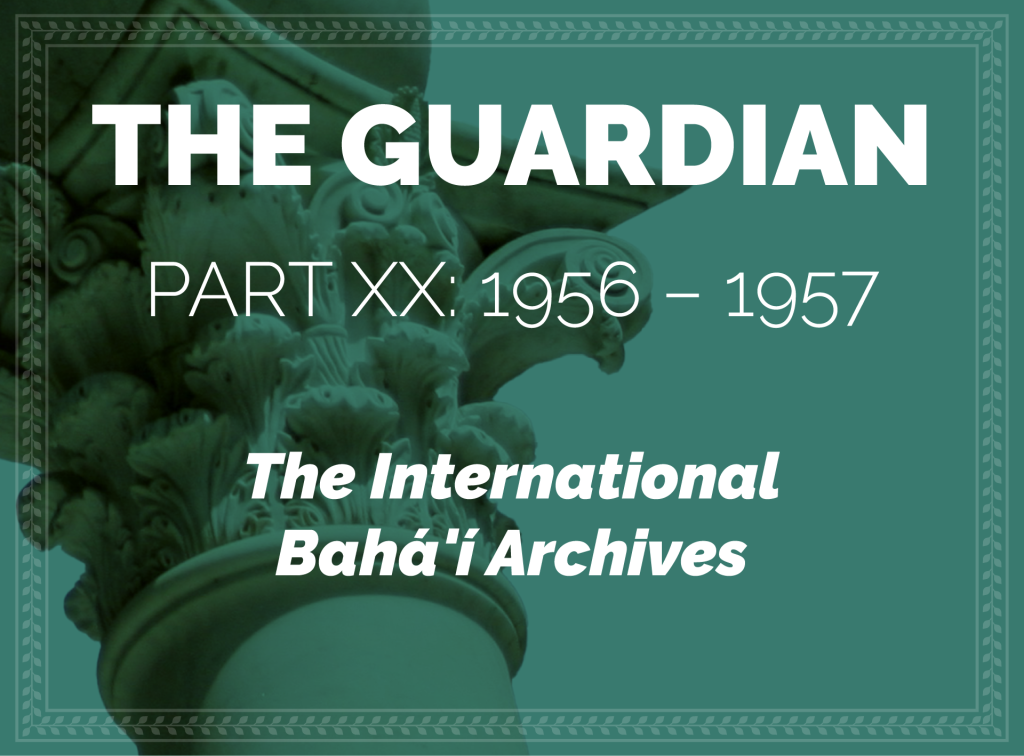
Written and illustrated by Violetta Zein
This part covers the life of Shoghi Effendi from the age of 59 in 1956 to the age of 60 in 1957.
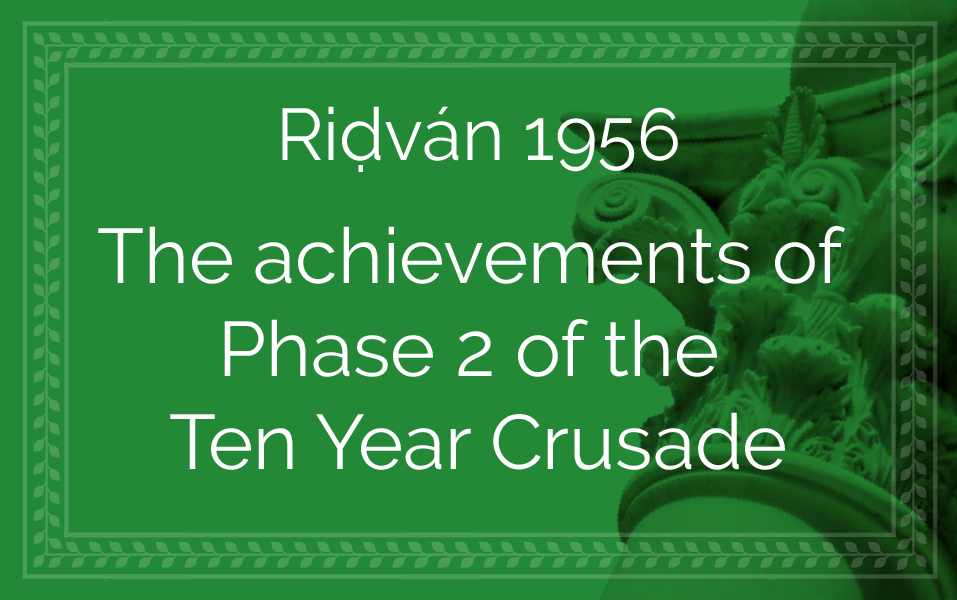
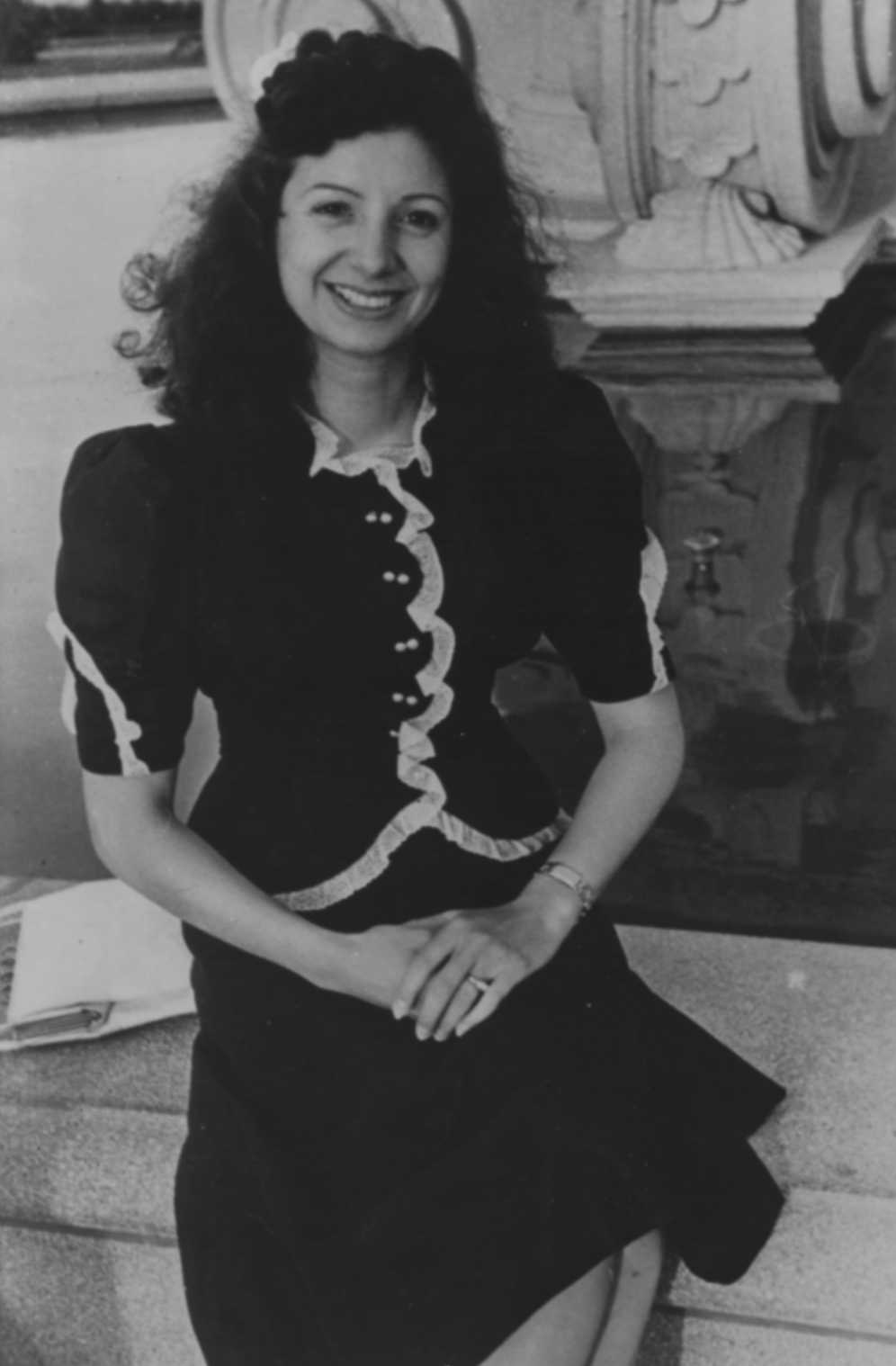
Gayle Woolson, member of the National Spiritual Assembly of South America. Source: Bahaimedia.
Gayle Woolson was born Gayle Abas in Crookston, Minnesota, to an Arabic-speaking Muslim family of Syrian descent. Her future husband, Clement Woolson, introduced her to the Faith. She became a Knight of Bahá'u'lláh for the Galapagos Islands and served as a National Spiritual Assembly and Auxiliary Board member.
When Gayle Woolson was on pilgrimage in Haifa on 16 February 1956, the Guardian spoke at length about effective teaching. He said the new Bahá'í had to develop spiritually, and arise to teach others, as it was happening in Africa.
The Guardian also warned the pilgrims that conversion should not be the goal of a Bahá'í teacher, but rather that they should teach with determination and patience, and never become discouraged if the progress was slow.
Speaking about attracting indigenous peoples to the Faith, the Guardian said:
Attract them through friendliness and kindness. Give them preference in everything; not only equality but preference, preferential treatment. Teaching the Indians [indigenous peoples] is very important…The Bahá'ís must treat them just the opposite of the way the others treat them. Amongst the Bahá'ís, the minorities in any country must be given preferential treatment. If there is a tie between two believers for anything, and one is of a minority group, there must not be a second vote. Preference must be given to the believer of the minority group.
Two years prior, Shoghi Effendi had told a pilgrim that there were three stages to the process of teaching the Faith to receptive souls:
- The first stage was attracting the people;
- The second stage was conversion to the Faith;
- The third stage was consecration: the new Bahá'ís arising to serve.
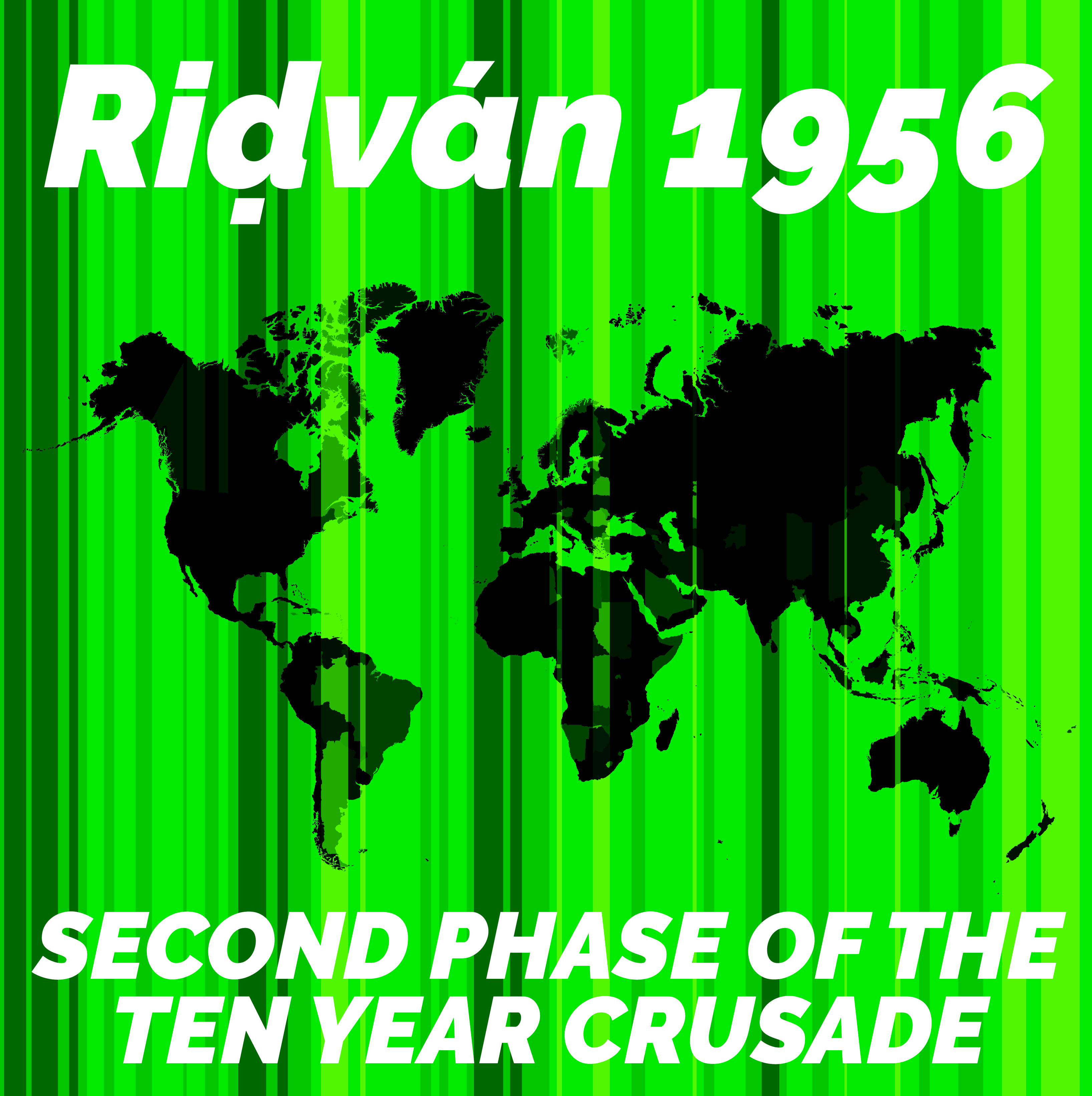
In his Riḍván message of 1956 the Guardian, as the Bahá'í world was entering into the third phase of the first five years in its world Crusade, highlighted the achievements attained by its band of heroes over the course of the two years since its inaugural phase:
- There were now 3,700 localities opened to the Faith over the surface of the entire planet
- 237 Sovereign States and Chief Dependencies where the Bahá'í Faith was present
- 900 Local Spiritual Assemblies
- All the countries listed as pioneering goals were now opened to the Faith except for those in the Soviet Union
- Over 70 islands in the Pacific, the Atlantic, and the Indian Oceans, were opened except for 6, bringing the total to 98 islands worldwide
- 40 territories were opened to the Faith in the Pacific, with 170 Bahá'í localities
- Bahá'í literature was now translated into 190 languages including 34 not included in the original plan
- In over 60 territories, the number of those who have become Bahá'ís has surpassed the number originally anticipated
- In a considerable proportion of these territories, Bahá'í membership has far exceeded the number required for the formation of local Assemblies, such as Gambia, for example, with 300 Bahá'ís
- There were 3,000 Bahá'ís in Africa
- 58 territories and islands were opened in Africa, with 400 Bahá'í localities
- 140 African tribes were now represented in the Bahá'í community
- 120 Local Spiritual Assemblies in Africa were functioning
- Bahá'í literature was now published in 50 African languages
- There were 43 National Ḥaẓíratu’l-Quds—National Bahá'í Centers
- 168 incorporated Local and National Spiritual Assemblies
- Land for 10 Temple Sites was acquired
- The value of National Bahá'í endowments in 51 countries exceeded $100,000—$1.1 million in today’s currence—and now included the Maxwell Home in Montreal
- The design for the House of Worship in Iran was approved
- Plans for three additional Houses of Worship in Europe, Africa, and Australia had begun
- In the Holy Land, the Covenant-breakers suffered defeat after defeat and Mírzá Majdi’d-Dín, the last survivor of the original Covenant-breakers from the time of 'Abdu'l-Bahá finally died
- In more positive news, 52 pillars of the International Bahá'í Archives had been raised and 450 tons of stone safely arrived in Haifa
- The contract was signed with the same factory in Utrecht who provided the golden tiles of the Shrine of the Báb for the green tiles of the Archives building
- The Monument Gardens were extended
- Several properties were acquired in Bahjí and on Mount Carmel
- The Temple Land on Mount Carmel was in the process of being purchased
- In the United States the Bahá'ís were invited by the San Francisco Council of Churches to attend a prayer meeting for the United Nations
- At this inter-religious gathering, the voice of the Bahá'í representative was the first to be raised, reciting a prayer revealed by Bahá'u'lláh
- A prayer revealed by `Abdu'l-Bahá for America was presented by the elected national representatives of the United States Bahá'í Community to President Eisenhower, who acknowledged its receipt in warm terms and above his own signature.
- A Bahá'í Publishing Trust was established in India
- 30 new centers and 15 assemblies were formed in India, Pakistan and Burma
- In Edirne, Bahá'ís were able to purchase sites blessed by the footsteps of Bahá'u'lláh
- The very first Bahá'í Summer School in Central Africa was held in Kobuka, Uganda, with 100 attendees
- The first All-France Teaching Conference was convened
- The Bahá'ís of Tripoli, Libya and the Capital of Tanganyika both identified plots to serve as future Bahá'í cemeteries
- In Iraq, the Bahá'ís purchased land for a Bahá'í Summer School in Iraq
- The women of Egypt were granted the right to be elected to the Egyptian National Spiritual Assembly and participate as delegates at National Convention
- In the Mentawai Islands, a plot of land was purchased supplementing the National Bahá'í Endowment of Indonesia
- The northernmost outpost of the Faith in Alaska was pushed beyond the Arctic Circle
- The Seychelles and the Sudan both initiated plans for the propagation of the Faith
- The worldwide Bahá'í communities appealed with over 1,000 messages to the United Nations after the massacres of the Bahá'ís in Iran in 1955, subjected to the severest persecutions in decades.
- The Bahá'ís also contacted the Sháh of Iran, Government, the Majlis and the Senate
- Publicity was given on radio, in the world’s leading newspapers, protests were voiced by scholars, statesmen, government envoys and people of eminence such as Pandit Nehru, Eleanor Roosevelt, Professor Gilbert Murray and Professor A. Toynbee,
- A written memorandum listing the atrocities was submitted to the Secretary General of the United Nations, who appointed a commission of United Nations officers, headed by the High Commissioner for Refugees, instructing its members to contact the Persian Foreign Minister and urge him to obtain from his government in Tihrán a formal assurance that the rights of the Bahá'í minority in that land would be protected.
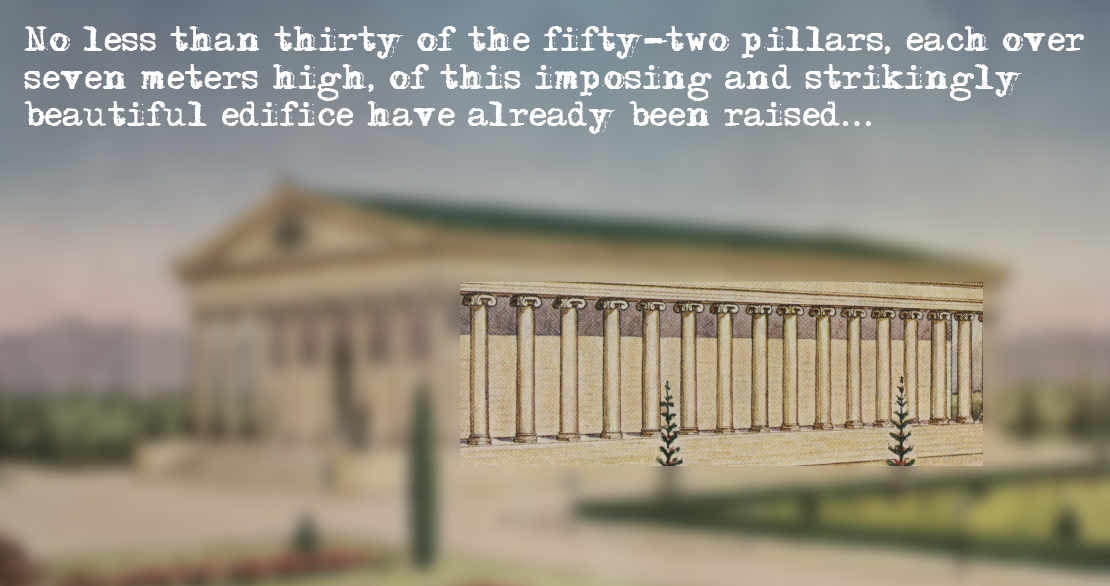
15 columns—half the Guardian’s achievement at this stage of construction—highlighted over the watercolor of the architectural drawing of the Archives. © United States National Bahá'í Archives, used with permission.
In his same Riḍván message of 21 April 1956, the Guardian linked the emergence of the International Bahá'í Archives, the first structure on the Arc, with the continued decline of the fortunes of the Covenant-breakers. He specifically referred to the disappearance "in miserable circumstances" of Mírzá Majdi’d-Dín, a notorious and particularly evil Covenant-breaker and the last survivor of the Covenant-breakers from the ministry of 'Abdu'l-Bahá, described by Shoghi Effendi as a "malignant" enemy of the Cause, even as the Archives was simultaneously rising from the ground in all its beauty.
The Guardian announced that 30 of the 52 pillars had been raised into position and that he had placed an order for 7,000 beautiful green tiles from the Utrecht factory in the Netherlands that had produced the golden tiles of the superstructure of the Shrine of the Báb:
…on the other, through the laying of the foundation, and the erection of some of the pillars, of the facade and of the northern side of the International Bahá'í Archives—the first of the major edifices destined to constitute the seat of the World Bahá'í Administrative Center to be established on Mt. Carmel. No less than thirty of the fifty-two pillars, each over seven meters high, of this imposing and strikingly beautiful edifice have already been raised, whilst half of the nine hundred tons of stone ordered in Italy for its construction have already been safely delivered at the Port of Haifa. A contract, moreover, for over fifteen thousand dollars has been placed with a tile factory in Utrecht for the manufacture of over seven thousand green tiles designed to cover the five hundred square meters of the roof of the building.
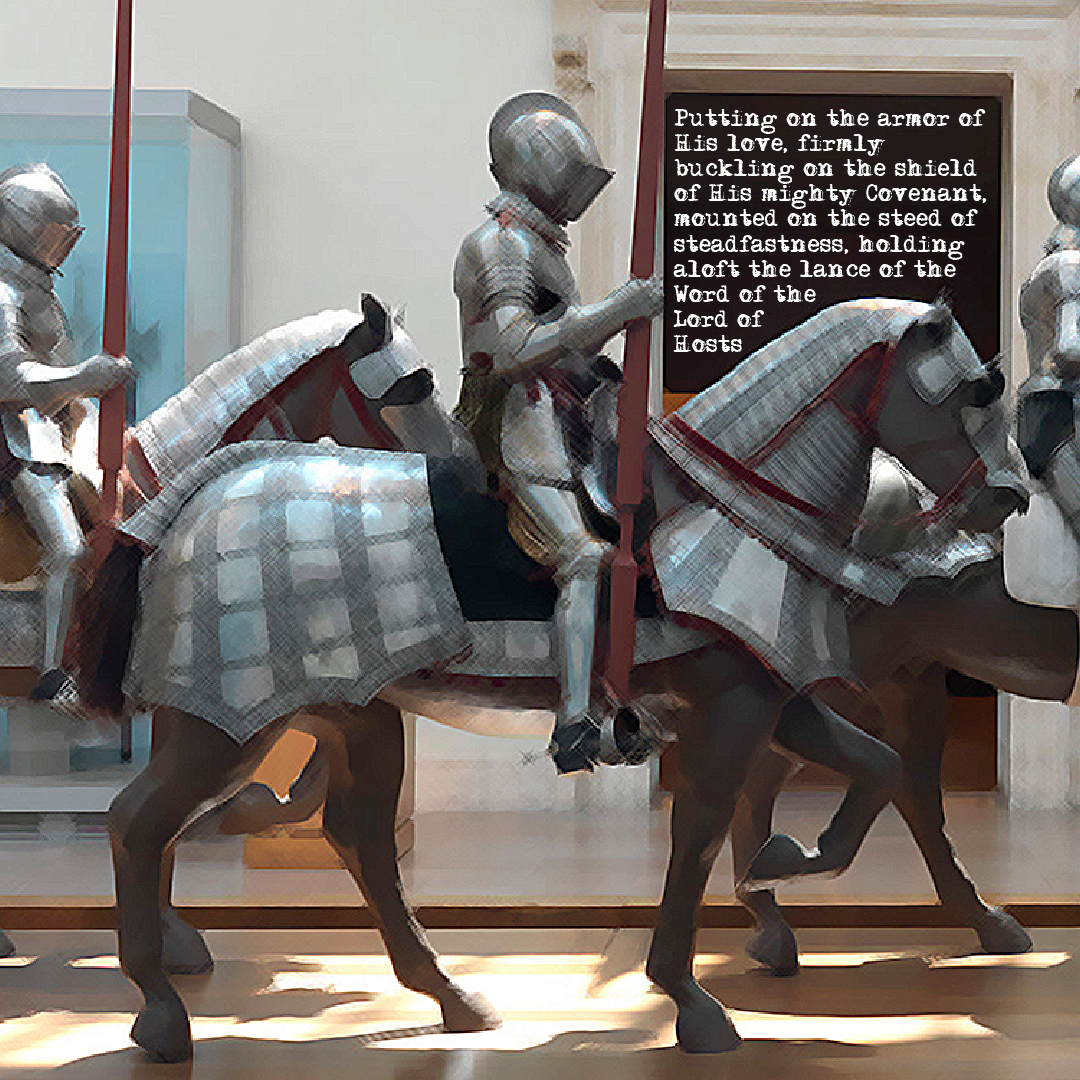
“Putting on the armor of His love, firmly buckling on the shield of His mighty Covenant, mounted on the steed of steadfastness, holding aloft the lance of the Word of the Lord of Hosts” Photograph of The Metropolitan Museum of Art exhibit showing knights mounted on armored horses, holding aloft a lance, and protected by shields. Source: The Met.
The Guardian’s Riḍván 1956 message ends with the announcement of “a major turning point in the history of [the] marvelous unfoldment [of the Ten Year Crusade].” Paying tribute to the three years of magnificent exploits achieved by the Bahá'í community, with “a spirit of abnegation and self-sacrifice, so rare that only the spirit of the Dawn-breakers of a former age can be said to have surpassed it,” remembering the fallen heroes and the martyrs of the first two phases of these first five years, the Guardian could already discern the approaching age of entry by troops during the Ten Year Crusade:
Premonitory signs can already be discerned in far-off regions heralding the approach of the day when troops will flock to its standard, fulfilling the predictions uttered long ago by the Supreme Captain of its forces.
Referring to the Bahá'ís as “warriors enlisting under its banner” the Guardian raised their awareness of the work yet to be done, “fields of exploration and consolidation of such vastness as might well dazzle the eyes and strike awe into the heart of any soul less robust than those who have arisen to identify themselves with its Cause. The heights its champions must scale are indeed formidable. The pitfalls that bestrew their path are still numerous. The road leading to ultimate and total victory is tortuous, stony and narrow.”
But the Bahá'ís should never discourage, as Bahá'u'lláh assured them:
Whosoever ariseth to aid our Cause God will render him victorious over ten times ten thousand souls, and, should he wax in his love for Me, him will We cause to triumph over all that is in heaven and all that is on earth.
The last paragraph of the Guardian’s Riḍván 1956 is pure poetry, spurring on his spiritual army in the field to attain ultimate victory and never lose confidence:
Putting on the armor of His love, firmly buckling on the shield of His mighty Covenant, mounted on the steed of steadfastness, holding aloft the lance of the Word of the Lord of Hosts, and with unquestioning reliance on His promises as the best provision for their journey, let them set their faces towards those fields that still remain unexplored and direct their steps to those goals that are as yet unattained, assured that He Who has led them to achieve such triumphs, and to store up such prizes in His Kingdom, will continue to assist them in enriching their spiritual birthright to a degree that no finite mind can imagine or human heart perceive.

Leroy Ioas’ nephew Charles Ioas, Knight of Bahá'u'lláh to the Balearic Islands. Source: Bahaimedia. Background: A photo of Menorca, one of the Balearic Islands by Reiseuhu on Unsplash.
The Guardian's heart was with the pioneers, with those serving out on the front lines. He gloried more in their achievements than in anything else. Even at the Bahá'í World Centre, there were ties with the Crusade: Three of Leroy Ioas’ family members rose to the rank of Knight of Bahá'u'lláh: his nieces Margery Ullrich Kellberg in the Dutch West Indies, Florence Ullrich Kelley in Monaco, and his nephew Charles Ioas in the Balearic Islands.
The Guardian was inextricably tied to the Ten Year Crusade, he was a part of it, more so than the Knights of Bahá'u'lláh, it was the accomplishment in the most glorious form of the yearning of his Beloved Grandfather 'Abdu'l-Bahá in his majestic Tablets of the Divine Plan. What affected the Ten Year Crusade, affected the Guardian personally, Whenever he learned of difficulties that befell a pioneer he was depressed and saddened. When news of the Knights of Bahá'u'lláh’s and pioneers’ successes came to the Guardian, he was joyful. If they were forced to leave their pioneering posts, he was grieved.
The staff at the Bahá'í World Centre formed a unity with their Guardian, and they felt his emotions. When the Guardian was affected, everyone was affected. If he was sad, everyone was sad, if he was happy, everyone was joyful.
In a Riḍván message written by the Hands of the Cause during the Ministry of the Custodians after the Guardian’s passing, they wrote:
It is not possible for us to describe the wistful sadness and the look of concern and care that would pass over his blessed face when he received news that a goal had had to be abandoned and was lacking a pioneer.

“I’ll cross the other one off later.” Background image by Clay Banks on Unsplash.
Rúḥíyyih Khánum remembered a particularly poignant, heartbreaking moment that shows how sensitive the Guardian was when it came to losses during the World Crusade. On the same day, Shoghi Effendi received news that three pioneers had to abandon their post. Rúḥíyyih Khánum watched as the Guardian reluctantly crossed off two of their names in one of his little black notebooks, which he carried with him at all times. Later, Rúḥíyyih Khánum said to Shoghi Effendi:
Shoghi Effendi, you only crossed off two names.
Shoghi Effendi replied:
Yes, I’ll cross the other one off later.
The Guardian could not bring himself to cross off all three names at once.

“If we had let him go home he would not have won those victories.” Background image of Fiji, a Pacific island by Janis Rozenfelds on Unsplash.
One pioneer who went to an island in the Pacific and became extremely discouraged. He faced failure and opposition: he could not find a job, no one wanted to listen to what he had to say, the local clergy opposed him, and he was persecuted by the government. He asked the Guardian for permission to leave his post and the Guardian asked Leroy Ioas to write back, encouraging him to persevere, promising him that “every seed would ripen.”
Some time later, the man wrote again asking to leave, and the Guardian responded again that he should persevere.
The man wrote a third time, describing his dire financial situation and the Guardian said it should be arranged with his National Spiritual Assembly for him to be able to remain at his post.
Several months later, the Guardian arrived at dinner beaming with joy and said:
We have some wonderful cables today.
He shared a cable from this same pioneer: not only had he succeeded in enrolling 50 people into the Faith, but he had formed two Local Spiritual Assemblies. The Guardian said:
If we had let him go home he would not have won those victories.
Leroy Ioas remarked:
Well, Shoghi Effendi, I said, of course this pioneer, he did the work, but it’s the Guardian that actually won this victory. You’re the one that won it, because if it hadn’t been for you, he’d have left.
The Guardian said:
Leroy, he said, that is correct, I won those victories; I won them…I have to stay in the Holy Land. This is my seat of operation. The friends must do the work. And I tell you that if the friends would do what I had told them to do, and if they would follow my instructions, they would be amazed at the victories which I will win through them.
Leroy was amazed at the Guardian's response—he was speaking not just to the Bahá'ís seated at the dinner table, but to all Bahá'ís, worldwide. The Guardian acknowledged this and said:
Only years later did Leroy realize the full import of this answer, when the spirit of the Guardian was released from its physical confines and could work far more powerfully than when he was in this world.
When the Bahá'ís were winning great victories in the second half of the Ten Year Crusade, after the passing of the Guardian, Leroy Ioas once said:
Let me tell you, these extraordinary victories that are being won (in the second half of the Crusade) - Shoghi Effendi is winning them. His spirit is influencing anyone who becomes a proper vehicle for him to work through.

“I felt as if he were like a great powerful locomotive.” Steam locomotive background image by Pixabay on Pexels.
In 1956 a pilgrim, whose name we do not know, wrote her impressions of the Guardian which Rúḥíyyih Khánum found not only shrewd but accurate. This woman was a peerless judge of character, and found that Shoghi Effendi, who was at the time nearly 60 years old, looked like was just 48. She began by giving a beautiful and very detailed physical description of him:
His face is beautiful, as it is so pure in expression and so impersonal, yet at the same time tender and majestic...His nose is a combination of what it was in the pictures of him as a little boy - he still looks much like that! - and the sort of ridged nose of the Master…He had a small, greying moustache, tightly clipped. His mouth is firm and pure, his teeth white and beautiful. His smile is a precious bounty...
He is completely simple and direct. He himself does not demand all this deference, but just to be in his presence makes one feel absolutely “weak and lowly”. The Guardian is ever courteous and does not lose patience with questions of the immature. However, he is not reticent about letting people know which questions are important, and which are not, and which will be answered later by the International House of Justice…
This pilgrim saw the weight that Shoghi Effendi carried simply but majestically, as a king, his range of vision, extending infinitely further than any mere human could foresee, and his resistless march towards victory, sweeping along in his energy the entire community of believers:
I felt as if he were like a great powerful locomotive, pulling behind him a long, long string of cars, laden—not with dead-weight exactly—but sometimes pretty dead! This weight is the believers who have to be pushed, or pulled, or cajoled, or praised at every moment to get them into action. The beloved Guardian sees far in advance the needs, the lack of time, the obstacles and problems. He is actually hauling us all along behind his guiding and powerful light. Like a locomotive too—he can go straight ahead, fast or slow down, but he CANNOT deviate his course, he MUST follow the track which is his divine Guidance. He gives one the sense of being a perfect instrument—very impersonal, but hypersensitive to every thought, or atmosphere. He cannot be swayed in his thought. He is not influenced in the least by friendship, preference, money, hurting or not hurting feelings. He is absolutely above all that...
Perhaps the most heartbreaking comment this insightful pilgrim makes is how the Bahá'ís have not protected Shoghi Effendi as 'Abdu'l-Bahá had asked them in His Will and Testament, the suffering he has endured both at the hands of Covenant-breakers, but also at the hands of disobedient or careless Bahá'ís:
Alas, Shoghi Effendi's “radiant nature” has all too often been clouded over and saddened by the unwisdom of the friends, or their flagrant disobedience, or disregard of his instructions. Frantically one wonders who has not failed him in one way or another!

Shoghi Effendi in April 1957, standing in the garden gate of the House of the Master. He was directing the placing of the coffin of Isfandiyar—'Abdu'l-Bahá’s faithful servant and carriage driver—in the funeral cortege that was about to leave for the Bahá'í cemetery. Source: Bahaimedia.
After the thirty-fifth anniversary of the Ascension of 'Abdu'l-Bahá, Shoghi Effendi repeated many times to Rúḥíyyih Khánum:
Do you realize I have been carrying this load thirty-six years? I am tired, tired!
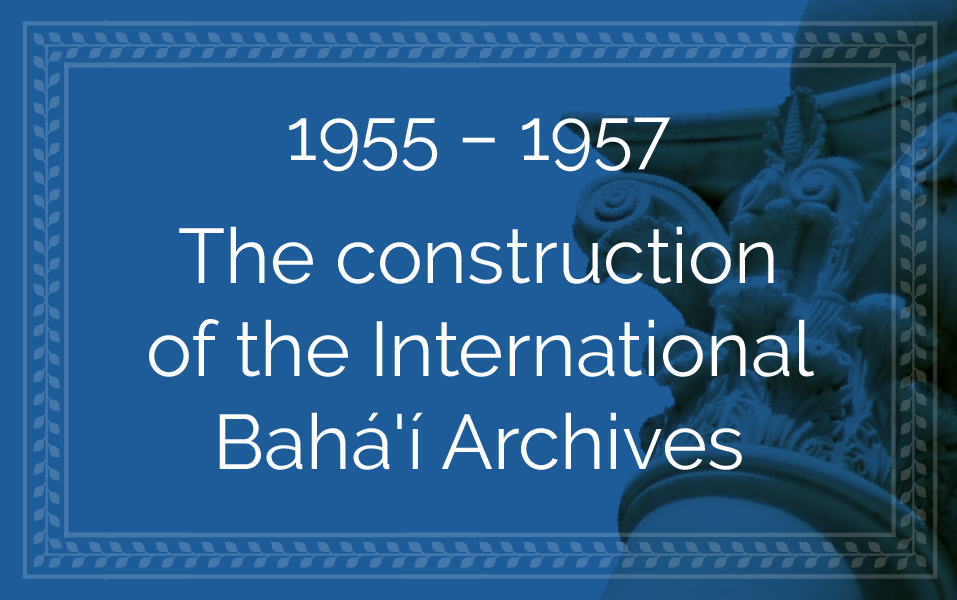
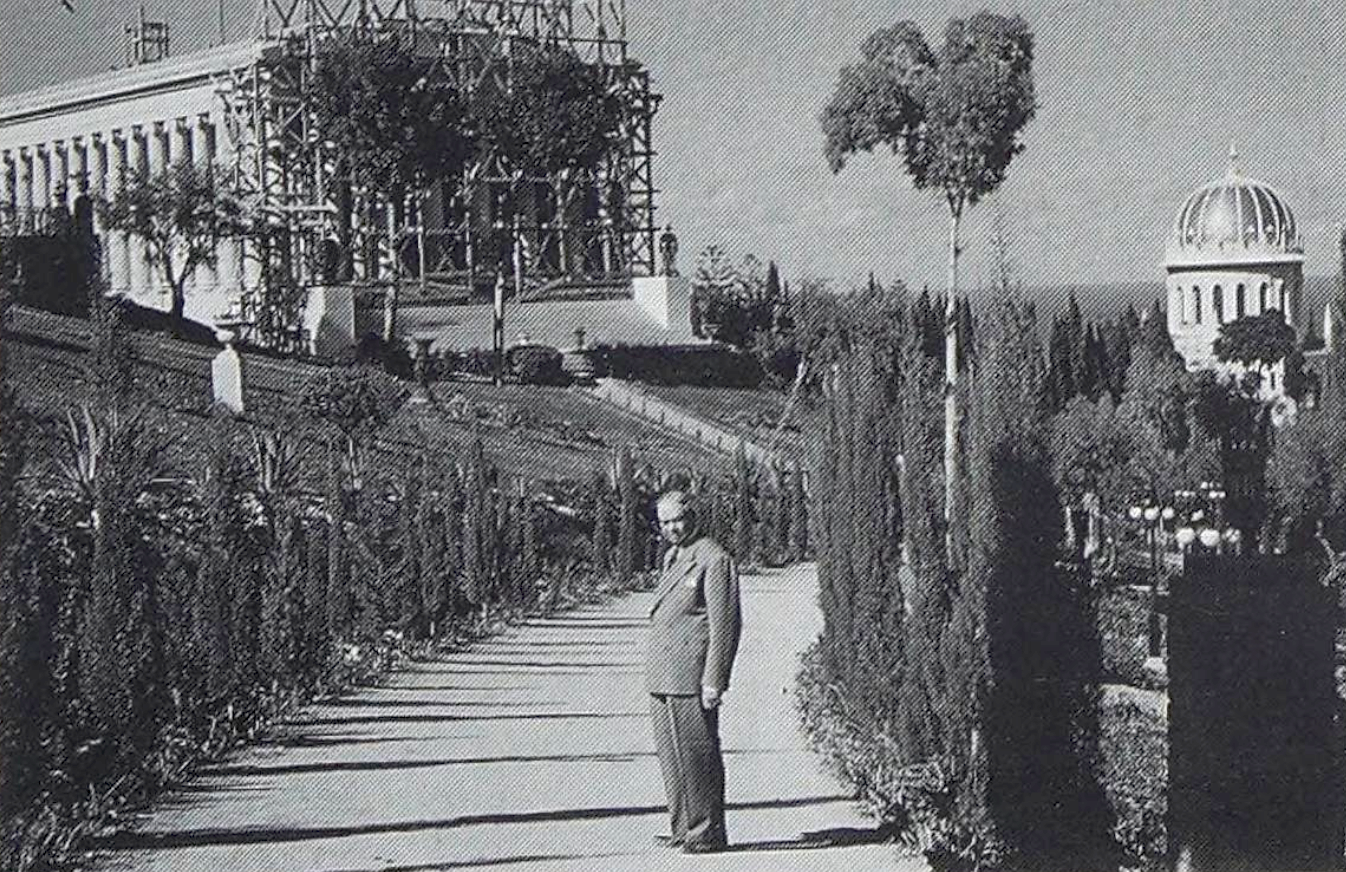
Hand of the Cause Leroy Ioas on the path leading to the International Bahá'í Archives. Source: Bahaimedia.
The Guardian informed Leroy Ioas, who was to supervise the work locally—as Ugo Giachery was supervising the other part of it in Italy—that the building would have to be built from the rear—where it backed into the mountain—fitting the front into the gardens that already surrounded it, for practically its full length on all three sides, leaving only about five meters’ leeway for the construction workers to maneuver in!
The Guardian oversaw the building project of the International Bahá'í Archives as Leroy Ioas was the project manager, and Abu Khalil—who was doing masterful work on the Shrine of the Báb—was the mason, but it is fair to say that the Guardian personally handled the entire project with his characteristic originality, his independent nature and his steely determination to get everything done as efficiently as possible.
The process was incredibly complicated: the International Bahá'í Archives was on a sloping hill, not on level terrain, all 52 columns were in three segments, a total of 156 pieces that had to be perfectly slotted into each other for the effect to be perfect, and Shoghi Effendi needed Leroy Ioas to build the Archives from the rear, where it backed into the mountain.
Every hurdle was overcome thanks to Leroy Ioas’s strength and ingenuity in Haifa, and Ugo Giachery’s brilliant problem-solving capacities, diplomatic and lovable nature, and his attention to detail. But the work was deeply taxing on the two Hands of the Cause, and it exhausted them to their physical limits.
Leroy Ioas was very hands-on. One day, the young nephew of Hand of the Cause Ṭaráẓu'lláh Samandarí was watching the construction and noticed the head mason and his men were working on a problem and Leroy Ioas went over to demonstrate to them how it should be done. Ṭaráẓu'lláh Samandarí’s nephew mentioned to the Guardian that the mason couldn’t fix the problem but the Hand of the Cause could, and Shoghi Effendi humorously responded:
Yes, Mr. Ioas is the invisible hand of God.
The Guardian’s response, spoken in Persian is a reference to a Muslim Ḥadíth according to which the solution to an insolvable problem is the “invisible hand of God.”

Images of the crates containing the marble, Ugo Giachery with the captain of the SS Nakhon—the ship which brought them from Italy—the unloading of the crates. All photographs from Bahaimedia: The construction of the International Bahá'í Archives. Background photograph: Front view of Archives Building, September 1956. Source: Bahaimedia.
On 12 August 1955, seven months after the initial contracts were signed in Rome in January 1955, the first shipment of 100 tons of Chiampo Paglierino marble arrived in Haifa from Trieste on the S.S. Nakhson. More than 800 tons of stone were to follow during a period of a year and a half.
The next month, in September 1955, Leroy Ioas wrote to Hand of the Cause Amelia Collins:
We are working strenuously on the Archives building. At every turn there has been problem after problem but it forges ahead, and some think we are making good progress. Ugo thinks it is miraculous. The marble work on the north podium is being completed. Next will come the marble steps and then the other sections of the podium, before we can begin to set in place the fifty-two marble columns.
Among the many problems that Leroy Ioas was facing, some tested his patience to its very limits. In order to shore up the Archives building, the Guardian had ordered a huge quantity of material from the city, but the workers dumped the materials in the wrong place at the building site. Leroy Ioas was furious. His standards were exacting for all workers, Bahá'ís and Israelis.
In December 1955, the first magnificent Ionic column was placed into position on the north-east corner of the podium, facing east toward the Shrine of Bahá'u'lláh.
The contract for the roof tiles was signed on 6 June 1956 with the same Dutch firm in Utrecht.
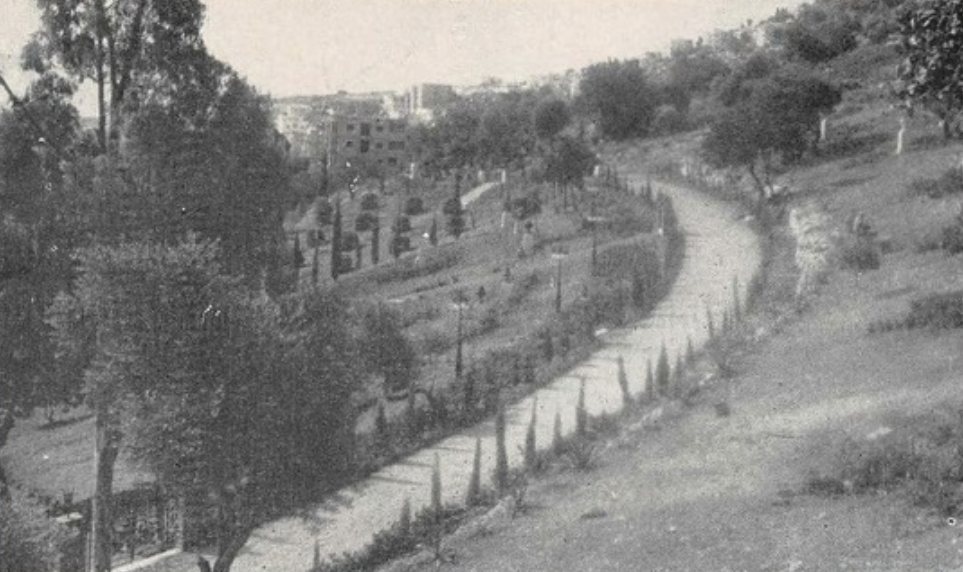
The curved path or "arc" in front of the International Archives Building being constructed on Mount Carmel. Bahá'í News Issue 297, page 4.
Perhaps the greatest feat of genius of the Guardian in the innovative, fresh approach he had to constructing buildings was that he first planted gardens before the marble from Italy had even arrived and before he laid the foundation. Two years before construction began, the Guardian began planting laying out paths—with twine and pickets—as well as borders, hedges and trees on three sides of the building area.
Thanks to the Guardian’s visionary innovation, two years later, when the International Bahá'í Archives were completed, the gardens were fully mature and the stunning edifice looked as if it had been there for years—and not, as it was, just completed.
The reason the Guardian did this was because he could not bear such a masterpiece of a building to be completed surrounded by gravel and barren land. But building around a completed garden was not particularly easy for the engineers and workers. The Guardian did not care, he once even expressed his aesthetic philosophy this way:
I will always sacrifice utility to beauty.
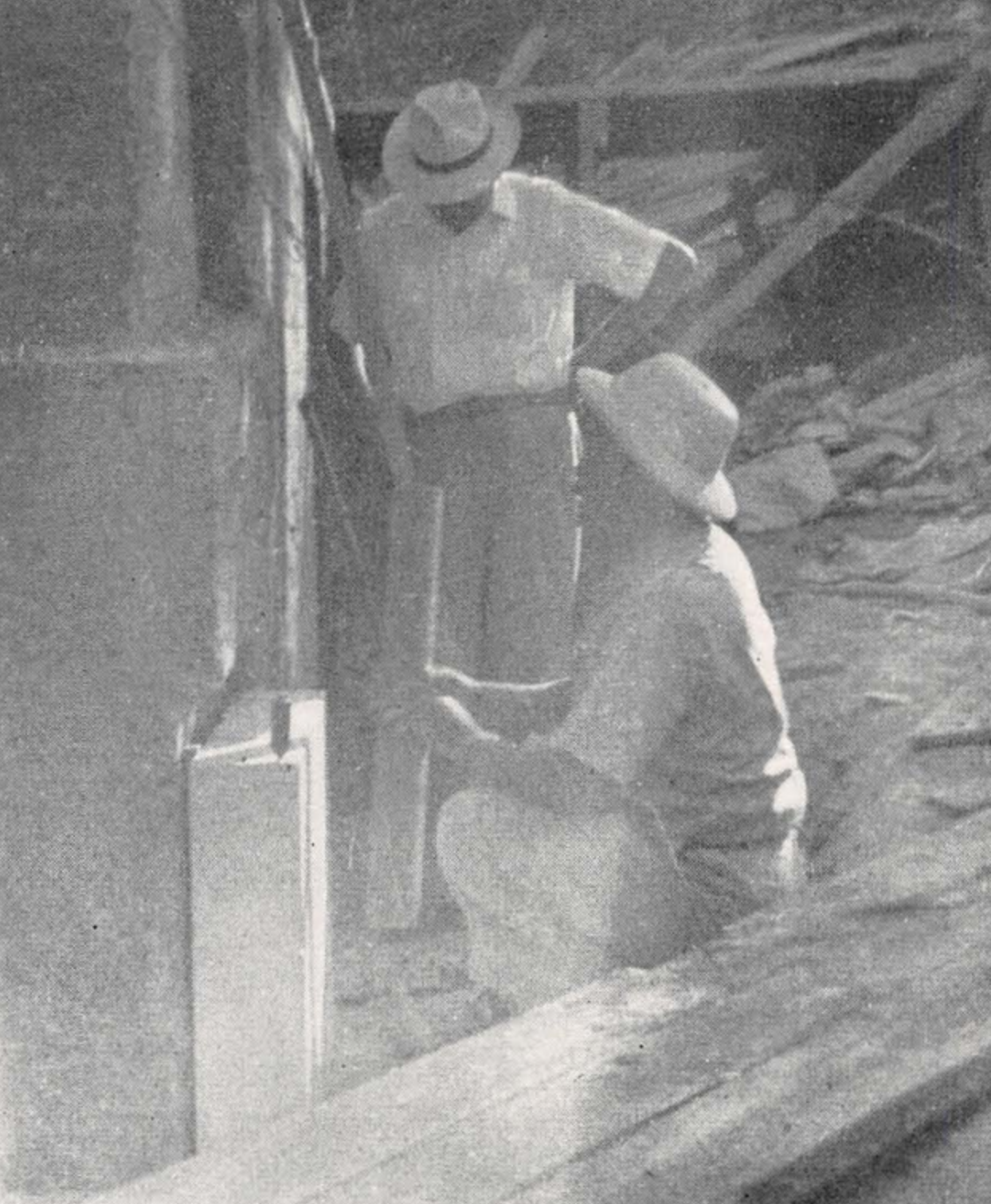
Leroy Ioas and head mason with the first stone in place. Source: Bahaimedia.
Leroy Ioas was indispensable to the Guardian who once said he did not know what he would have done without Leroy Ioas, and that once he gave something to Leroy Ioas to do, he never again worried about it, because he knew Leroy Ioas would handle it perfectly, with his characteristic energy and attention to detail.
From the moment he had arrived in Haifa on 10 Marcy 1952, he had been working at a vertiginous pace. He was the Secretary of the Guardian, the Secretary-General of the International Bahá'í Council, he had assisted with the completion of the superstructure of the Shrine of the Báb, he had traveled for the Guardian, bought dozens of tracts of land for the Faith, established the Israel Branches of National Spiritual Assemblies, he was the Guardian’s liaison with the Government of Israel.
Leroy Ioas’s work from 1952 to 1955 was, of course, enough to run anyone into the ground, but that was just the physical strain of his work responsibilities. Perhaps the element that was most difficult and painful for Leroy Ioas was the human, emotional element. For three years, he had been working on intense responsibilities while navigating the delicate balance between western and eastern culture with which he was deeply unfamiliar—Leroy Ioas had never left the United States before arriving in Haifa in 1952—the Israelis’ natural abrasiveness, an endearing quality but one he had no experience with, not to mention having to deal with Covenant-breakers over and over again while he was purchasing land for the Guardian.
After two years of this demanding routine, and ignoring his body’s warning signs, shoving his fatigue to the side, and generally increasing the intensity of his activities, Leroy Ioas had put a severe strain on his heart. Though he never suffered a heart attack, he had neglected the warning signs until his heart was permanently damaged. From 1955 onwards, he would not be able to work at the same pace as he had before.
When the Guardian heard, he insisted that Leroy Ioas leave the Bahá'í World Centre for an entire month and do absolutely nothing. This is wonderful, because whenever Rúḥíyyih Khánum found the Guardian in a state of absolute exhaustion and begged him to rest, Shoghi Effendi never would. But now, it was him giving his chief lieutenant advice he never heeded!
This happened during the Ten Year Crusade and Leroy Ioas asked the Guardian to basically pioneer to Europe where he could establish a community and deepen Bahá'ís. The Guardian said, in essence, absolutely not. He wanted Leroy Ioas to rest.
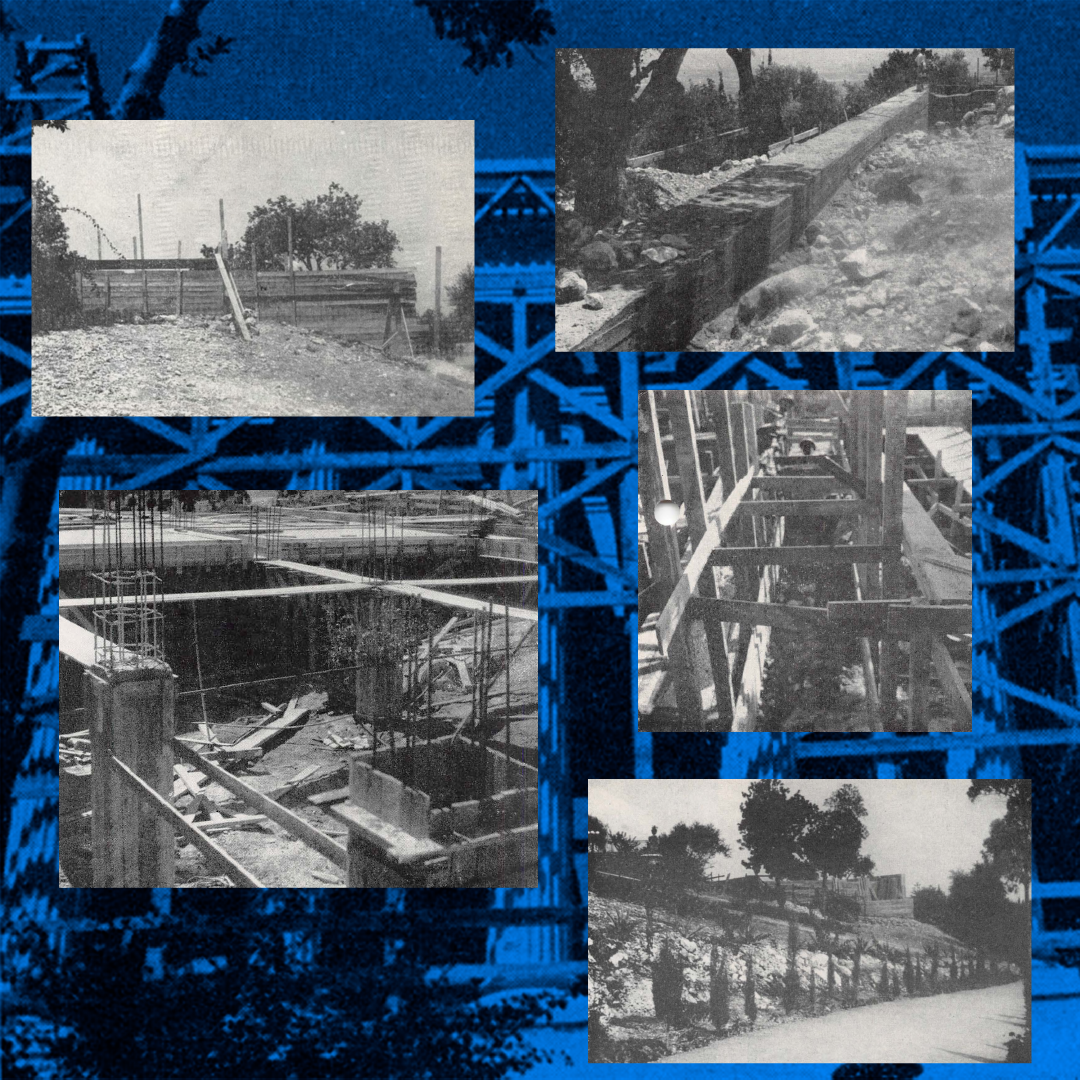
The early stages of construction the process of the International Bahá'í Archives showing the foundations and retaining walls. All photographs from Bahaimedia: The construction of the International Bahá'í Archives. Background photograph: Front view of Archives Building, September 1956. Source: Bahaimedia.
In his Riḍván message of 1955 to the Bahá'ís of the world, Shoghi Effendi updated the believers and the institutions on the progress made in the construction of the International Bahá'í Archives, explaining the expropriation process, the fixing of the position of the Arc, the field measurements for the exact position of the Archives building, the contract signed in Italy for the Chiampo Paglierino marble, and their expected date of arrival:
Following the expropriation by the Israeli Finance Minister, on the recommendation of the Mayor of the City of Haifa, of the plot adjoining the site of the future International Bahá'í Archives on Mt. Carmel, the fixing of the position of the far-flung arc, around which the edifices constituting the Seat of the World Bahá'í Administrative Order are to be built, the location of the site of the building and the preparations for the excavation of its foundations, a hundred and twelve thousand dollar contract has been signed in Rome for the quarrying, the dressing and carving of the stones and the fifty-two columns of the building which will amount in weight to over nine hundred tons and are to be shipped within less than two years to the Holy Land.
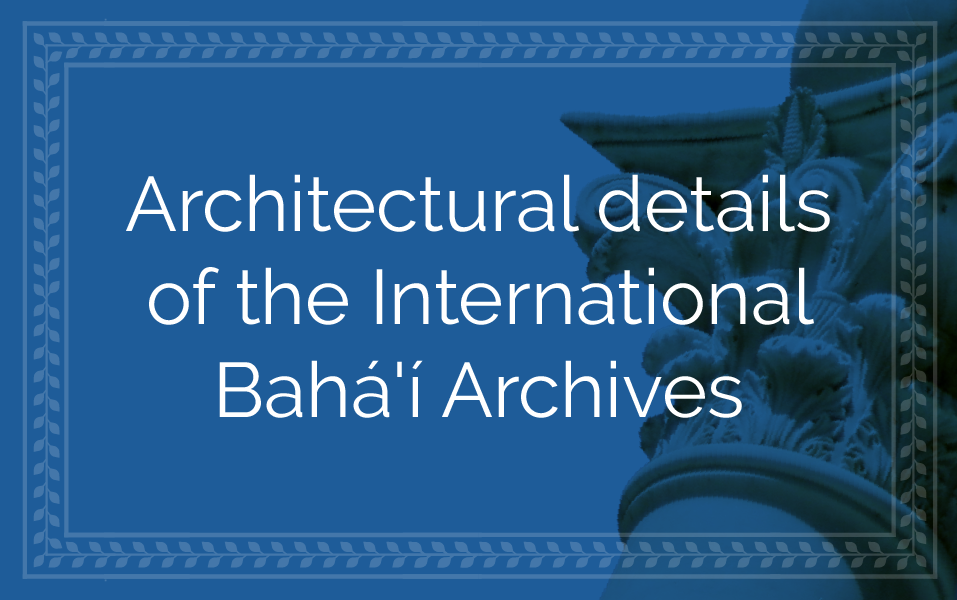
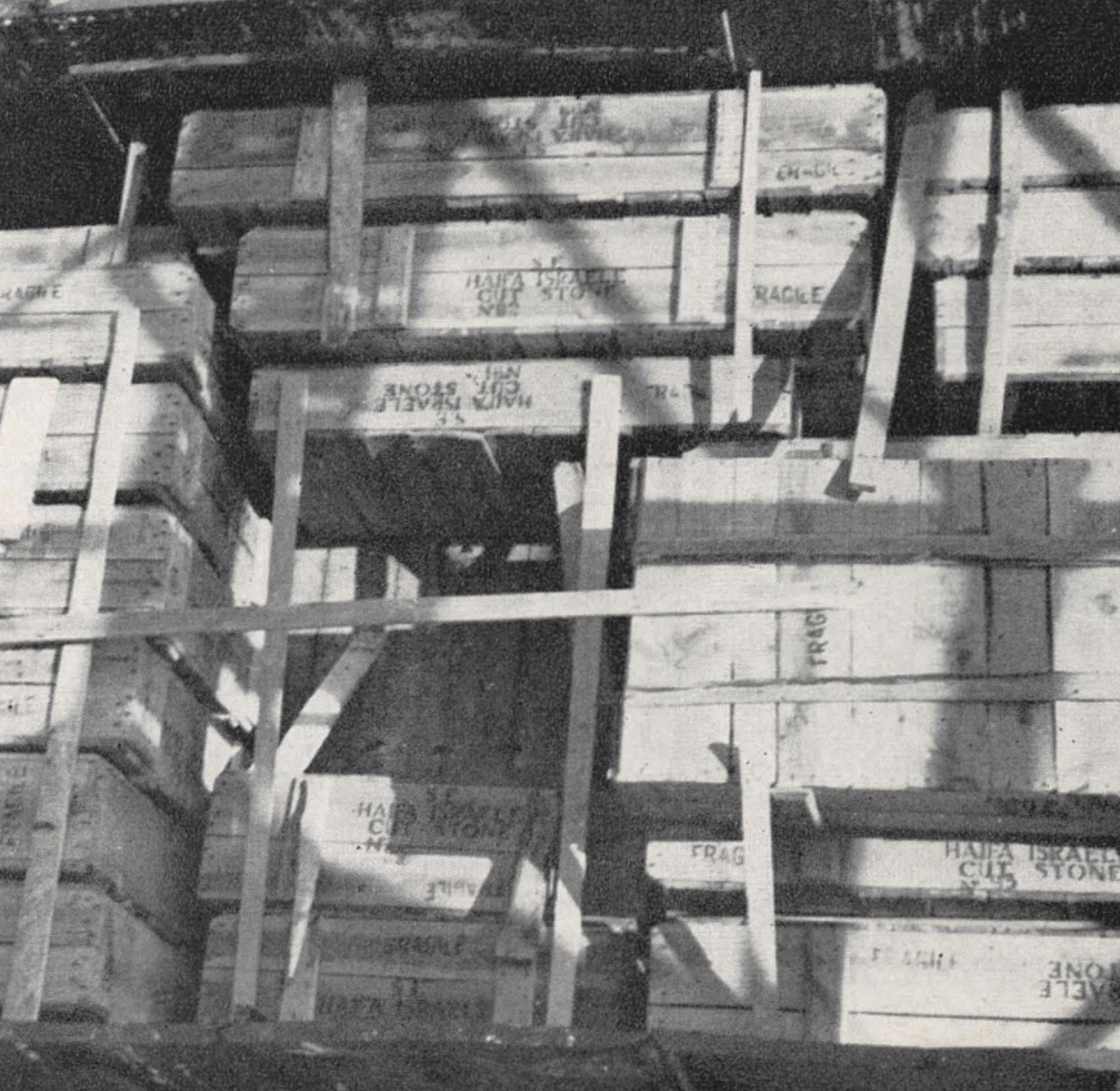
Crates of material for the Archives building on train cart in 1955. Source: Bahaimedia.
Hundreds of tons of marble were needed for the International Bahá'í Archives’ 52 seven-meter columns which formed the colonnade of the Archives, but because Shoghi Effendi needed finished stone blocks of the same shade and Chiampo Paglierino marble was found in veins of varying shades, three times as much marble had to be excavated.
The 7-meter columns could not be single blocks because they would have been impossible to ship. The stonemasons cut all the columns into three parts—weighing 2 metric tons each, ready for shipping.
As with his first experience collaborating with Italian professionals in the course of constructing the superstructure of the Shrine of the Báb, the Guardian was very salified with the level of professionalism exhibited by the Italian team. A veritable little army was working on the Guardian’s materials for the International Bahá'í Archives: miners, sculptors, artisans, draftsmen, and architects, each and every one of them of the highest caliber in their field and eager to produce their best work for Shoghi Effendi.
The marble was carefully packed, and all the crates were touchingly respectively marked “S.E.” (“Sua Eminenza”: “His Eminence”), referring to the Guardian. The crates were first shipped by train in 8 railroad cars to Trieste, then loaded onto ships bound for Haifa. It took 17 ships to transport the 1,000 tons of carved Chiampo Paglierino marble.
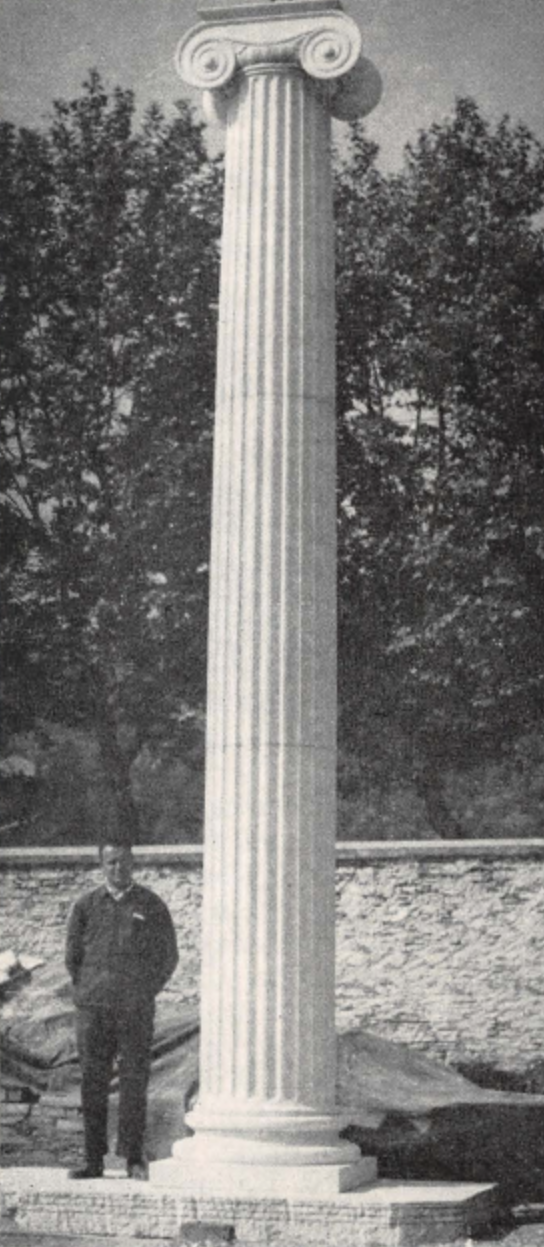
As had been the case for the fabrication of the marble and granite for the superstructure of the Shrine of the Báb, a veritable army of draughtsman, modelers, stonecutters and sculptors was mobilized, while miners in the quarries of Zanconato and Nicolato in the territory of Chiampo were wresting from the bowels of the earth hundreds and hundreds of tons of marble in huge blocks—an arduous and meticulous job. Only the most perfect marble was selected from the abundant yield of the quarries.
When Ugo Giachery witnessed the first completed column erected in his presence in the yard of the Chiampo workshop, he could not believe his eyes. The flawlessness of the Guardian’s design was standing before him in all its beauty and perfection! The workers stood around, watching Ugo’s expression—a mixture of pure joy and awe—and waiting for a word of praise.
Then, Ugo Giachery snapped out of his dreamlike state, and shook all the workers’ hands, warmly congratulating everyone, thinking to himself how the Guardian would feel when he saw the first column raised on Mount Carmel.

The first capital, "Ionic style", completed at Chiampo, Italy , on April 19, 1955, one of the 50 capitals required for the Baha'i International Archives Building on Mount Carmel. Each capital weighed 1 ton. Source: Bahaimedia.

Balustrade for balconies of the Archives Building, 1957. Source: Bahaimedia.
Shoghi Effendi had found a beautiful example of wooden balustrades in one of William Sutherland Maxwell’s books, designed by the famous 16th century Italian architect, Palladio, for the villa “La Rotunda”, near Vicenza.
The Guardian instructed Ugo Giachery to build a perfect replica of this balustrade, and Ugo Giachery immediately left for Vicenza with Professor Rocca to study the original in great detail.
They took careful measurements and made several drawings, both of which were a great help to Saiello Saielli of Pistoia, who had built the exquisite door to the Shrine of Bahá'u'lláh five years earlier in 1957, and would also build the door to the International Bahá'í Archives.
Saiello Saielli chose the most perfect oak, absolutely uniform in tint and texture, then incorporated a variety of ingenious details to make the balustrade as solid and as safe as he could. After this, Saielli spent many months, skillfully and enthusiastically reproducing La Rotunda’s wooden balustrade for Shoghi Effendi, and his final work, as usually was stunning, and a priceless addition to the interior of the Archives.
When Saiello’s completed masterpiece reached Haifa and the balustrades were placed on the upper level balconies, Shoghi Effendi was incredibly pleased and highly praised their beauty and workmanship.

A view of the International Bahá'í Archives at night, with the two torch-holders on either side of the stairs clearly visible. Source: Bahá'í Media Bank, © Bahá'í International Community 2023.
Initially, the Guardian had wanted to place a large marble eagle on each side of the platform of the main entrance staircase, but he abandoned that idea in favor of two beautiful wrought-iron torch holders converted to electricity, a luminous and friendly welcome for all pilgrims. The simulated glass flames were specially made in the world-famous glass capital of Murano, Venice, Italy.
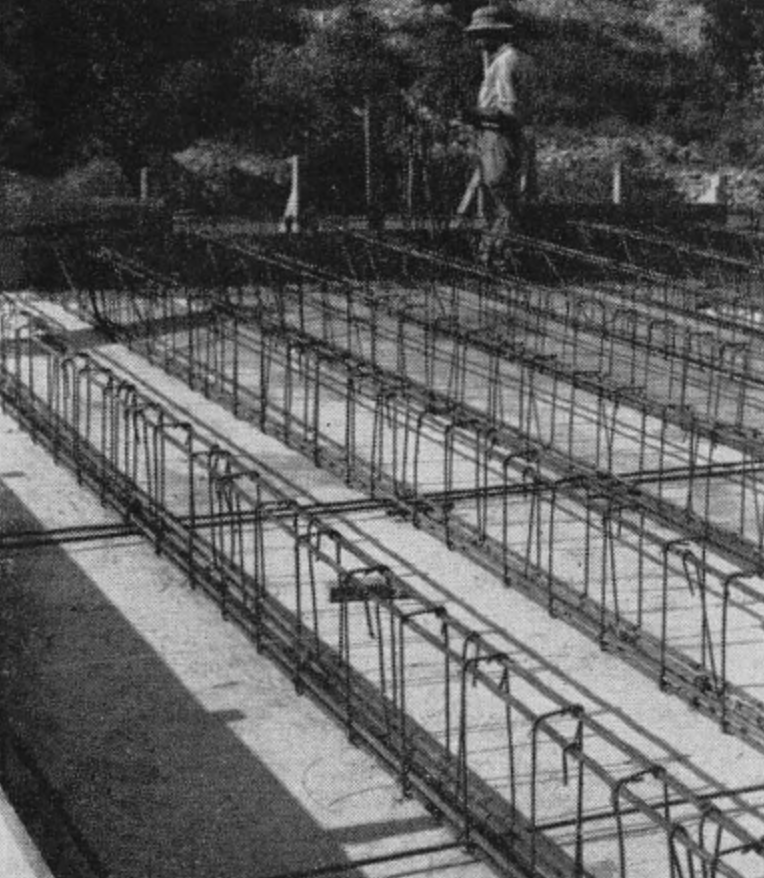
Steel beams carrying the weight of the ceiling of the Auditorium of the Baha'i International Archives Building, Haifa. The Auditorium is 10 meters wide by 24 meters long. Thirty beams each 50 centimeters high support the ceiling. Source: Bahaimedia.
The beautiful grilled inner vestibule door was a duplicate of an ancient Greco-Roman bronze door that Shoghi Effendi loved, and which perfectly fit the style of the building. The iron frame for the window and the bronze grilled door of the vestibule were made in Sarzana, Italy, by the firm of Malatesta, by the same firm that had manufactured all the lamp-posts and the various gates in the Holy Places on Mount Carmel and in Bahjí.
The original 450-square meter floor was made of green tiles of compressed cement, fabricated in Italy, but when they installed, they did not match the refinement of the Archives atmosphere and were covered with almond-green vinyl tiles made in England by Semtex Ltd., a subsidiary of Dunlop & Co. The vestibule and the staircases were made out of marble.
One of the most complex and most important steps in building the International Bahá'í Archives had been pouring the ceiling after the walls were placed into position. The ceiling was 10 meters wide by 25 meters long.
This was a problem because they had to make sure the concrete was poured in a way that would not create vulnerability in the solidity of the ceiling, or cause cracks.
In order to do it properly and ensure lasting solid results, they first poured the lower 6 centimeters of ceiling, then 37-centimeter-high beams were poured, and finally, they poured the concrete slab 8 centimeters above that.
From the moment the first shipment of stone arrived from Italy in August 1955, to the time the International Bahá'í Archives was completed in April 1957, less than two years had passed, with only the foundations and reinforced cement work of floor, walls and ceiling being manufactured in Haifa.

Collage of the various stages of construction of the roof of the International Bahá'í Archives, from the scaffolding erected to support the ceiling, to the tympanum, carved corner crowning, numbered antefixes which line the border of the roof of the Archives, a closeup on the tiles, fabricated in Utrecht, the tympanum of the east façade, steel beams supporting the roof. All photographs from Bahaimedia: The construction of the International Bahá'í Archives. Background photograph: Front view of Archives Building, September 1956. Source: Bahaimedia.
After the ceiling, the next major project was the roof itself, 500 square meters with 270 carved stone antefixes—ornaments at the eaves of classical buildings that served a dual purpose to embellish the roof and conceal the joints of the roof tiles.
Shoghi Effendi wanted lovely verdigris green tiles for the roof, and placed a $15,000 order—$172,000 in today’s currency—for 7,892 ridged green tiles from the Dutch factory in Utrecht, which had made the golden tiles for the dome of the Shrine of the Báb. It took the factory 8 months of testing to produce the proper shade of green and as identical as possible in size and shape to the antique original tiles. The tiles alone weighed 45 tons and had to be specially packed for shipping.
Shoghi Effendi was delighted with the final tiles. The color he had chosen, on clear days, blended with the sky, and the roof was a masterpieces with its front and back tympana, each topped at its apex by an anthemion—radiating petals—and connected to the edge of the roof by 235 carved acroteria—ornaments—with four additional anthemia at the four corners. The Guardian loved the roof so much, he was inspired to call it yet another crown.
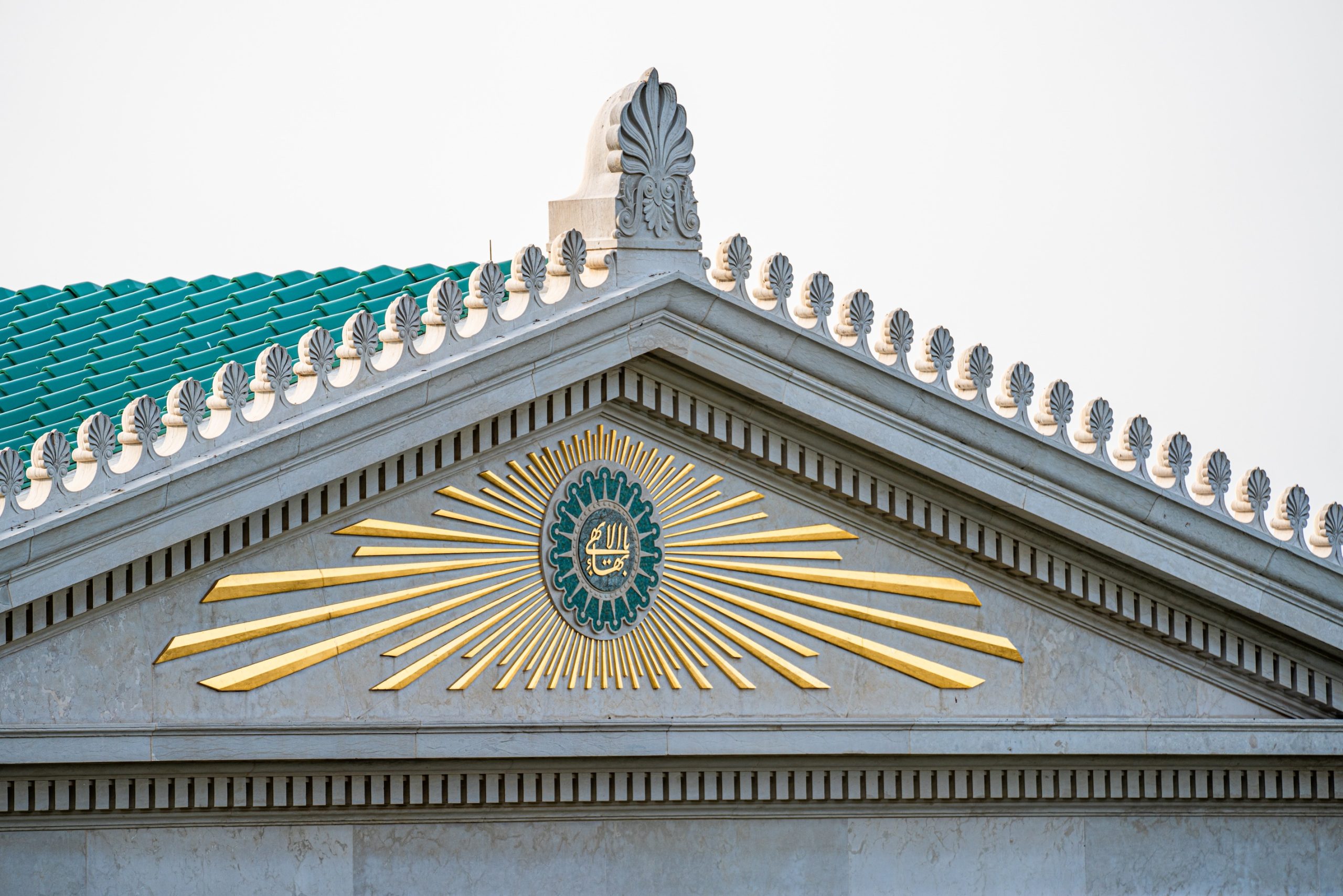
Gorgeous photograph showing the distinctive sea-green color of the roof tiles and the tympanum with radiating golden rays around the Greatest Name. Photograph by Farzam Sabetian. Source: Luminous Spot: The Arc.
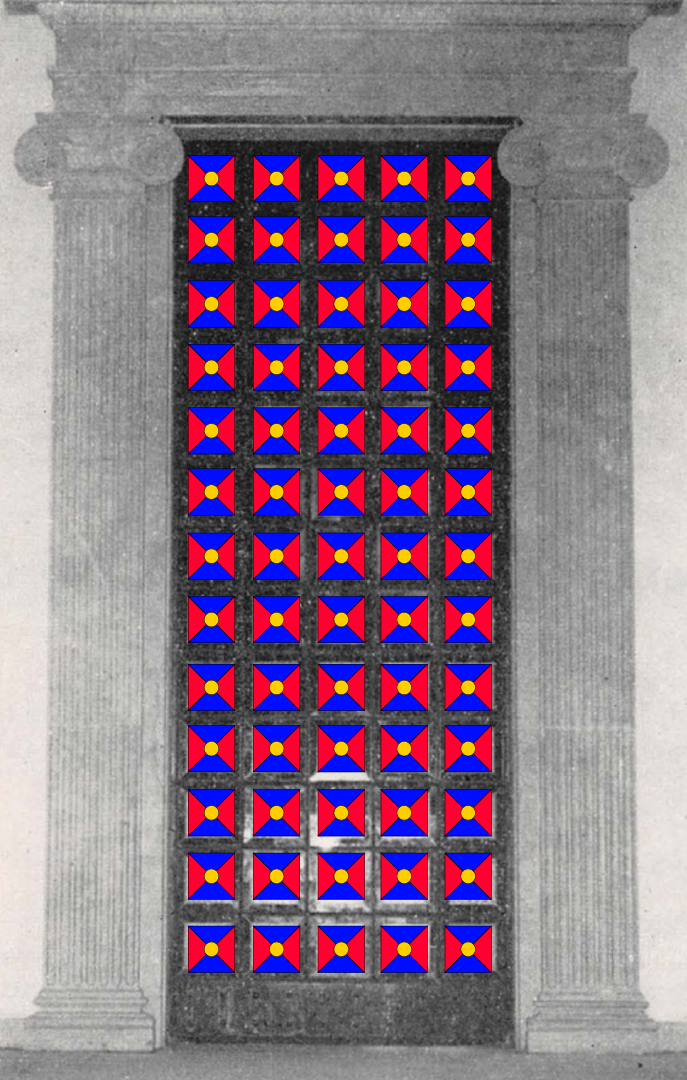
Black and white photograph of the large stained glass window of the International Archives, placed in position. The panels are of stained glass with a deep gold spot in the center, and red and blue panels, colored panels added in Adobe Illustrator to provide a sense of the brilliance of the colors in Shoghi Effendi’s design. Source: Bahaimedia.
The artist of the monumental stained glass masterpiece was Professor G. Gregorietti , who taught at the Palermo Accademia di Belle Arti (Palermo Academy of Fine Art) and an associate professor of the School of Architecture of Palermo University, in Sicily—Ugo Giachery’s native island. Professor Gregorietti’s specialty was producing rare and highly artistic decorative stained glass panels artwork.
Before work on the stained glass panel began, Ugo Giachery sent Shoghi Effendi many samples of stained glass sent to him from Italy and other European countries, from which the Guardian handpicked his colorway for the stained glass wall: yellow, red, blue, and clear glass.
Ugo Giachery traveled to Sicily to meet Professor Gregorietti, who expressed his willingness to take on this highly unusual commission. Ugo Giachery informed him of Shoghi Effendi’s color choices, and reported back to the Guardian including samples of the final stained glass colors along with a full-scale drawing of a single panel, and the estimate for all 65 panels. The final design for each panel consisted of a golden amber disk surrounded with ruby-red and royal blue panes alternating with clear glass pieces.
Professor Gregorietti worked alone in his vast and modern workshop in Palermo where he completed the work on the stained glass window meticulously, including operating the kilns and soldering the hundreds of meters of lead alloy binding for the glass.
During the months Professor Gregorietti was working on the stained glass panel, Ugo Giachery traveled to Sicily several times to check on his work and ensure its quality, as well as overseeing the final packing and shipping once the panels were all completed.
The stained glass panel—once assembled into position in the International Bahá'í Archives—was exquisitely perfect.

Color photograph of a rosace detail from the door to the International Bahá'í Archives. Source: Bahá'í Media Bank, © Bahá'í International Community 2023. Plaster model of the same detail prior to wood-carving. Source: Bahaimedia. Full-length photograph of the door after its arrival in Haifa in October 1956. Source: Bahaimedia. Background photograph: Front view of Archives Building, September 1956. Source: Bahaimedia.
The door the Guardian chose for the International Bahá'í Archives was a masterpiece of ingenuity. It was a monumental 3.80 by 1.80-meters Greek-style bronze double door, weighing almost two dons, faced with oak on the inside of the Archives. Each of the outer doors had the same pattern: 10 square panels was studded, large gilded rosettes, 30 centimeters in diameter, and each door was symmetrically studded with knobs.
Before embarking on the construction of the door, Ugo Giachery visited Roman sites to closely examine the most ancient Roman doors still in use, and concluded that the Archives’ door should be made of hard wood covered with heavy plated bronze and the outer ornamentation should be cast in solid bronze.
A reputable sculptor from Carrara made an actual-size model of one panel from which a full-scale model of the door was made for the Guardian to approve, after which the model served as a guide for the artisans. The Guardian chose the well-known Italian foundry of the firm of Renzo Michelucci for all the bronze work, and the firm of Saiello Saielli for the woodwork—this firm had built the door of the Shrine of Bahá'u'lláh in late 1952— both of which were in Pistoia, not far from Florence. As with the door for the Shrine of Bahá'u'lláh, Saiello Saielli took great pains to ensure that the oak was well-seasoned and bone-dry.
The door was built with wooden pegs and copper nails to further decrease any possibility of damage produced by iron rust, and the wood being treated with special oil and wax.
During the six months it took to build the Archive’ door, Ugo Giachery traveled the 300 kilometers from Rome to Pistoia very frequently to check and report back to Shoghi Effendi regarding the progress of the work, the bronze casting, the gilding of the rosettes, and the packing of the two half-sections of the door in a huge crate for shipment to Haifa.
The gilder for the decorative knobs and rosettes was the same Florentine artisan who had gilded the Greatest Name monograms on the arcade of the Shrine of the Báb, first silver plating the bronze, and then fire-gilding it.
As with the door to the Shrine of Bahá'u'lláh, the door of the International Bahá'í Archives could not be installed with conventional hinges, and Ugo Giachery ordered the same special ball-bearing hinges, made of the finest steel, which allowed opening and closing of the door with the least amount of effort.
Once completed and installed, the door of the International Bahá'í Archives was a masterpiece, and Shoghi Effendi was able to see it in place in the early summer of 1957.
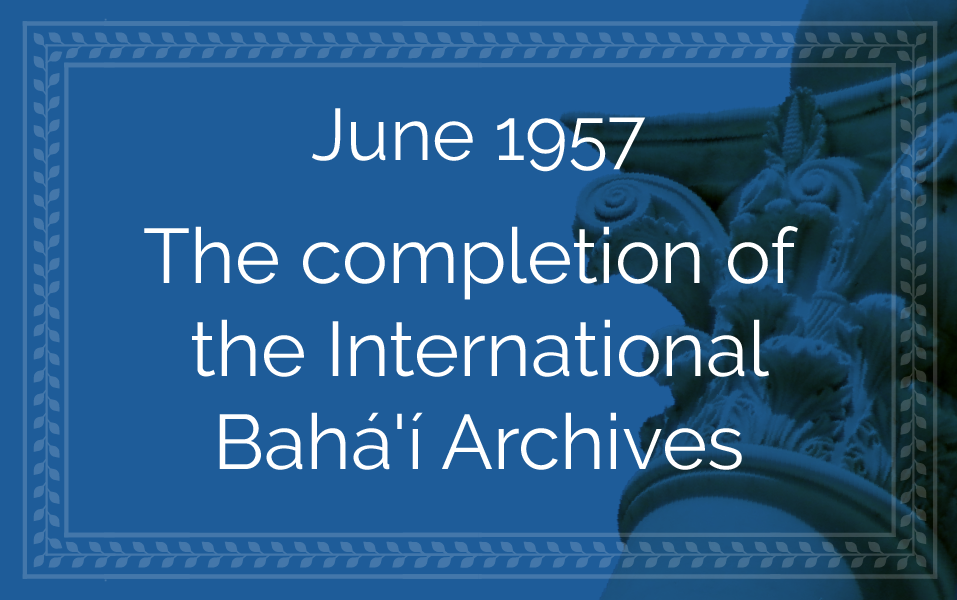
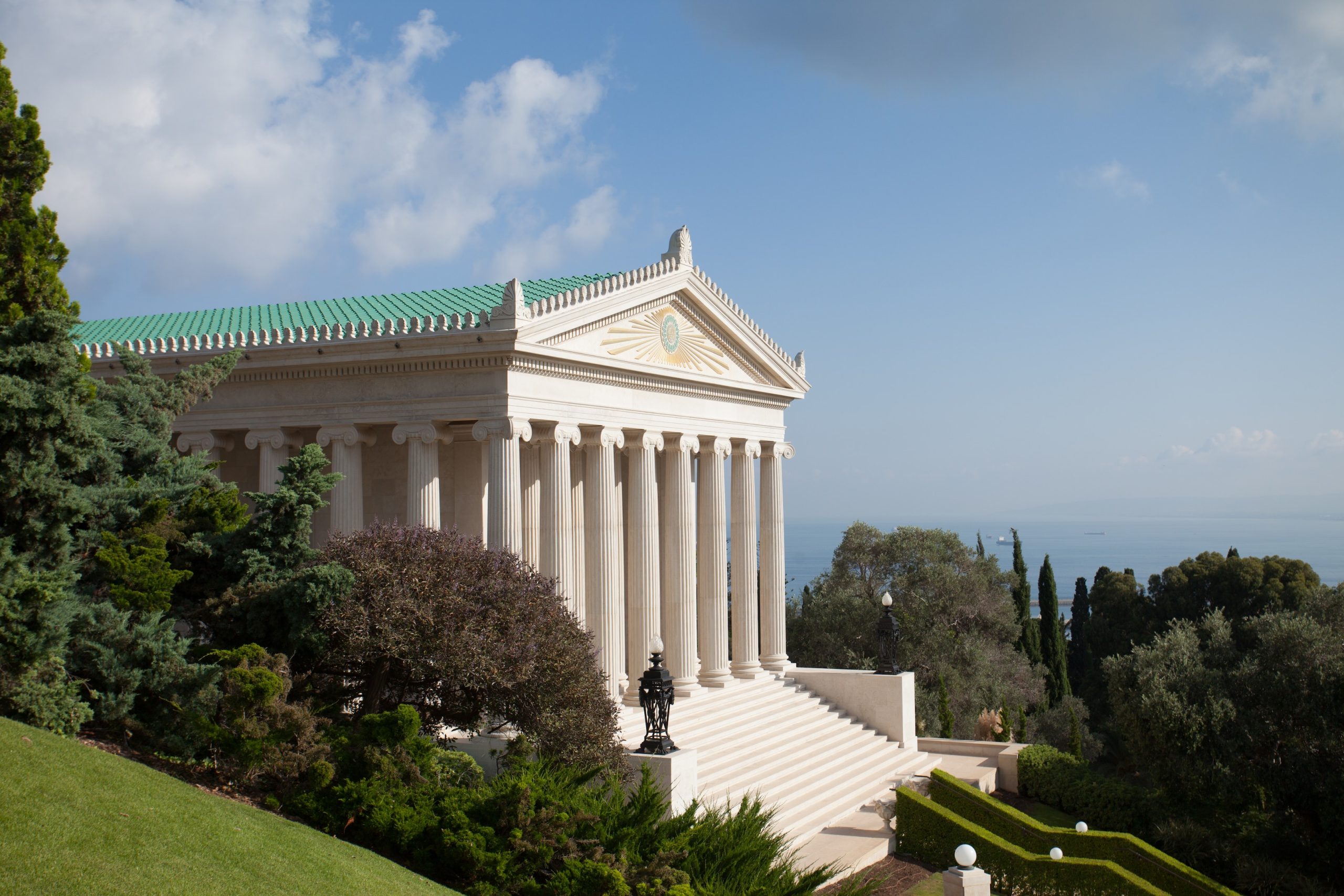
The completed, stunning International Bahá'í Archives. Source: Bahá'í Media Bank, © Bahá'í International Community 2023.
On 21 April 1957, the Guardian announced the completion of the International Bahá'í Archives to the Bahá'í world, but construction would not be totally completed until June, two months later:
The remaining twenty-two pillars of the International Bahá'í Archives—the initial Edifice heralding the establishment of the Bahá'í World Administrative Center on Mt. Carmel—have been erected. The last half of the nine hundred tons of stone, ordered in Italy for its construction, have reached their destination, enabling the exterior of the building to be completed, while the forty-four tons of glazed green tiles, manufactured in Utrecht, to cover the five hundred square meters of roof, have been placed in position, the whole contributing, to an unprecedented degree, through its colorfulness, its classic style and graceful proportions, and in conjunction with the stately, golden-crowned Mausoleum rising beyond it, to the unfolding glory of the central institutions of a World Faith nestling in the heart of God's holy mountain.
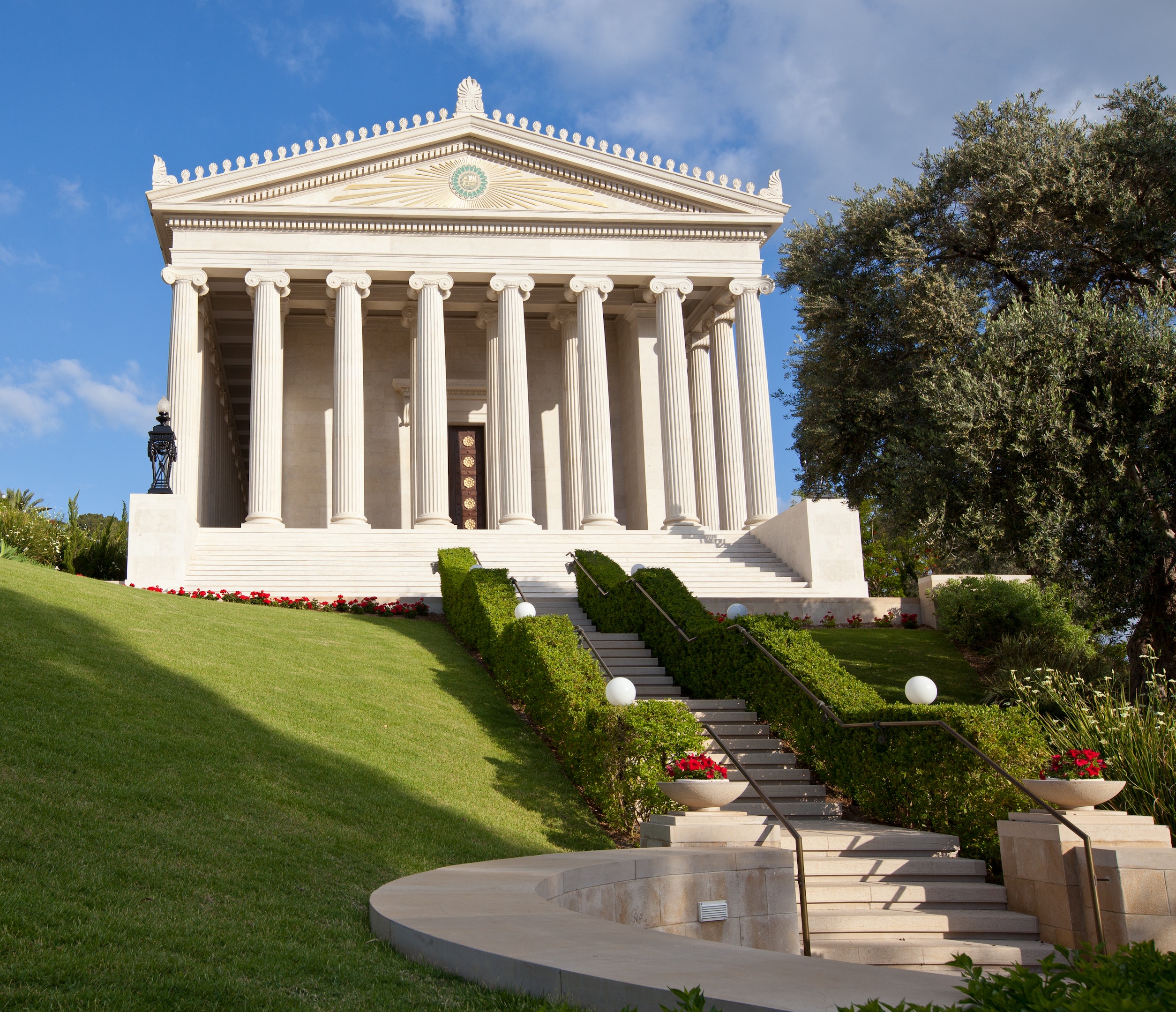
A front-facing photograph of the International Bahá'í Archives. Source: Bahá'í Media Bank, © Bahá'í International Community 2023.
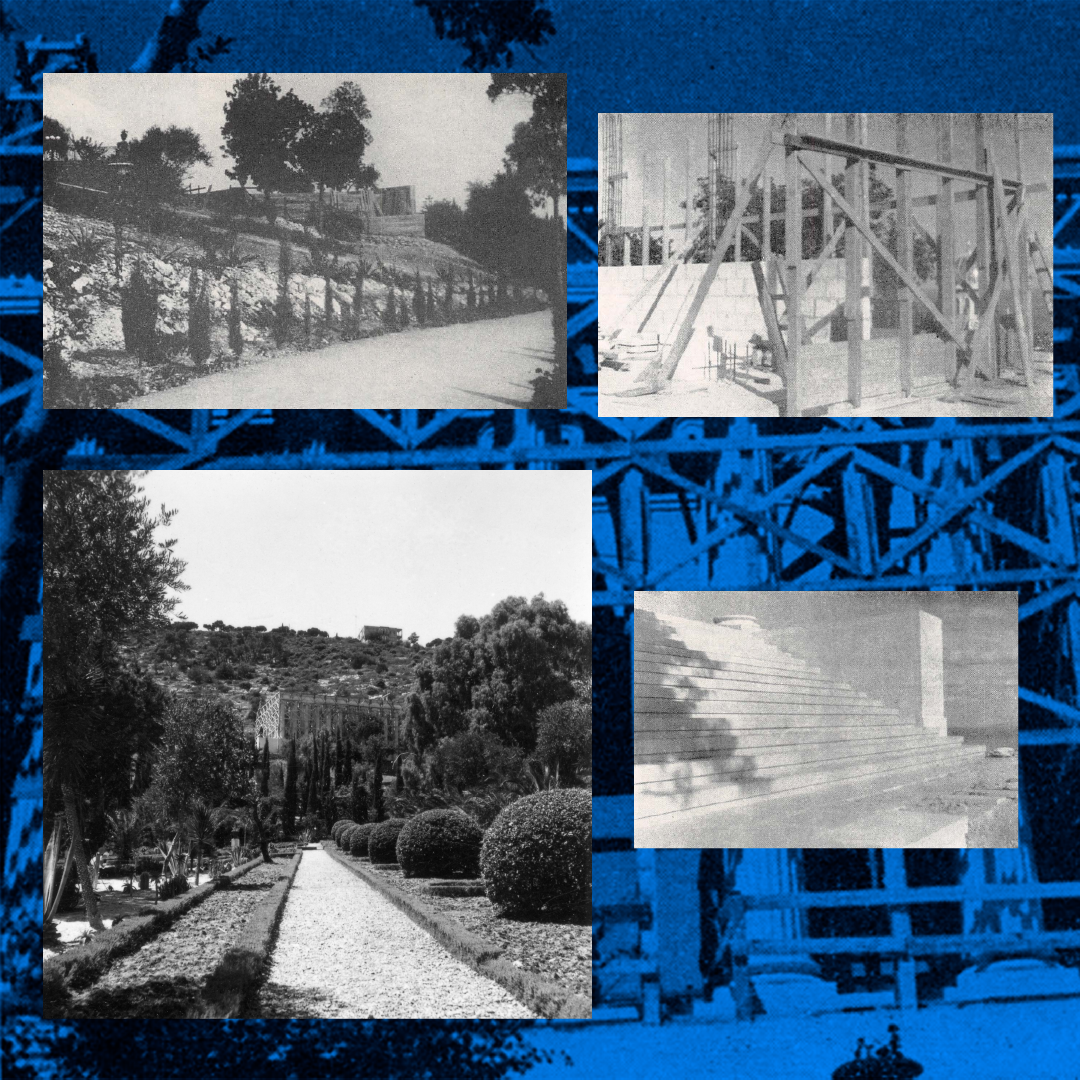
Various stages of the construction process of the International Bahá'í Archives, as the walls are raised, the stairs are installed, and the roof is built. All photographs from Bahaimedia: The construction of the International Bahá'í Archives. Background photograph: Front view of Archives Building, September 1956. Source: Bahaimedia.
From the moment the first shipment of stone arrived from Italy in August 1955 and the first column was raised in December 1955 on the northeast corner of the podium directly facing Bahjí, until the International Bahá'í Archives was fully completed in June 1957, less than two years had passed.
The entire building had been prefabricated in Italy and assembled in Israel, with only
the foundations and reinforced cement work of floor, walls and ceiling being manufactured locally.
The Archives building was utterly stunning, skirted by 52 Ionic marble columns, its bright green roof of glazed tiles, the gold of its sunburst and Greatest Name gleaming against the blue of the Mediterranean.
- 17 ships carried 1,000 tons of marble from Italy to Haifa.
- Many, many other ships transported the structural steel, cement, floor and roof tiles, lumber, stained and clear glass, small and large iron window-frames, varnish and paint for the interior, chandeliers, electric and other wires, the main and the vestibule bronze doors, the oak balustrades and plinth for the balconies, lamp-posts and many other items, such as chain-lifts, nails, drain-pipes.
- Each marble column weighed 6 tons, and had to be assembled from three parts, each weighing 2 tons.
- Each column capital weighed 1 ton.
- Each of the six anthemia— an ornamental design of alternating leaf patterns— also weighed 1 ton each.
- The roof tiles weighed 40 tons and were packed in 7,200 cardboard boxes and padded with 25 kilometers of gummed paper strips
- The first load of marble left from the port of Trieste on the S.S. Nakhshon, of the Zim Line, under the command of Captain Israel Auerbach, on 10 August 1955, barely 7 months after the contract was signed with 169 cases ferried in 8 filled railcars.
Some months before his passing, the Guardian sent Ugo Giachery a moving, grateful cable:
Congratulate you splendid historic highly meritorious achievement ensuring execution details structure Archives particularly Greatest Name. Present future generation believers including myself profoundly grateful.
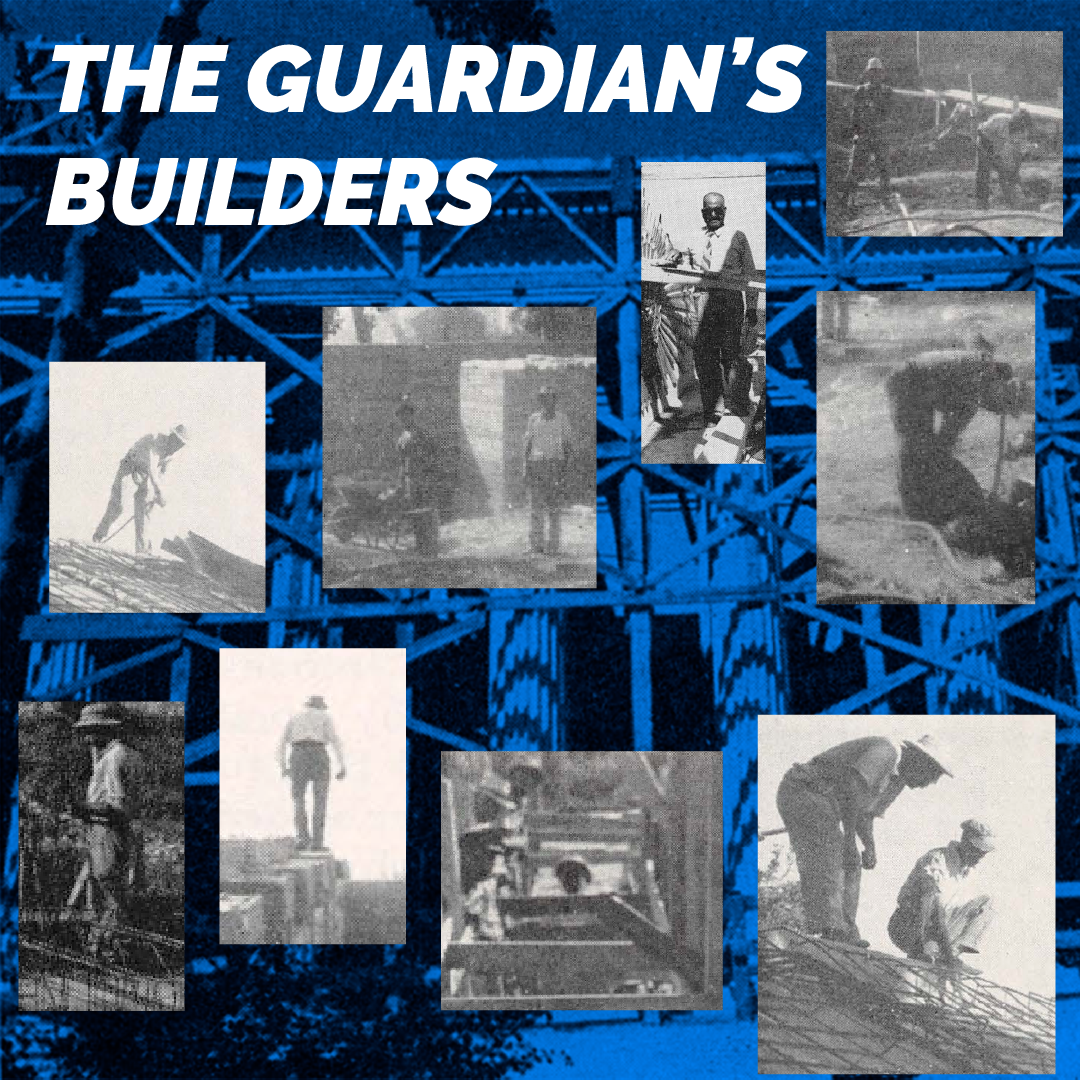
A collage of all photographs of workers on the International Bahá'í Archives that were found in Bahaimedia: The construction of the International Bahá'í Archives. Background photograph: Front view of Archives Building, September 1956. Source: Bahaimedia.
Rúḥíyyih Khánum, in her article in The Bahá'í World volume 13 on the completion of the International Bahá'í Archives, makes a stunning point about the team which built this incredibly beautiful work of art in just 2 years.
She remarks, rather brilliantly, that the team which built this exquisite edifice was composed of ignorant, untrained gardeners, an Italian chauffeur, an ex-railway executive—Leroy Ioas—a Ph.D. in chemistry—Ugo Giachery—and an elderly architect with little experience in such a large construction project—Dr. Andrea Rocca, Professor Emeritus of the Beaux Arts Academy of Carrara:
When one stands to the east and sees the early-morning light glancing along the gilded rays of the sunburst on the tympanum and catches the flash of the golden Greatest Name monogram blazoned on the green mosaic sun in the centre of nineteen pointed star, one marvels anew at that perfect sense of proportion, that innate flair for beauty, which so strongly characterized every undertaking of a man who was born a prisoner in ‘Akká, visited the West for the first time at twenty-three, had little contact with art and no formal training at all in its forms. When one recalls that this building and its gardens were realized through the instrumentality of ignorant, untrained “gardeners”, an Italian chauffeur who carried out the instruction of his employer standing directing him, an ex-railway executive, a doctor of chemistry and an old man who, though an architect, had had little experience in such undertakings, one bows one’s head before the inborn genius and determination of the Guardian.
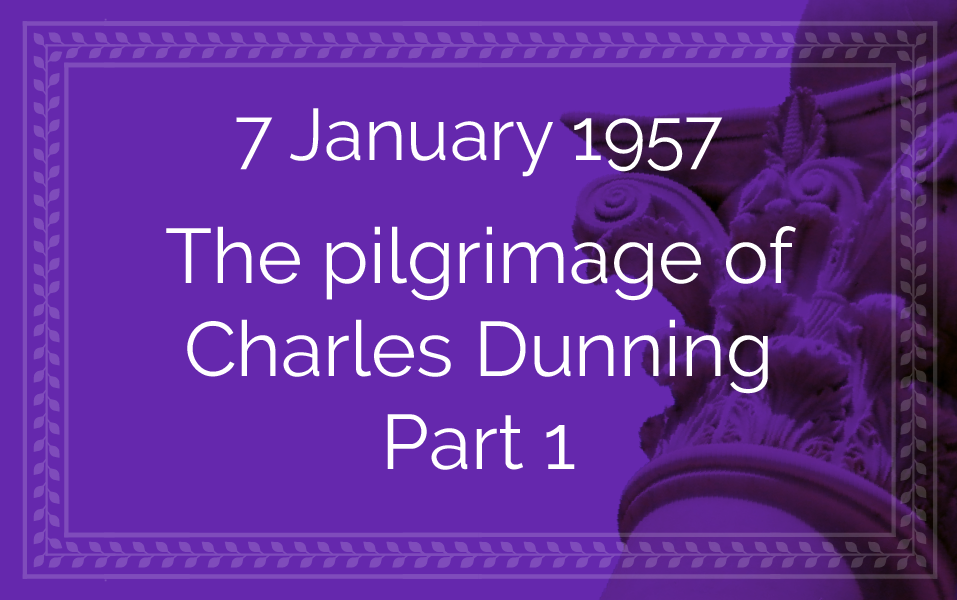
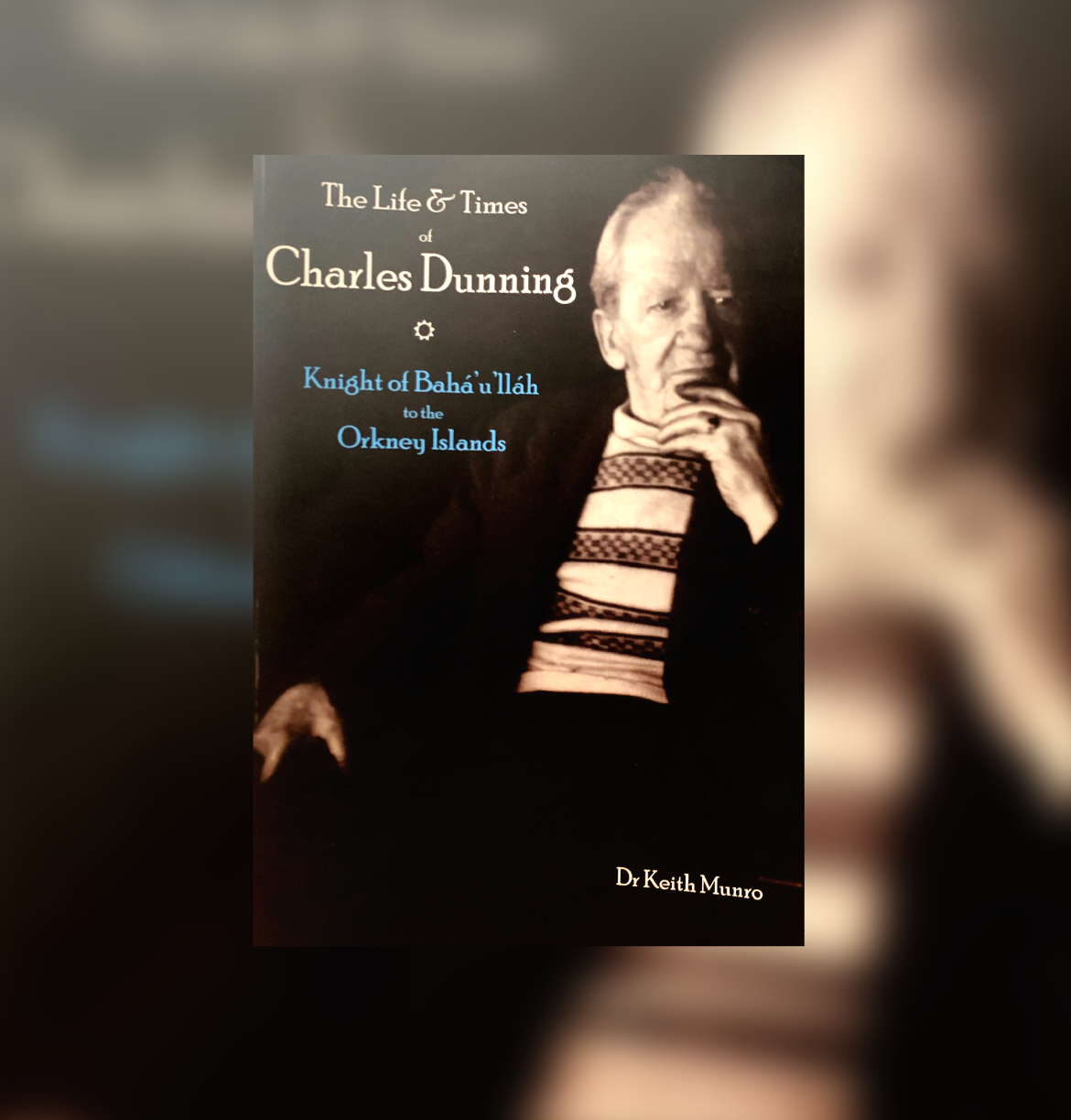
In 2023, Dr. Keith Munro published a biography of Charles Dunning, the Knight of Bahá'u'lláh to the Orkney islands, which is the main source for this section on Charles Dunning’s pilgrimage to the Holy Land in January 1957.
Dr. Munro’s book is a labor of love and dedication, filled with respect for this extraordinary hero of the Ten Year Crusade and is a thrilling read.

The isolated Orkney Islands, where Charles Dunning pioneered during the Ten Year Crusade, becoming a Knight of Bahá'u'lláh for the Islands. Photo by d kah on Unsplash.
Charles Dunning—whose job had been ship’s cook in the Merchant Navy—became a Knight of Bahá’u’lláh for the Orkney Islands, when he was the first Bahá'í to set foot there on 9 September 1953, winning a victory for Shoghi Effendi during the Ten Year Crusade. When Charles Dunning had discovered Bahá'u'lláh enjoined pilgrimage on Bahá'ís, he wrote to the Guardian, apologizing that he would not be able to perform pilgrimage because he had no money.
The Guardian paid for Charles Dunning’s pilgrimage himself. As Charles Dunning described it, the Guardian had “made the arrangements.”’
Charles Dunning was meant to sail to Haifa from Cardiff on the Israel cargo ship S.S. Geffer but there was a mix-up in his medical records and he was unable to board the ship, so he boarded a plane. During the trip, Charles Dunning made friends with many of the passengers and an air hostess who gave him her picture.
He arrived in Tel Aviv by plane on 7 January 1951 at 11:35 AM, and found no car waiting for him. Shoghi Effendi, Rúḥíyyih Khánum, and the staff of the House of 'Abdu'l-Bahá knew to expect Charles Dunning’s arrival, but they didn’t know when. Charles only had Scottish bills, and had a difficult time exchanging into Israeli Pounds, and an even harder time finding a taxi to take him to Haifa.
The taxi driver liked Charles Dunning so much they stopped for tea at the start of the journey, and soon, Charles Dunning was in Haifa, on Haparsim, at his destination.
His pilgrimage had begun.

“I am Charles Dunning. I am the pioneer from the Orkney Islands.” Background photo of the lighthouse at Kirkwall in the Orkney Islands by Mustang Joe on Flickr (license CC0 Public Domain Dedication).
Just before dinner on 7 January 1957, the doorbell rang at the western Pilgrim House.
Leroy Ioas, who was near the door, opened it and saw a very small man, who looked like a sailor, wearing a very large turtleneck sweater. Charles Dunning must have looked quite terrible because Leroy Ioas thought he was a bum who had rung the doorbell to ask for money.
Leroy Ioas was about to send him around to the side entrance of the house where the poor were often provided with food, when he suddenly thought changed his mind and asked him:
Yes? Is there anything that we can do for you?
Charles simply said:
I am Charles Dunning. I am the pioneer from the Orkney Islands.
Well, come right in.
Leroy Ioas realized with both shock and embarrassment that the man in front of him, whom he had so badly misjudged, was the Knight of Bahá’u’lláh they had been expecting the last few days.
Charles entered the western Pilgrim House, and the two sisters Ethel and Jessie Revell—members of the International Bahá'í Council—entered and spoke with Charles of his airplane trip and the friends in England.
Leroy Ioas took Charles Dunning to his room, informed him the Guardian would be arriving for dinner soon, and said:
Well, we are getting ready to go down to have dinner with the Guardian, and do you think maybe you want to change your clothes and clean up a little bit for the Guardian?
Charles Dunning responded:
Yes, I will. I will.
Leroy asked him if he had brought suitable clothes. Charles Dunning beamed and, gesturing to his old and worn suit, said:
Yes, I have.

Portrait of Charles Dunning. Source: Bahá'ís of Orkney.
Charles Dunning arrived for dinner wearing the exact same clothes he had arrived in.
Rúḥíyyih Khánum had arranged the dinner table in the western way: the Guardian would sit at his usual seat, from where he could see everyone at the table, Rúḥíyyih Khánum always sat next to Shoghi Effendi and his other secretaries, ladies who had arrived before Charles Dunning and several elderly Americans were seated closer to the Guardian, and Charles Dunning was seated further down. This all seemed perfectly logical to Rúḥíyyih Khánum.
The Guardian arrived in the dining room with his usual swish of elegance, put his arms around Charles Dunning, kissed him—something that the Guardian NEVER did—and said, with his arm around Charles’ shoulder:
You’re a Knight of Bahá’u’lláh, and you deserve to be at the head of this table.
Charles Dunning was still beaming as Shoghi Effendi led him to his seat of honor immediately to his right.
All the lades scattered further down the table to make room for Charles Dunning who was now sitting at the head of the table. Sitting there and watching the scene unfold, the Guardian’s love and respect for Charles Dunning, his Knight of Bahá'u'lláh, and his understanding of proper Bahá'í—not cultural—etiquette, she thought to herself:
Now look, isn't that just typical? You had the standard of the world. You went according to your culture and your background…This is the way it ought to be.
Leroy Ioas, too, learnt a lesson that night. He would later say that he felt like a 5 cent coin. He had judged a Knight of Bahá'u'lláh based on material standards and the Guardian had judged him with the standard of Bahá'u'lláh.
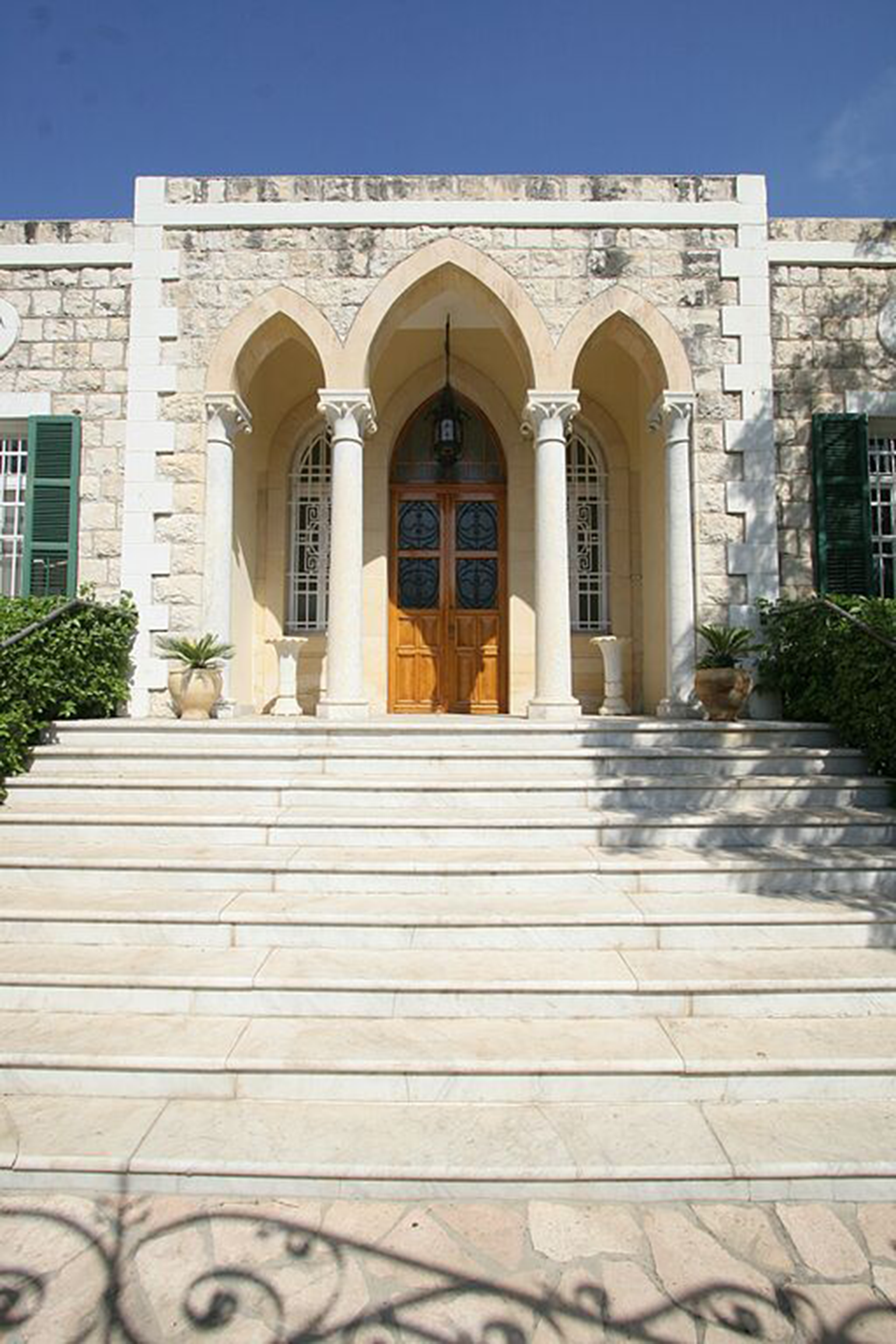
Steps leading up to the door of the Western Pilgrim House at 10, Haparsim, in Haifa, where Charles Dunning had his first dinner with Shoghi Effendi on 7 January 1957. Source: Bahaimedia.
Charles Dunning had created an entire image of what the Guardian would be like in his head—dignified and serene—and when he encountered the reality of the who the Guardian was, he discovered the spiritual reality of Shoghi Effendi, and described it beautifully:
He was possessed of a human touch which you could feel. And in my first meeting with him I was happy right away.
The dinner guests were fascinated: Charles Dunning sat at the head of the table, watching Shoghi Effendi, his beloved Guardian, with his arms on the table, leaning in into the Guardian’s personal space, wagging his finger almost under his nose, saying:
Guardian do you remember when you wrote that?
The pilgrims and staff were also fascinated because Shoghi Effendi was leaning into Charles Dunning absolutely beaming and enthralled, and he, too, had his arms on the table, something that Rúḥíyyih Khánum had never seen in 20 years of marriage. The Guardian was laughing and joking, and smiling, and talking to Charles Dunning in a way that astonished even his wife.
Shoghi Effendi and Charles Dunning were having a wonderful, unforgettable dinner. Charles Dunning was so thrilled, so awestruck that he held his soup spoon up to his mouth, but he was staring at the Guardian and kept raising his hand. Watching this, Rúḥíyyih Khánum thought:
In one more minute, he's going to pour this soup in his ear. Oh God, oh God, oh God!
In the end, when Charles Dunning saw where his soup spoon had gone, he was very surprised and put it in his mouth.
During this first dinner, Charles Dunning told Shoghi Effendi about the air hostess he had taught the Faith to on the plane to Tel Aviv and showed him her photograph. The Guardian asked Charles Dunning:
Can I have it?
Charles Dunning was overjoyed. He felt as if the air hostess he had taught the Faith had spiritually entered the Faith at that moment.
Charles Dunning was delighted to discover that Shoghi Effendi and Rúḥíyyih Khánum had a wonderful, very funny sense of humor, and he recalled there wasn’t a single dinner at the Pilgrim House when there weren’t peals of laughter.
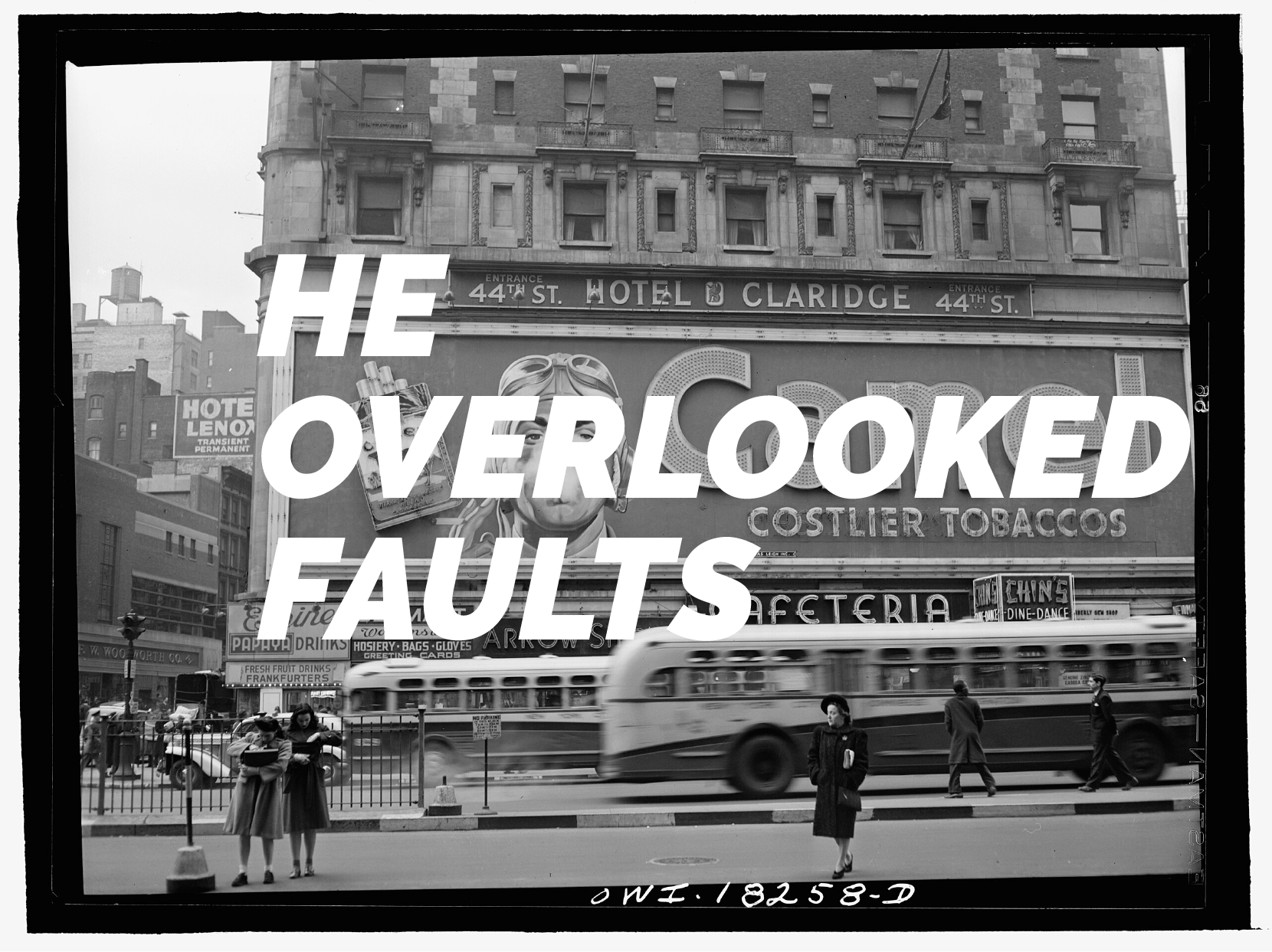
“He overlooked faults.” The attitude of the Guardian illustrated by these three words, placed exactly over an advertisement for American cigarettes on Times Square in New York. Photogrpah by John Vachon. Source: Wikimedia Commons.
Charles Dunning, a through and through Yokrshireman, was completely himself during his entire pilgrimage, and one night, he managed to appall all the Bahá'ís at the dinner table with a single gesture.
After the meal, Charles Dunning pulled a cigarette butt out of his pocket, impaled it on a needle, and began to smoke it with great enjoyment.
The only person that was in no way shocked or appalled was the Guardian himself, he was only very curious at what Charles Dunning was smoking and asked him why he was smoking a cigarette butt.
Charles Dunning replied:
I am a poor man and I have to use everything to the very last in order to get by.
The next evening, Fujita placed a brand new pack of American cigarettes beside Charles Dunning place.
It had been placed there at the Guardian’s request.
The whole “smoking incident” had taught a profound and important lesson to everyone at the table, by not criticizing Charles Dunning’s lifelong smoking habit—he must have started smoking when he was 7 and he was now 71 years old—which would have hurt him, or worse, alienated him.
Shoghi Effendi had chosen to overlook the small fault of a spiritual giant, a Knight of Bahá'u'lláh, a true hero of the Ten Year Crusade who had won inestimable victories for his Guardian, a humble and hardworking man who had given his whole heart to Bahá'u'lláh.
The Guardian was always focused on the inner being of the Bahá'ís, he loved and he overlooked faults.
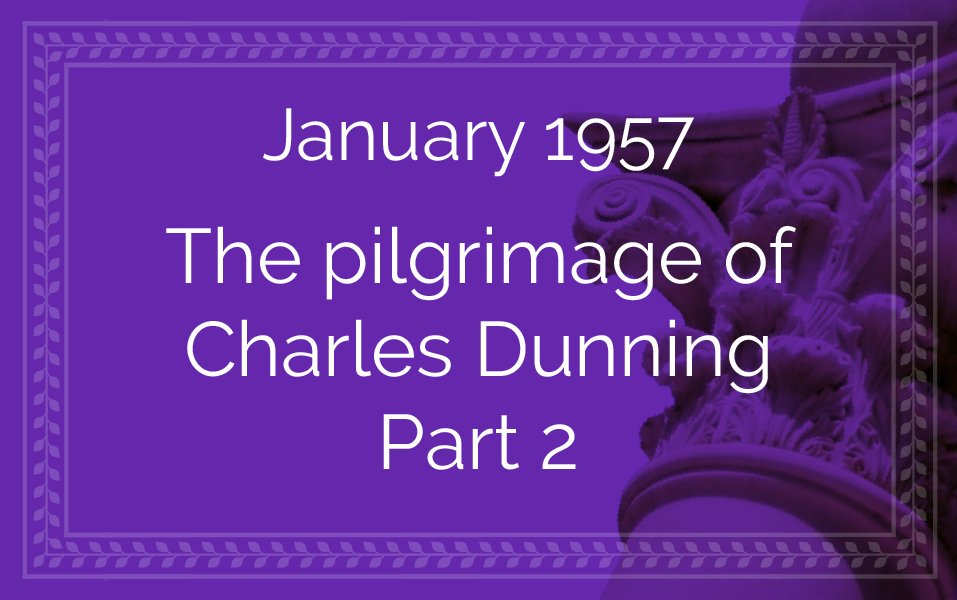
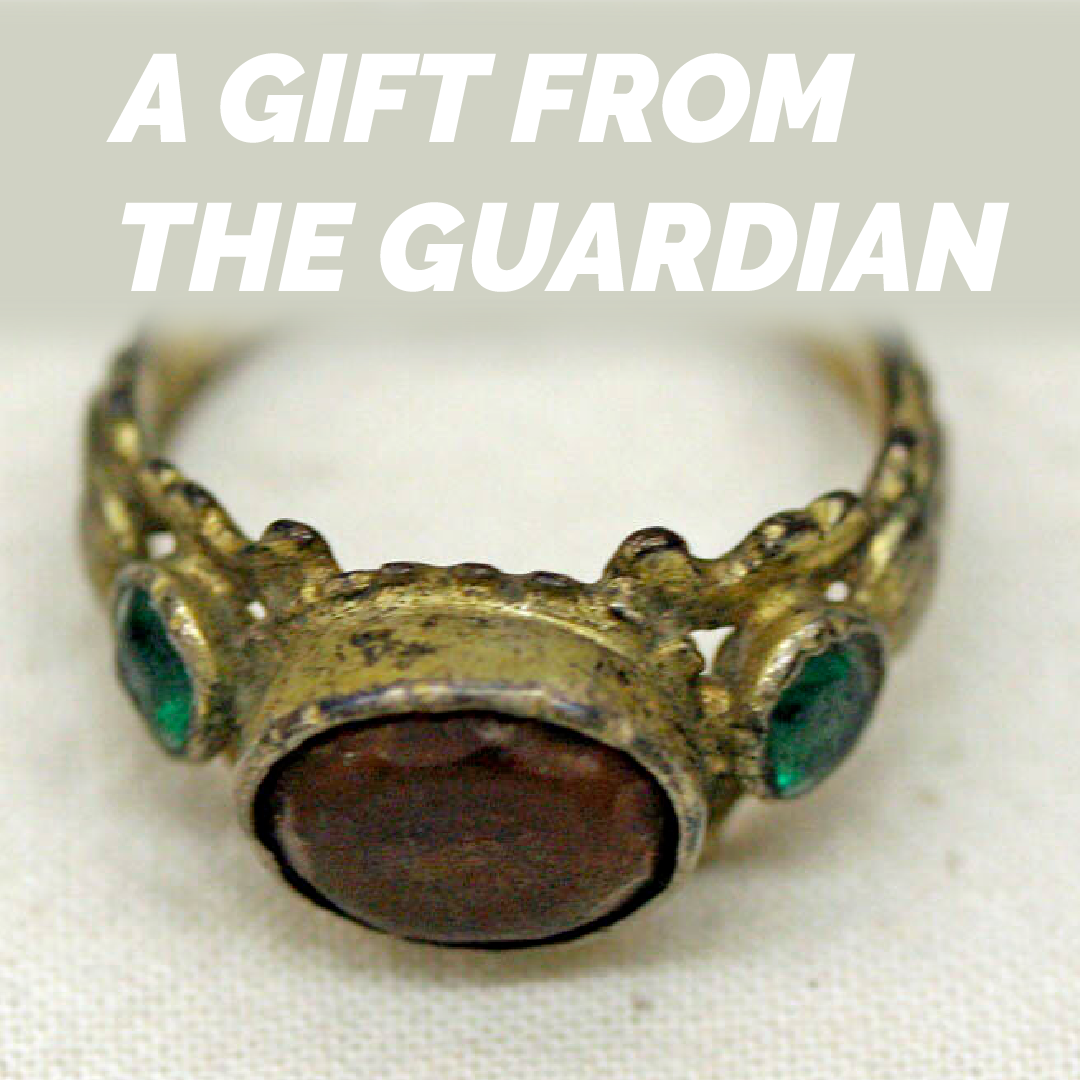
“A gift from the Guardian.” Note: This is not the ring Rúḥíyyih Khánum gave to Charles Dunning. Background photograph: 18th century ring from Europe, gift of Mr. Lee Simonson, 1944. Source: The Met.
One evening, the Guardian told Rúḥíyyih Khánum he had a stone and wanted her to go to Haifa and have it mounted on a ring by a jeweler. When Rúḥíyyih Khánum got to the jewelry store, the jeweler told her the work would take a week, but Rúḥíyyih Khánum insisted she needed it that day, because it was a gift for someone who would be leaving Haifa in a few days.
The jeweler mounted the stone on a ring while Rúḥíyyih Khánum was in his shop.
When Rúḥíyyih Khánum returned, she showed the ring to Charles Dunning, and he was delighted.
Then, Rúḥíyyih Khánum put it on his finger. It was a gift from the Guardian.
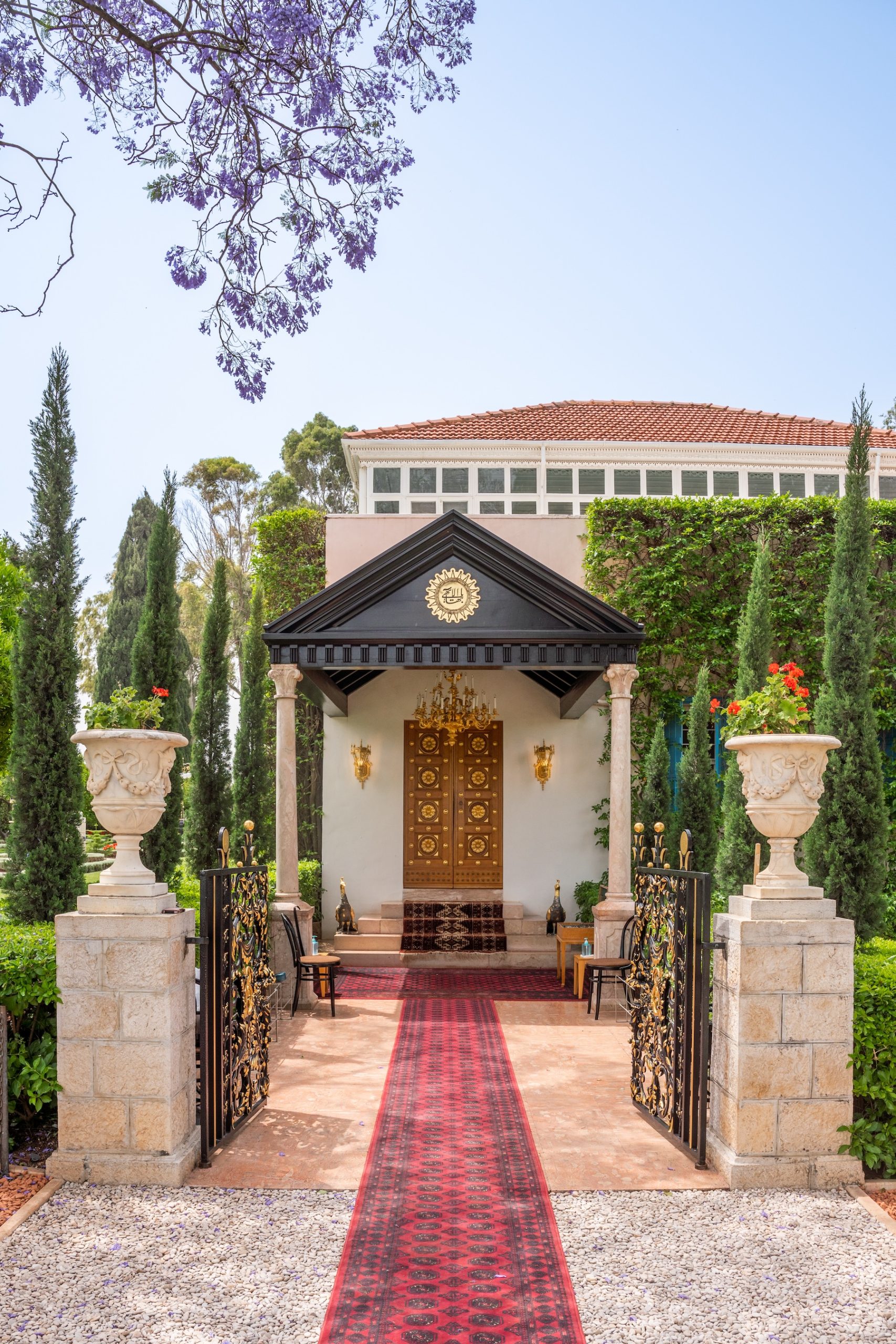
Photograph of the door to the Shrine of Bahá'u'lláh, where Charles Dunning guided pilgrims and visitors. Photograph by Farzam Sabetian. Source: Luminous Spot: The Shrine of Bahá'u'lláh.
Charles Dunning’s experiences at the Shrine of Bahá'u'lláh, at the Shrine of the Báb, the prison cell of Bahá'u'lláh in the Most Great Prison, the Temple Site on Mount Carmel, and staying over one night at the Mansion of Bahjí would stay with him forever. They touched his heart and his soul. He was also privileged to be taken on a tour to the top of Mount Carmel by Rúḥíyyih Khánum herself.
Charles Dunning was a very independent and original character. He once asked Shoghi Effendi if he could go out exploring Haifa on his own, and the Guardian allowed it. He mixed with Arabs and Jews, and met children who could speak English. They translated what Charles Dunning was telling them for the adults, and they all spent a lovely time together and Charles felt he had made many friends. He would later say he was proud he had asked the Guardian if he could go into Haifa by himself and counted that outing as one of his greatest moments.
The Guardian asked Charles Dunning and Bobby Leedham to guide visitors at the Shrine of Bahá'u'lláh for two days. Charles Dunning had a counter to record how many visitors entered the Shrine. On one of the two days, a group of children came with their teachers, and the children were so small, it would have been impossible to get them to remove their shoes and put them back on, so Charles suggested they peak inside the Shrine from the threshold of the door.
On another day, an American wanted to take three selfies in front of the Shrine and popped his pipe in his mouth. Charles Dunning asked him to take it out, but he was surprised when he recounted the story to Shoghi Effendi that the Guardian said he would not have asked the man to remove his pipe.
The Guardian arranged for something deeply meaningful for Charles: a special visit to Nazareth, so he would have something to share with Christians when he returned to Cardiff, Wales. In Nazareth, Charles visited the house of Mary, mother of Jesus Christ, a holy place that profoundly moved and impressed him with its massive pillars and vaults.
Charles Dunning’s pilgrimage was an infinite learning experience. He learned a lot from future member of the Universal House of Justice Luṭfu’lláh Ḥakím, Salah Jarrah, Ethel and Jessie Revell,
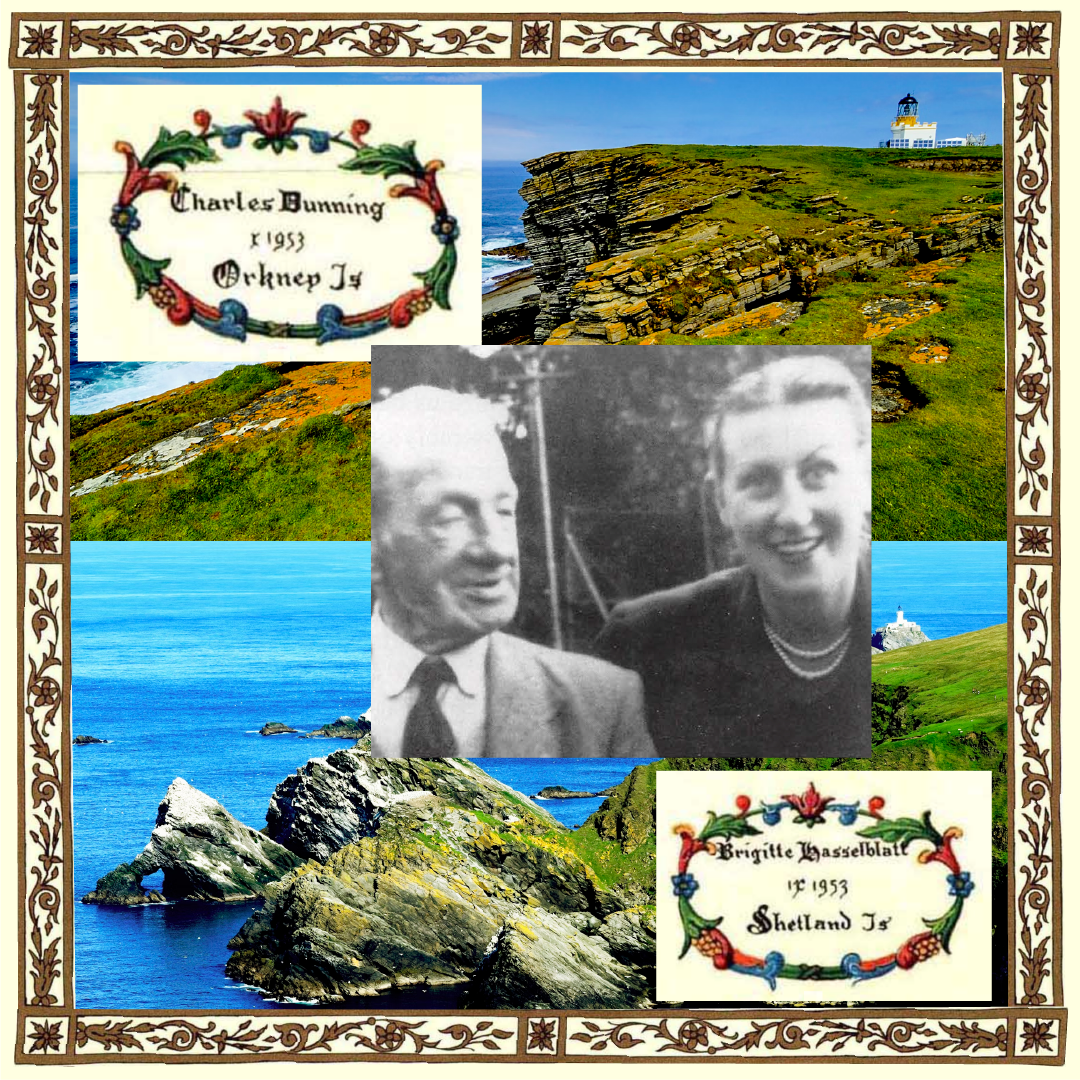
Charles Dunning’s place on the Roll of Honor as Knight of Bahá'u'lláh for The Orkney Islands, and his close friend Brigitte Hasselblatt, Knight of Bahá'u'lláh for the Shetland Islands. A photograph of Charles Dunnign and Brigitten Hasselblatt taken around 1954. Source: The Bahá'í World Volume 20, page 102. Top background photograph: The Orkney Islands by Maxwell Andrews on Unsplash. Bottom background photograph: The Shetland Islands by Lia Tzanidaki on Unsplash. Border created out of assets from the Roll of Honor.
The Guardian showed Charles Dunning the Roll of Honor of the Knight of Bahá'u'lláh and described to him what a pioneer was:
You were a first a dot.
Charles Dunning heard “dog” and said:
I didn’t think you thought I was a dog.
The Guardian burst out laughing, joined by Rúḥíyyih Khánum and the rest of the guests.
The Guardian explained he was first a dot, then a pioneer, then he was made a Knight of Bahá'u'lláh, the he became a conqueror.
Charles Dunning recalled his emotion when he heard the Guardian say “conqueror”:
That minute I was proud.
When the Guardian showed Charles Dunning the Roll of Honor, Charles Dunning asked to see the name of his good friend Brigitte Hasselblatt—Knight of Bahá'u'lláh to the Shetland Islands—and Shoghi Effendi teased Charles, saying:
You mean your girlfriend don’t you?
The best story was what happened when the Guardian shared his map of the Ten Year Crusade with Charles Dunning and the pilgrims. This is a story of Yorkshire’s directness and outspoken informality.
The Guardian was explaining that this map of the Ten Year Crusade showed the progress that had so far been accomplished.
The Guardian made a joke about the ambitiousness of the plans of the Ten Year Crusade—it was a tough ask for the Bahá'ís of the world—and he intimated that when the Bahá'ís saw his map, they would be very upset and unhappy with him.
Charles’s instant response to the Guardian was Yorkshire slang:
Bunkum, Guardian, bunkum.
“Bunkum” is a Yorkshire word for “nonsense.” What Charles Dunning was saying, would translate into full sentences in English as “Nonsense! How on earth could anyone even think that!” or, “Don’t be silly Guardian, no one would think that.”
The Guardian probably never found out what “Bunkum” meant in York slang, but he perfectly understood Charles Dunning’s reaction from his tone of voice.
Charles Dunning had told his beloved Guardian that Bahá'ís adored him and would always be devoted to him, no matter what the task was that he put before them, humble or majestic, attainable or heroic.
Charles was dead-right, of course. The Bahá'ís would be elated.
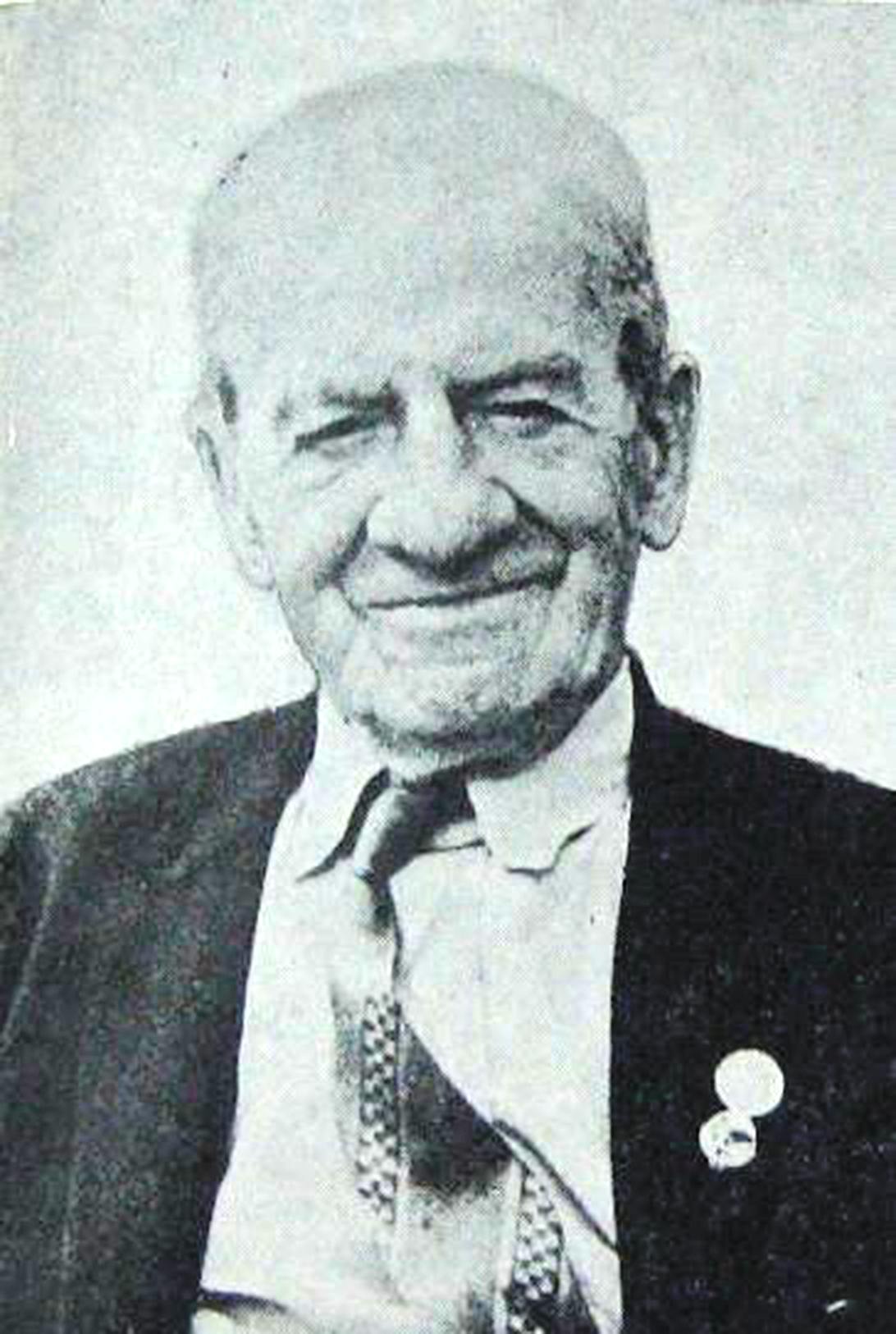
Portrait of Charles Dunning. Source: Bahaipedia.
Charles was a charming, funny, very down-to-earth, energetic man. He was in his 70s when he came on pilgrimage. He was originally from Yorkshire, and spoke with that delightful and most distinctive among all English accents. He was full of energy. He was a character and he left an impression on everyone who met him.
For as long as Charles Dunning’s pilgrimage lasted, every night when Shoghi Effendi and Rúḥíyyih Khánum walked home across Haparsim Street to the House of 'Abdu'l-Bahá, Shoghi Effendi would say:
Oh, I like that man so much. He's such a fine man. I like him so much.
Shoghi Effendi was not in the habit of praising Bahá'ís in that way.
Charles Dunning was just an extraordinary human being, he was blue collar, he was simple, he was poor, but he was happy in spirit. Perhaps Shoghi Effendi loved him so because he was closer to the types of people 'Abdu'l-Bahá spent a lifetime loving, guiding, caring for, and ministering, than most of the Bahá'ís he met as Guardian.
After Charles left Haifa, the Guardian said:
He is one of God's heroes.
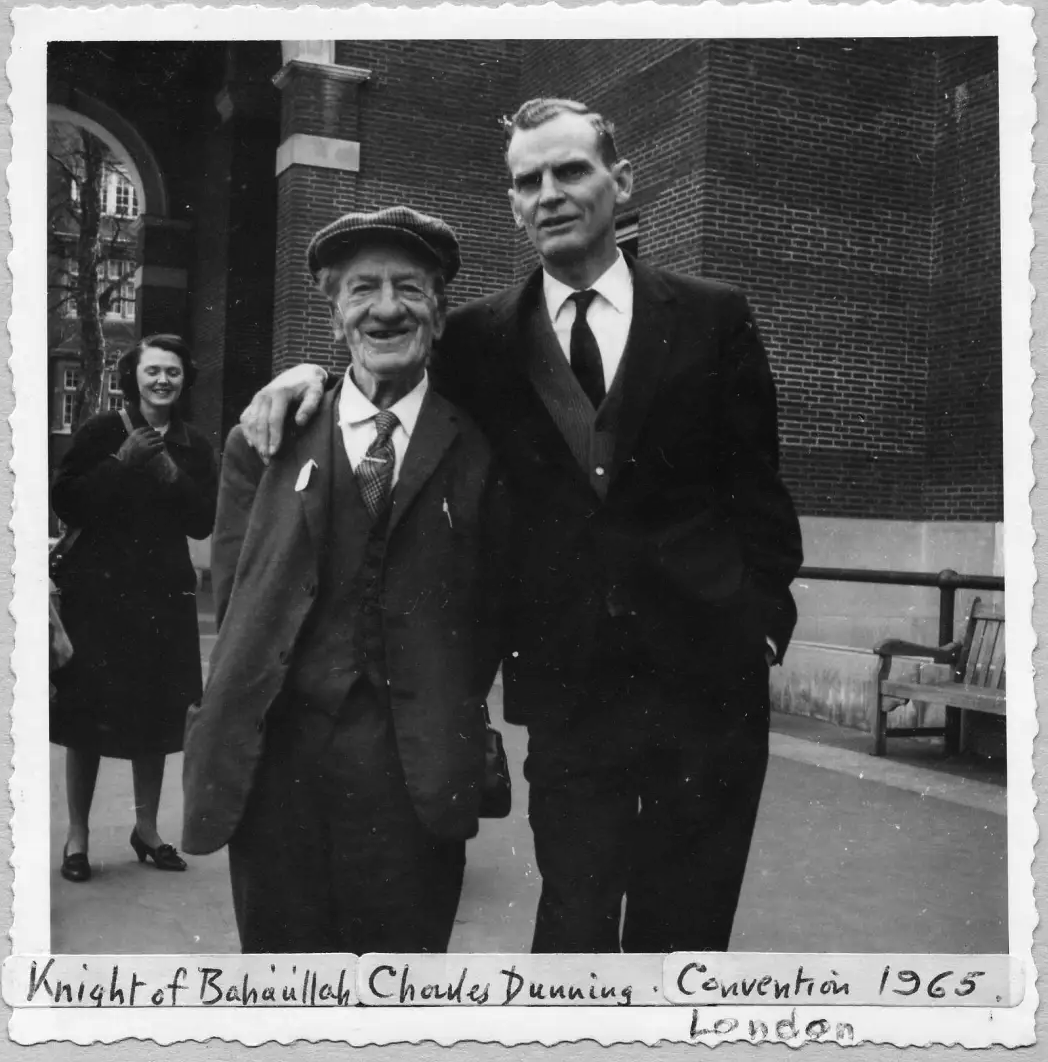
Charles Dunning with Knight of Bahá’u’lláh for South West Africa (Namibia) Ted Cardell at the 1965 National Convention for the United Kingdom. In the background is Alicia Cardell. Source: UK Bahá’í Histories.
After his pilgrimage, Charles Dunning wrote a pen-portrait of Shoghi Effendi, filled with his love for his Guardian and inspired by the profound experiences he had lived during his pilgrimage in the Holy Land. The following are all of Charles Dunning’s words, a compilation of his observations on the Guardian during his pilgrimage which started on 7 January 1957, the testimony of love for a Guardian who required his love a thousandfold:
What impressed me mostly was how he had studied everything in detail. As we all sat there you was at your ease, for events came so easily as he is telling you, with his map unfolded. He was pointing out what he had done and what he is intending doing in his 10-year Plan. It was with ease, and you was also at ease. And it is this I am trying to think of him…
When he asked me if I had gained from my visit I replied: “It is how you feel yourself spiritually when you go into the Shrine,” and he said yes that is true. How this consoled me. I felt so happy in his presence. And it is this now which makes me so happy…
[Each] night, when you was in his presence, he was so eager to know where you had been and what you had seen…
He said he had a great love for the British Bahá’ís we have a lot to be thankful for when we think of that…
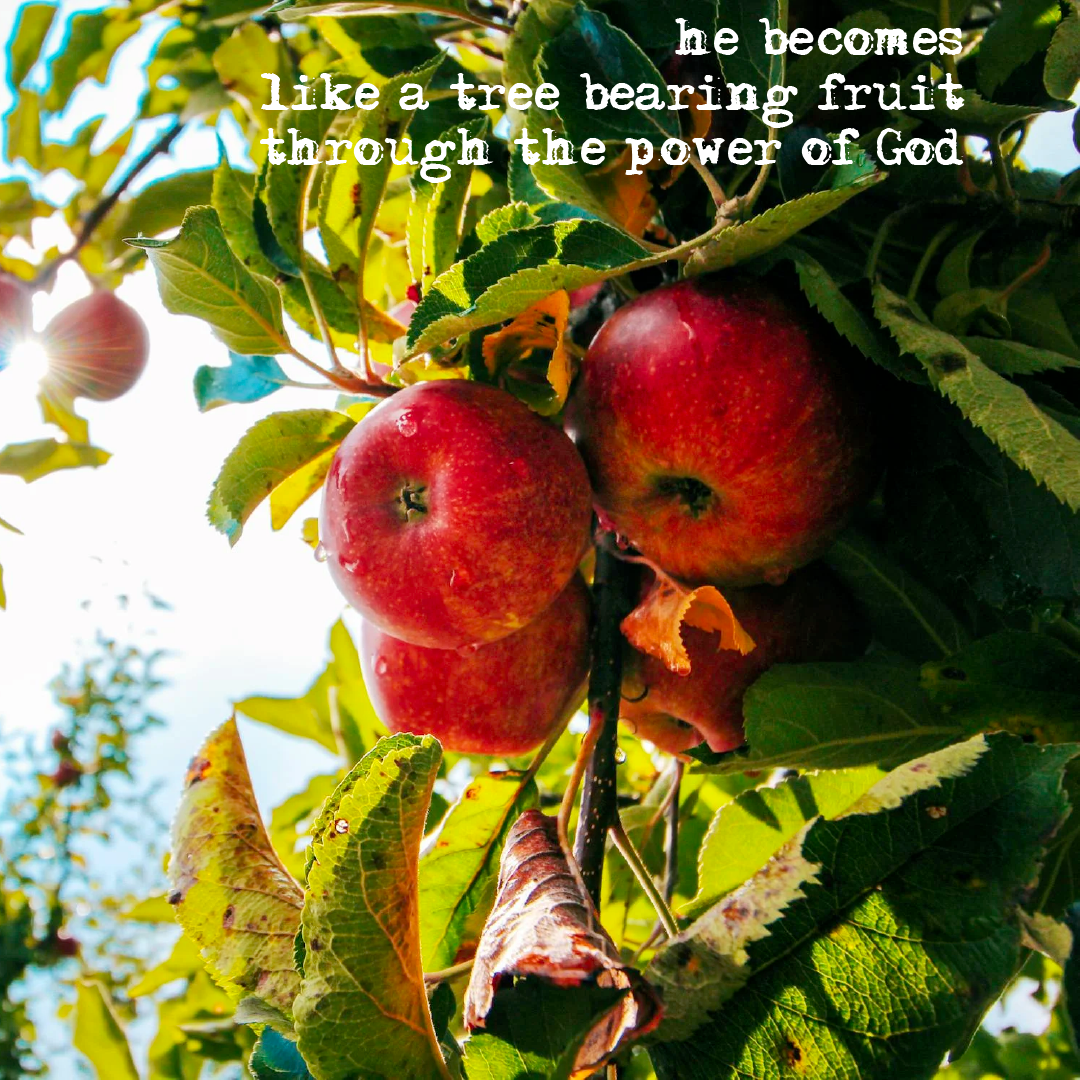
“he becomes like a tree bearing fruit through the power of God” Background image from Pexels.
Regarding what Charles Dunning learned from the Guardian about how to teach, he had this to say:
This food [the message of the Bahá'í Faith] is to be offered for the sake of God, only, not for the hearer’s sake, not for the benefit of yourself: but simply because God wishes His Manifestation to become known and to become loved by those who come to know Him.
If one teaches one whom he loves, because of his love for him, then he will not teach one whom he loves not; and that is not of God.
If one teaches in order to derive the promised benefit to himself, this too is not from God. If he teaches because of God’s Will that God may be known, and for that reason only, he will receive knowledge and wisdom, and his words will have effect – being made powerful by the Holy Spirit, and will take root in the souls of those who are in the right condition to receive them.
In such a case the benefit to the teacher in growth is as ninety per cent compared to the ten per cent of gain to the hearer, because he becomes like a tree bearing fruit through the power of God.
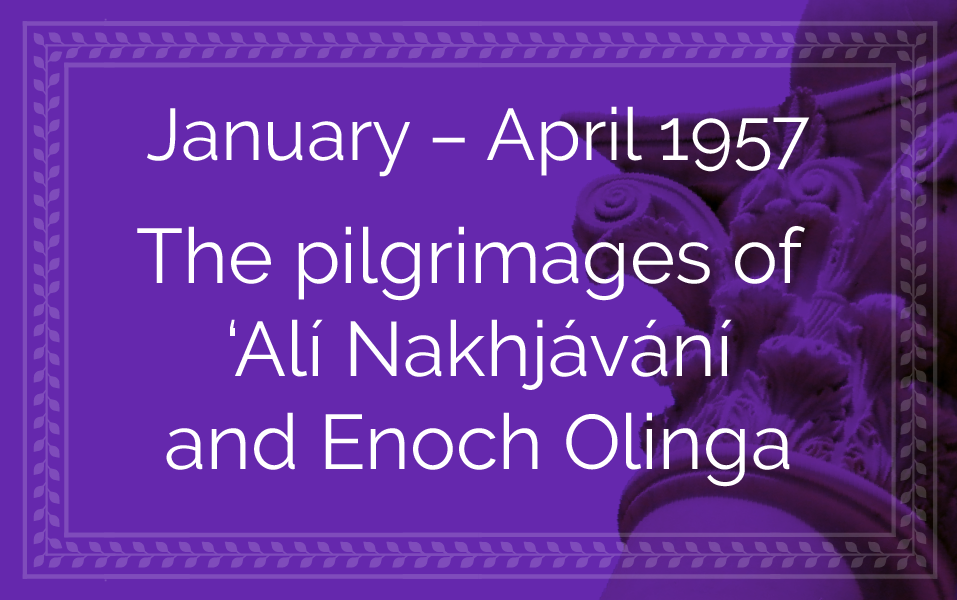
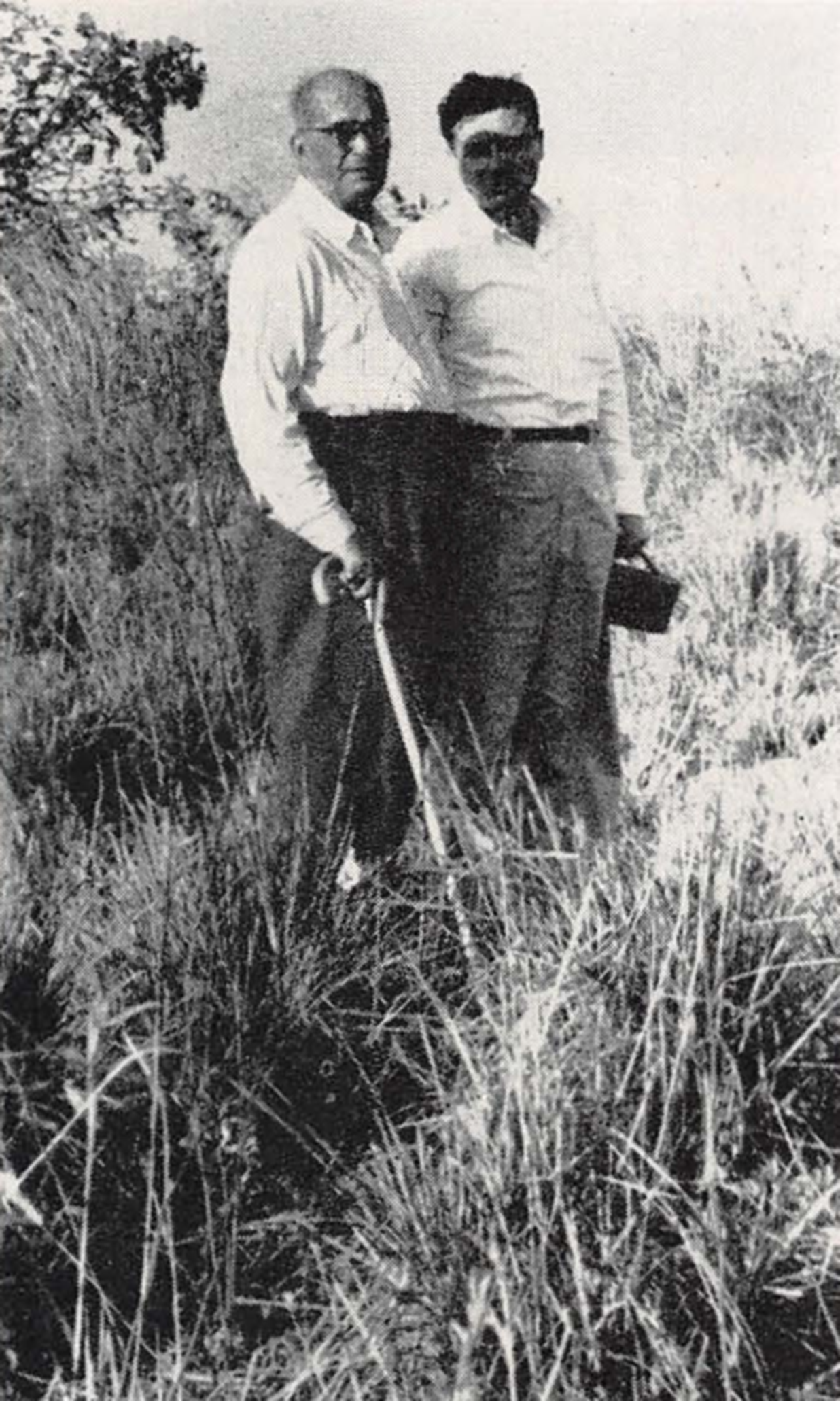
Músá Banání and ‘Alí Nakhjávání at the Kampala Temple Site in 1957. Source: Bahaimedia.
‘Alí Nakhjávání left Uganda to come on pilgrimage in January 1957. There were 5 other men in his pilgrim group, and one day, after having visited Bahjí in the morning, they arrived in Haifa in the afternoon. From the Eastern Pilgrim House, they saw Shoghi Effendi was in the gardens, and when he signaled for them to join him, they ran to reach him, as he was walking in the gardens near the Shrine of the Báb.
One of the pilgrims was an elderly gentleman, and when they arrived in front of Shoghi Effendi, he began coughing, and coughing. The younger pilgrims—including ‘Alí Nakhjávání—stood behind him. Shoghi Effendi stopped, turned, and told the old man:
You are tired.
The man answered:
Beloved Guardian, we were tired, now that we are in your presence, all our fatigue has vanished.
The Guardian did not like this answer at all, but nonetheless told the old man very lovingly:
Why did you say this?
The poor man did not what to do or what to say, he was ready to crawl into a hole and disappear. There was absolute silence. Then, with the same loving and tender tone, the Guardian said:
What you should have said was: we were tired, but now that are in the precincts of the Shrine of the Báb, all our fatigue has vanished. This is what you should have said. You did not come here to see me. You have come here to visit the Shrines. The friends should not fix their gaze on individuals.
To ‘Alí Nakhjávání that was the essence of the Guardian’s evanescence, his humility.
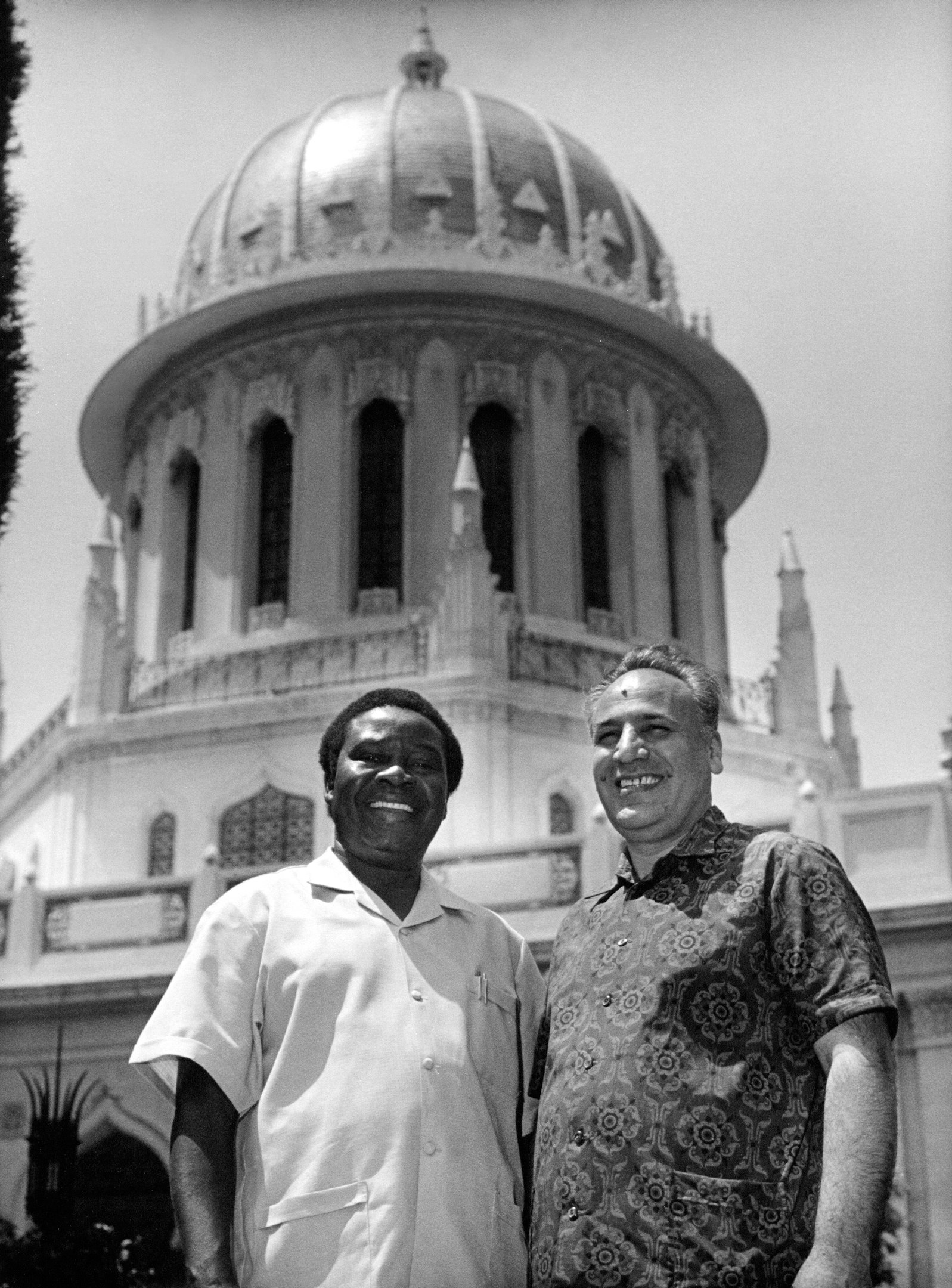
Hands of the Cause Enoch Olinga (left) and Raḥmatu'lláh Muhájir (right) in front of the Shrine of the Báb in 1973. Source: Bahá'í Media Bank, © Bahá'í International Community 2023.
Enoch Olinga had become a Knight of Bahá'u'lláh for British Cameroon, and five of the young men he had taught the Faith to had gone on to become Knights of Bahá'u'lláh in five West African countries and territories. Enoch had a burning desire to meet the Guardian and left for his pilgrimage, traveling through Tunis, and arrived in Rome on 1 February 1957, where he urgently sought the help of Ugo Giachery.
Enoch Olinga needed Ugo Giachery to perform a miracle: he had an old English passport that had expired a few years back, and didn’t have any money to travel. Ugo Giachery took Enoch to the British Consulate, where the wax-mustachioed Consul repeated to them for 20 minutes that Enoch would not be able to renew his passport. Enoch Olinga was doing what Ugo Giachery had told him to do: saying nothing, but reciting the Remover of Difficulties prayer, over and over again.
When Ugo Giachery told the British Consul that Enoch Olinga had been invited by the Guardian to Haifa, the Consul opened a drawer in his desk, pulled out a large binder. With blue pages, leafed through them carefully, and said:
I think I can do it.
Armed with Enoch Olinga’s new passport, they rushed to get a visa at the Israeli embassy, and on 3 February, Enoch Olinga finally arrived in Haifa, staying in the Eastern Pilgrim House, right next to the Shrine of the Báb. This meant that the Guardian considered Enoch Olinga an eastern pilgrim, with the privilege to walk the gardens with the Guardian and visiting the Shrines with him, hearing him chant the Tablets of Visitation with his wonderfully melodious voice. During his pilgrimage, Enoch Olinga had the bounty of spending a lot of time alone with the Guardian, and he would later remember how Shoghi Effendi “walked like a king,” and told his children the guardian was like a lion but at the same time very gentle.
Enoch Olinga was not only the first African Bahá'í to come on pilgrimage and meet Shoghi Effendi, he was also the first indigenous African Knight of Bahá'u'lláh to do so. The day he left, Shoghi Effendi kissed Enoch Olinga on both cheeks, something he rarely did.
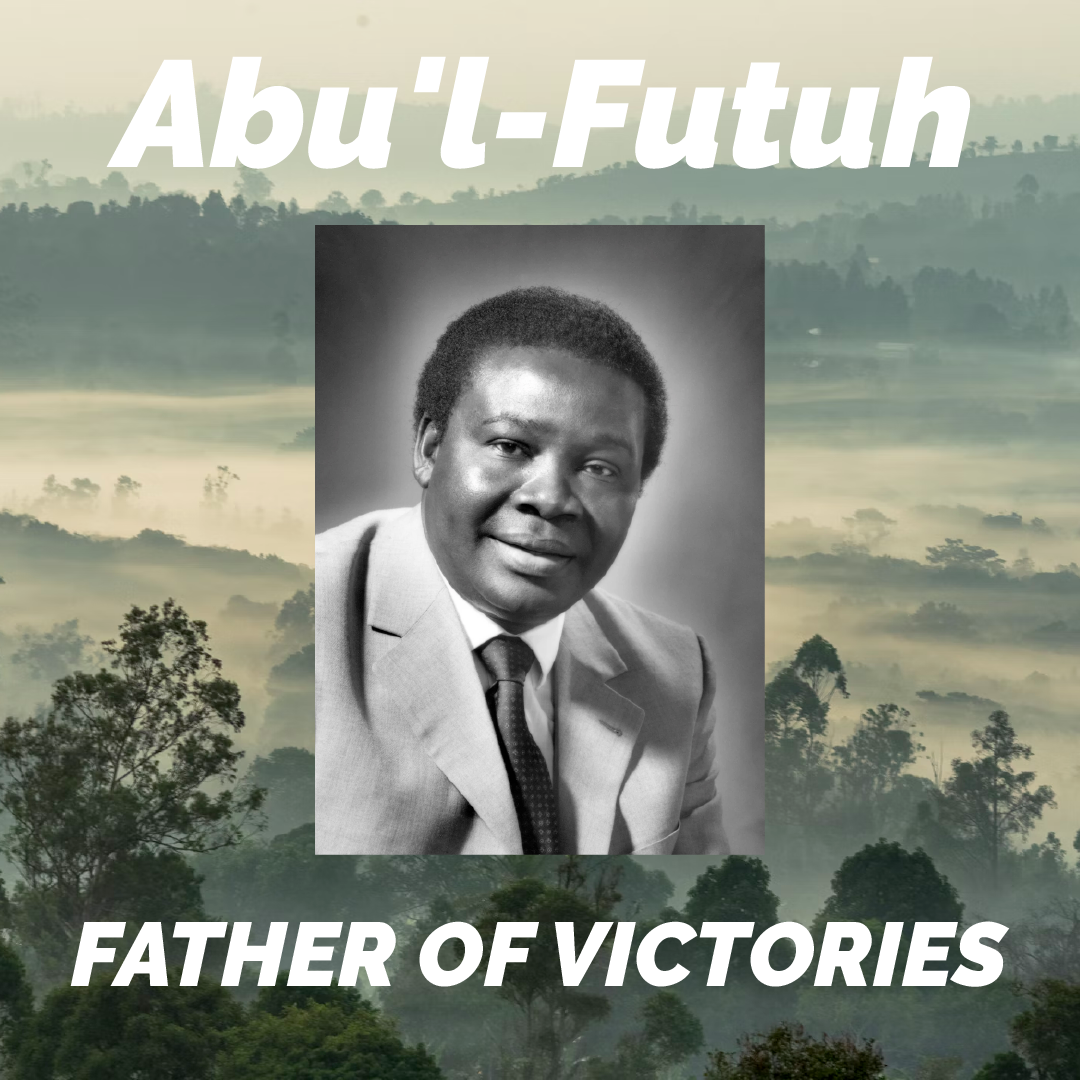
“Father of Victories” Portrait of Enoch Olinga from Source: Bahá'í Media Bank, © Bahá'í International Community 2023. Cameroon was where Enoch Olinga won his greatest victories in the field of teaching during the Ten Year Crusade. Background image of a misty Cameroonian forest in Bawang, near Bansoa by Edouard TAMBA on Unsplash.
On 15 February 1957, two days after Enoch Olinga had left, the Guardian’s secretary wrote a letter on his behalf to Músá Banání, in which he expressed his pleasure with Enoch Olinga’s visit and the pilgrimage of the first African Bahá'í and Knight of Bahá'u'lláh to come to the Holy Land, in which the Guardian outlines Enoch Olinga’s extraordinary achievements and victories for the Faith and in which he conferred on Olinga his title of Abu’l-Futuh—Father of Victories:
Enoch Olinga has achieved many victories for the Faith; first in his work in Uganda; then by pioneering in the British Cameroons, becoming a Knight of Baha'u'llah there. Five of his spiritual children went from the Cameroons, to virgin areas of the Ten Year Crusade, thus becoming themselves, Knights of Baha'u'llah. He himself has confirmed 300 souls, with five Assemblies. The Guardian considers this unique in the history of the Crusade, in both the East and West; and he has blessed the one who so selflessly served, and won these victories for the Cause of God, by naming him “Abu'l-Futuh,” the “Father of Victories.” The Guardian felt you and ‘‘Alí [‘Alí Nakhjávání] would be pleased to know this, as he was ‘‘Alí spiritual child."
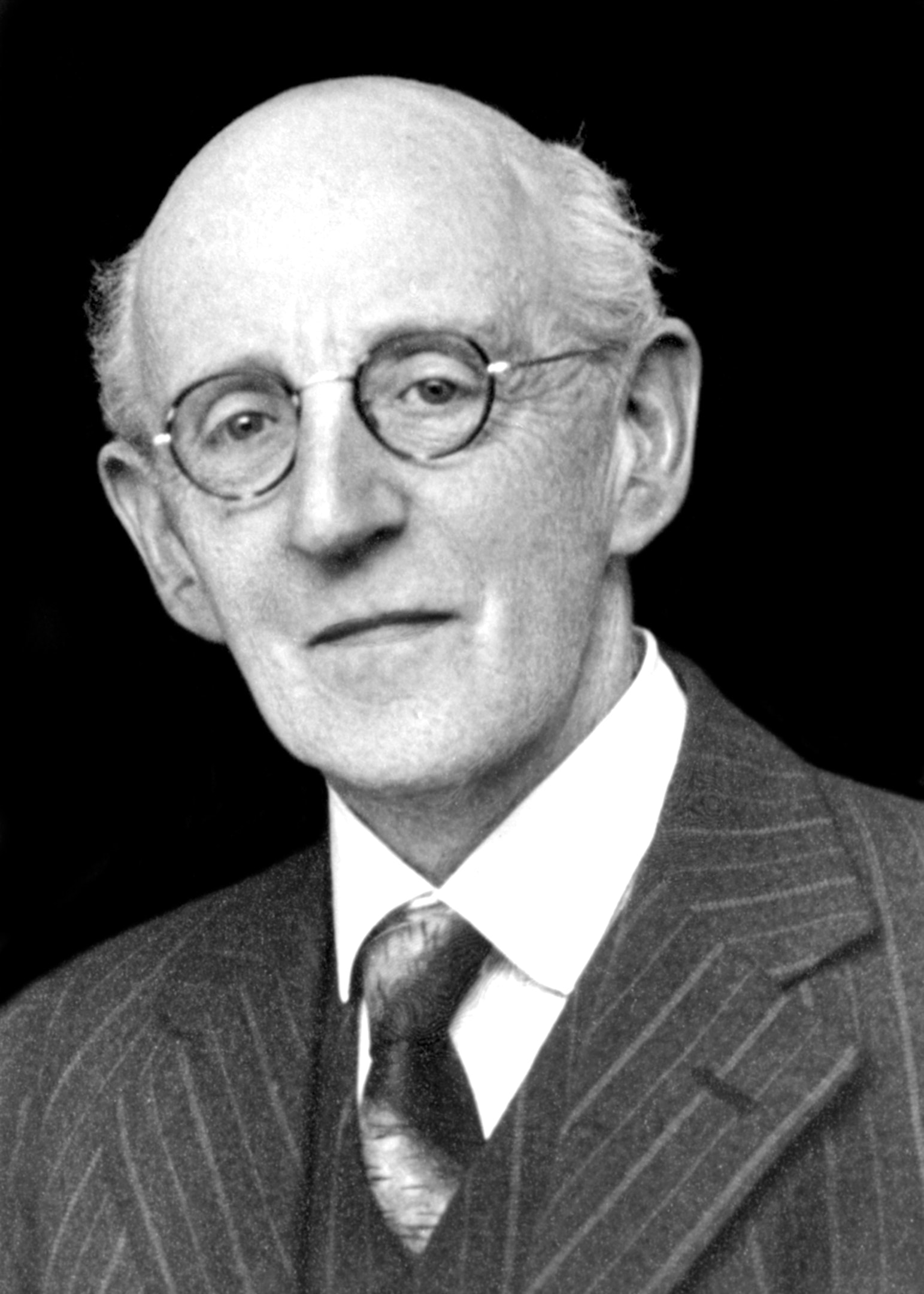
George Townshend (1876-1957). Source: Bahá'í Media Bank, © Bahá'í International Community 2023.
George Townshend was born in Dublin on 14 June 1876. During his university studies, he excelled at two things: running and literature. In 1903, George became a barrister, but the next year, in 1904, his restlessness took him to the Provo, Utah in the United States and its rugged Rocky Mountains, where heh became a Mormon Missionary. In 1912 he was appointed Assistant-Professor of English at the University of the South in Sewanee, Tennessee. He returned to Ireland in 1916.
As soon as he arrived in England in July 1916, George received a letter from an American friend enclosing a couple of pamphlets with 'Abdu'l-Bahá’s words. As George said:
When I looked at those, that was the beginning and the end with me.
George Townshend wrote to 'Abdu'l-Bahá and received a luminous Tablet in return, which reads in part:
Thy letter was received and the account of thy life has been known. Praise be to God that thou hast ever, like unto the nightingale, sought the divine rose garden and like unto the verdure of the meadow yearned for the outpourings of the cloud of guidance. That is why thou hast been transferred from one condition to another until ultimately thou hast attained unto the fountain of Truth, hast illuminated thy sight, hast revived and animated thy heart, hast chanted verses of guidance and hast turned thy face toward the enkindled fire on the Mount of Sinai.
After he became a Bahá'í, George Townshend married Nancy in 1918. The couple had a son, Brian and a daughter, Una. In 1919, George Townshend became Rector of Ahascragh in County Galway. George Townshend became one of 8 Canons of St. Patrick’s Cathedral. His books on the Faith, The Heart of the Gospel and The Promise of All Ages increased tensions between him and the clergy and Shoghi Effendi advised him to resign.
Shoghi Effendi thought of George Townshend as "the best writer we have…the pre-eminent Bahá’í writer.” In this capacity, between 1927 and 1941, George Townshend assisted Shoghi Effendi with the translations of the Hidden Words, Gleanings from the Writings of Bahá'u'lláh, Prayers and Meditations by Bahá'u'lláh, the Kitáb-i-Íqán, and Epistle to the Son of the Wolf, and The Dawn-Breakers. He also provided literary help for God Passes By. It was George Townshend who gave The Dawn-Breakers and God Passes By their titles.
In 1933, he became Archdeacon of Clonfert, and 14 years later, in 1947, at the age of 70, George Townshend renounced his Anglican orders and wrote a pamphlet for Christians titled The Old Churches and the New World, which he sent to 100,000 people.
George Townshend was a gifted writer, and his crowning literary achievement was no doubt his book Christ and Bahá'u'lláh, which he completed shortly before his passing. Below is a list of his literary works:
- 1934: The Promise of All Ages
- 1939: The Heart of the Gospel
- 1952: The Mission of Bahá’u’lláh
- 1957: Christ and Bahá’u’lláh
The Guardian appointed George Townshend a Hand of the Cause on 24 December 1951.
George Townshend passed away from Parkinson's disease in 1957, at the age of 81 on 25 March 1957, six months before the beloved Guardian.
In his eulogy cable two days after George Townshend’s passing on 27 March 1957, the Guardian called him a “fearless defender of the Faith”:
Inform Hands and national assemblies of the Bahá’í world, of the passing into Abhá Kingdom of Hand of Cause George Townshend, indefatigable, highly talented, fearless defender of the Faith of Bahá’u’lláh.


“the two parallel processes of integration and disintegration” Top photograph: A symbol of the forces of integration, the erection at the Bahá'í World Centre of two institutions, the Shrine of the Báb, and the International Bahá'í Archives, as Shoghi Effendi describes this process: “The accumulated evidences of the orderly unfoldment, and the uninterrupted multiplication of the agencies, of an Administrative Order designed to be the harbinger of a world civilization…” Bottom photograph: A symbol of disintegration, which Shoghi Effendi refers to as “The ominous manifestations of acute political conflict, of social unrest, of racial animosity, of class antagonism, of immorality and of irreligion, proclaiming, in no uncertain terms, the corruption and obsolescence of the institutions of a bankrupt Order.” Photograph of the ravages of the 1956 Hungarian Revolution Source: FOTO:FORTEPAN, Wikimedia Commons.
In his very last Riḍván message to the Bahá'ís of the world, the Guardian was able to give them one last sweeping, magisterial panorama of their accomplishments, halfway through the third phase of the first five years of the Ten Year Crusade.
In the opening of this message, the Guardian brings up a major point, familiar by now to the Bahá'ís, that the victories won are one side of the coin in the fortunes of the world, the other being the world crisis surrounding the lives of everyone on the planet:
As we look back on the triumphs and trials that have marked its course, accelerated, to a notable extent, the two parallel processes of integration and disintegration associated respectively with the rising fortunes of God's infant Faith and the sinking fortunes of the institutions of a declining civilization.
The sharp contrast the Guardian lays out, is on the one hand:
The accumulated evidences of the orderly unfoldment, and the uninterrupted multiplication of the agencies, of an Administrative Order designed to be the harbinger of a world civilization…
and on the other:
The ominous manifestations of acute political conflict, of social unrest, of racial animosity, of class antagonism, of immorality and of irreligion, proclaiming, in no uncertain terms, the corruption and obsolescence of the institutions of a bankrupt Order.

All the victories listed in the story below, overlaid on a NASA Image of the Gulf of Mexico. Source: NASA on Unsplash.
Gathering ever-increasing momentum in parallel with a crumbling Old World Order, the victories won between Riḍván 1956 and Riḍván 1957 were stupendous, and the Guardian lays them out thematically:
- Thanks to the United Nations’ support, the Iranian Bahá'ís were able to win a victory over the ecclesiastical forces that had leagued against it and a fanatical population determined to destroy it
- Iranian Bahá'í properties were expropriated throughout the country and prominent lawmakers made demands to outlaw the Faith, expropriate it, confiscate its literature, deport the its most active members and root it out in the countryside
- The Chief Magistrate assured the Iranian Bahá'ís their National Bahá'í Center would be returned to them
- 251 territories in which the Faith is present
- Of the 131 territories listed as pioneering objectives for the Ten Year Crusade only 14 have not been opened, 11 of which are in the Soviet Union
- Every single one of the 120 territories mentioned by 'Abdu'l-Bahá in the Tablets of the Divine Plan has been opened to the Faith
- 4,200 localities in the world where Bahá'ís reside (1,000 increase in two years)
- The Bahá'í Faith reached its most northern center ever in history, with the arrival of William Carr, a Canadian Bahá'í in Thule, Greenland at 76 degrees latitude, 3. Degrees above Arctic Bay, Franklin
- Over 1,000 Local Spiritual Assemblies were established, with an increase of more than 100 in a single year
- Bahá'ís resided in 100 islands in all the Oceans of the world
- Bahá'í literature was now translated into 130 languages, with 40 new languages added in the last 12 months, 67 of which had been added to the original list of languages
- Bahá'í literature was widely disseminated, most notably by a Bahá'í in Christchurch, New Zealand, who offered books to the officer in charge of the American Antarctic Expedition for its library, while others books were dispatched, beyond the Antarctic Circle, as far south as the Expedition's base, at McMurdo Sound, 77 degrees latitude, on the shores of the Ross Sea
- 195 incorporated Local and National Spiritual Assemblies
- 46 National Bahá'í Centers out of the goal of 49
- 49 National Bahá'í Endowments out of the goal of 51
- The Bahá'í Marriage Certificate is now recognized in 30 states and dependencies
- 45 countries and dependencies recognize Bahá'í Holy Days, including the authorities of H. M. Kitalya Farm Prison in Uganda to its recently converted Bahá'í inmates to observe these same Holy Days.
- In the Holy Land, the superstructure of the Shrine of the Báb was completed
- The remaining 22 pillars of the International Bahá'í Archives were erected
- The last 450 tons of stone were received in Haifa for the International Bahá'í Archives, the 44 tons of green glazed tiles were placed on the roof of the edifice
- A dilapidated house close to the Shrine of Bahá'u'lláh was purchased and restored
- Negotiations were inaugurated for the purchase of three plots of land north and south of and abutting the Shrine of Bahá'u'lláh, and a third plot
- A row of sheds occupied by Covenant-breakers was destroyed
- The Treasury Department of Israel issued an expropriation order for the buildings north of the Mansion of Bahjí
- The International Endowments of the Faith in Bahjí and on Mount Carmel have continually been extended and embellished
- Ever-swelling crowds of visitors come to the Shrine of the Báb on Mount Carmel, which, in a single day, over the course of 3 hours, received 1,000 visitors
- In the United States elected national representatives of the American Bahá'í Community, acting as the representatives of the International Bahá'í Community, have vigorously defended their persecuted brethren in Iran through representations made to the United Nations officials and agencies in New York and Geneva, through their contact with high-ranking officials of the American State Department and through measures of publicity in the American Press, all culminating in the victory won over the adversaries of the Faith, to which reference has been made earlier in these pages.
- The North American House of Worship’s landscaping is complete, including the nine fountains envisioned by 'Abdu'l-Bahá
- Over 3,000 visitors have visited the House of Worship in a single day
- Authorization was received to begin building the House of Worship’s first dependency, a Home for the Aged
- The value of national and local endowments owned by the Bahá'ís in America is now four and a half million dollars.
- Over 45 First Nations have had contact with the Bahá'ís in North America
- No less than 18 First Nations boast a Bahá'í among their ranks
- Bahá’í marriage is now recognized in 28 districts and states
- Bahá'í Holy Days are recognized in 39 districts and states
- In Africa, there are now 3,500 Bahá'ís, 550 localities where Bahá'ís reside, 97 Tribes with at least one Bahá'í among their number, and Bahá'í literature has been translated into 150 African languages
- Preliminary measures have been taken for the election of 13 regional spiritual assemblies in the Pacific for the coming year
- Bahá'ís reside in 210 localities over 40 islands in the Pacific, with 1,700 Bahá'ís, 50 Local Spiritual Assemblies, 5 National Centers, 3 Bahá'í Schools, 21 incorporated Local Spiritual Assemblies, 4 endowments, a Temple site, 3 territories where Bahá'í marriages are recognized, and 3 where children can observe Bahá'í Holy Days, as well as Bahá'í literature translated into 50 indigenous languages, teaching activities have been led in 100 of the 400 Pacific islands
- Three new Mother Temples are to be built in Frankfurt, Sydney, and Kampala, at a cost of $1 million
- The Guardian pledges one-third of the sum with a glad and grateful heart at this time added to the $140,000 already in the Temple Fund, generously donated by Hand of the Cause Amelia Collins
- Mason Remey was announced as the architect of the Mother Temples of Africa and Australia, and the German Architect, Teuto Rocholl as the architect for the. Mother Temple of Europe. The designs will be exhibited for the first time to the assembled delegates of the 13 Bahá'í National Conventions at Riḍván 19567
- The excavation of the foundations of the African Temple have started
- The construction of the Australian Temple has, moreover, been placed in the hands of a reliable Sydney architect, the Temple should be completed by March, 1959
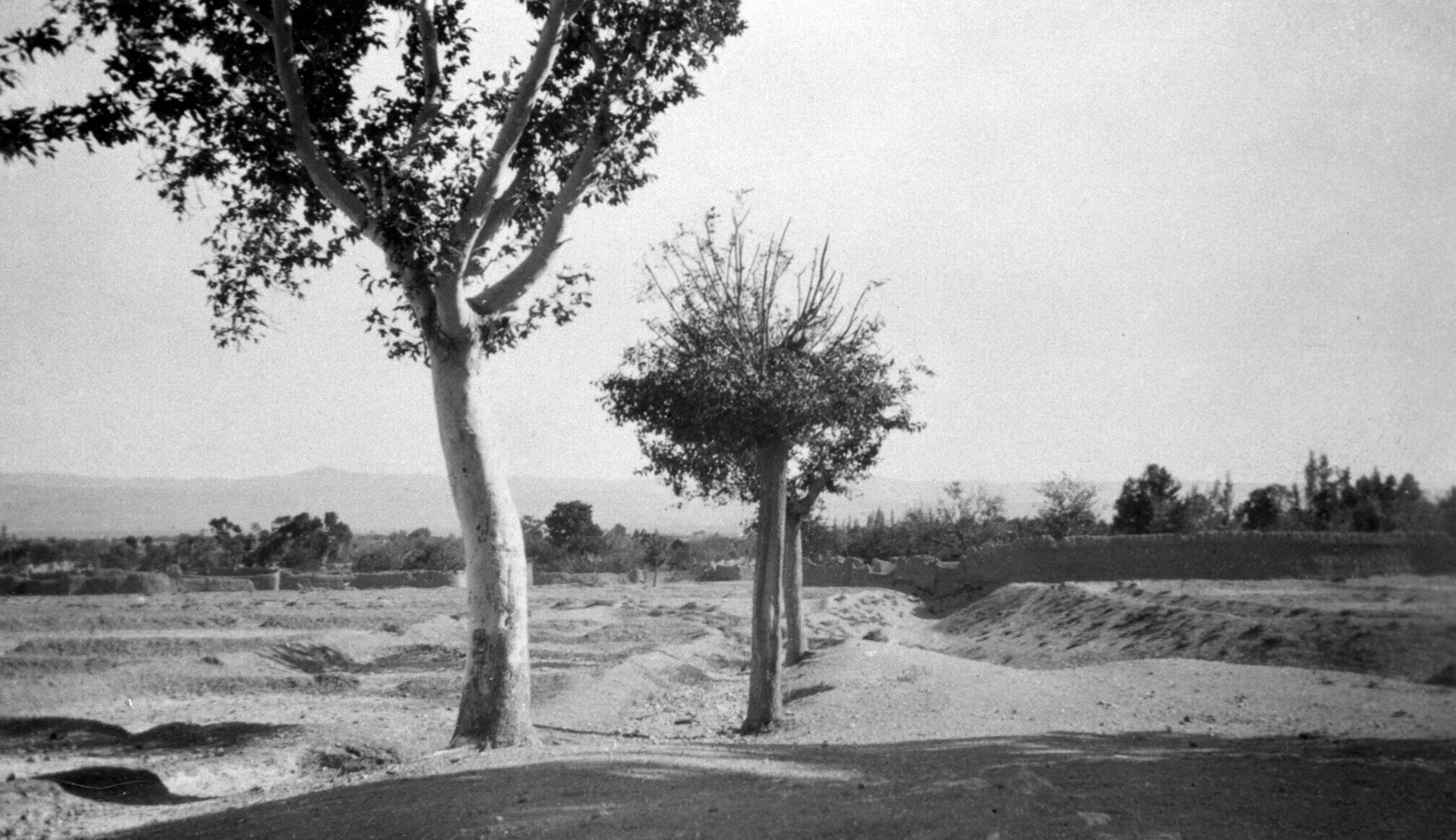
The village of Badasht, where in 1848, Bahá’u’lláh hosted a gathering of the most eminent followers of the Báb, known as Bábís. The meeting established for the growing number of believers the independent character of the Bábí religion, around 1930, Source: Bahá'í Media Bank, © Bahá'í International Community 2023.
At the end of this impressive list of achievements, the Guardian closes his ultimate Riḍván message with a plea to the Bahá'ís to remember, always, the most important aspect of Bahá'í life is teaching:
The preeminent task of teaching the Faith to the multitudes who consciously or unconsciously thirst after the healing Word of God in this day—a task so dear to the heart of `Abdu'l-Bahá; at once so sacred, so fundamental, and so urgent; primarily involving and challenging every single individual; the bed-rock on which the solidity and the stability of the multiplying institutions of a rising Order must rest—such a task must, in the course of this year, be accorded priority over every other Bahá'í activity.
And the Guardian’s final appeal, calling upon the souls of the heroes of the Conference of Badasht, reconnects the heroes of the Ten Year Crusade with those of the Heroic Age of the Faith, calling one and all of his heroic band of spiritual warriors to rise to the greatest ideals of this most beautiful Faith:
I appeal, as I close this review of the superb feats already accomplished, in the course of so many campaigns, by the heroic band of the warriors of Bahá'u'lláh, battling in His Name and by His aid for the purification, the unification and the spiritualization of a morally and spiritually bankrupt society, now hovering on the brink of self-destruction, for a renewed dedication, at this critical hour in the fortunes of mankind, on the part of the entire company of my spiritual brethren in every continent of the globe, to the high ideals of the Cause they have espoused, as well as to the immediate accomplishment of the goals of the Crusade on which they have embarked, be they in active service or not, of either sex, young as well as old, rich or poor, whether veteran or newly enrolled—a dedication reminiscent of the pledges which the Dawn-breakers of an earlier Apostolic Age, assembled in conference at Badasht, and faced with issues of a different but equally challenging nature, willingly and solemnly made for the prosecution of the collective task with which they were confronted.

The four Bahá'í communities from which Shoghi Effendi was most happy to hear on 21 April 1957: Photo of Salzburg by Sarah Mutter on Unsplash; Photo of Innsbrück by Bharat Patil on Unsplash; Photo of Milan by Mikita Yo on Unsplash; Photo of Hiroshima Photo by Vladimir Haltakov on Unsplash.
On 21 April 1957, the Guardian told the pilgrims he had just received 1,000 telegrams on the occasion of Riḍván from Assemblies all over the world.
The telegrams he was most excited about were those he received from Salzburg, Innsbruck, Milan and Hiroshima.
From Luxembourg, Edna True cabled that they had just purchased their National Bahá'í Center.
The Guardian cabled back:
What about Stockholm, Lisbon, and translation into Lapp language?
The Guardian never stopped working, not even on Riḍván.
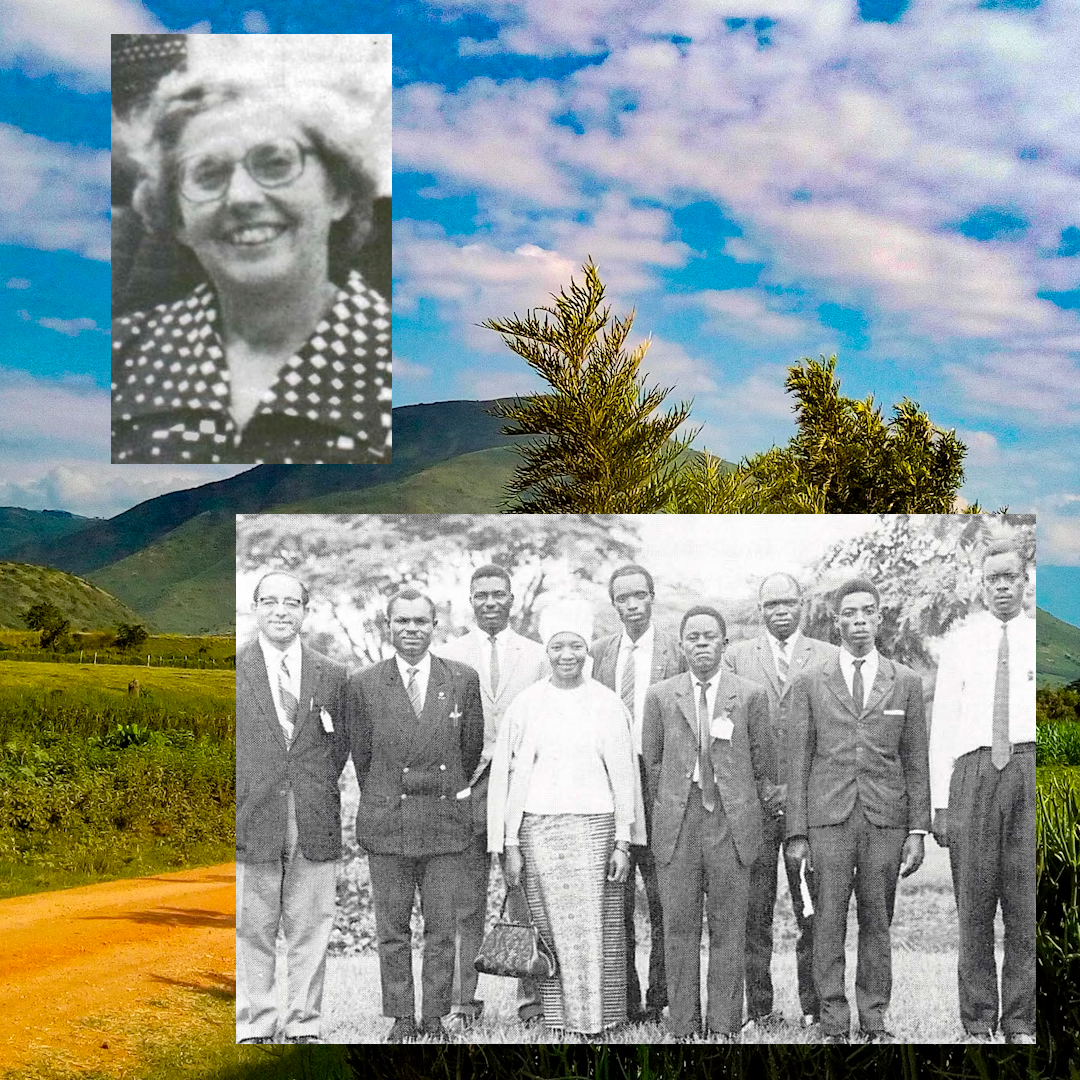
Top photograph: Isobel Sabri. Source: Bahaimedia. Bottom photograph: Ḥasan Sabri, on the extreme left, as member of the National Spiritual Assembly of the Baha'is of Uganda and Central Africa, May 25, 1968. Left to right: Hassan Sabri (treasurer), Tito Wanantsusi (vice chairman), Kolonerio Oule (chairman), Elizabeth Olinga, George William Ebetu, Moses Senoga (ass't. treasurer), Sospateri Isimai (sec'y), Alinote Colleque and Albert Ochamodek. Source: Bahaipedia. Background photograph of the Kasese district in Uganda by Keith Kasaija on Unsplash.
Isobel and Ḥasan Sabri pioneered to Tanzania in 1951, then moved to Uganda in 1953.
Isobel came on pilgrimage alone between 19 – 28 April 1957, and she kept meticulous notes, and they are precious in how much the Guardian relied on pilgrims for information straight from their field of service. Isobel Sabri kept detailed notes on the questions the Guardian asked her and listing them here will provide us with a clear picture of how the Guardian collected information, what he cared about, what information he considered relevant, and what he was most interested in:
How are the friends in Africa?
How is your husband?
He is very active in the service of the Cause, isn’t he?
How was your flight?
Did you fly directly to Lydda?
Have the excavations of the Kampala Temple begun?
How many centers are there in Uganda?
Does the photograph show the excavations for the temple or the cutting of the access road?
Did you meet Mr. and Mrs. Yazdí in Nairobi? They are very energetic and successful.
Did you meet Mr. and Mrs. Alizadeh—the English lady and her Persian husband there?
The Guardian emphasized that the teaching work in Africa—always the primordial concern of the Guardian and what he always indicated must be the priority of all Bahá'í communities worldwide—must not suffer with the formation of the National Spiritual Assemblies and the construction of the Mother Temple of Africa.
During her pilgrimage, the Guardian spoke at length and in the strongest terms about the dangers posed by materialism in the establishment of Bahá'u'lláh’s Administrative Order and in the spread and growth of the Bahá'í Faith worldwide. He said that by no means was Europe the seat of Christian civilization, but rather, it was the seat of material civilization, and that America was the stronghold and center of gravity of material civilization. It was specifically because of its materialism and pervasive political corruption that America had been chosen as the seat of Bahá'u'lláh’s World Order.
The Guardian also spoke at length—because Isobel Sabri was a pioneer in Uganda—about the destiny of all indigenous and First Nations people in the world. The black and brown races, according to the Guardian, would rise up and play a pivotal role in the establishment of Bahá'u'lláh’s World Commonwealth.
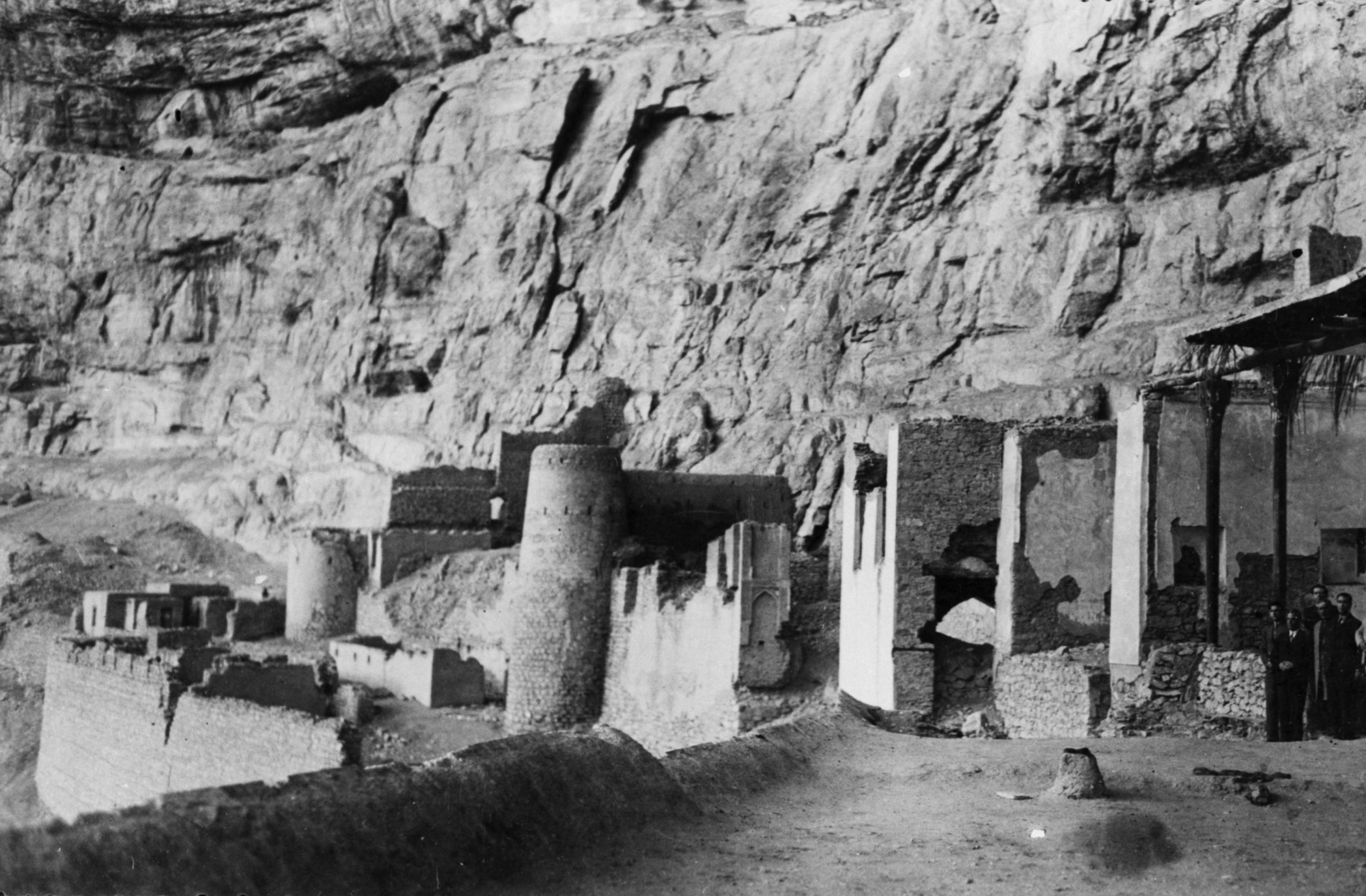
The castle of Máh-Kú where the Báb was imprisoned from 1947 to 1948. In the story below, the Guardian gives Isobel Sabri the priceless gift of some plaster from the cell of the Báb in Máh-Kú to place in the foundations of the House of Worship in Kampala. Source: Bahá'í Media Bank, © Bahá'í International Community 2023.
On the last night of her pilgrimage, the Guardian gave Isobel Sabri a small, beautifully inlaid Persian mosaic box wrapped in a brightly-colored Persian silk handkerchief.
The Guardian opened the box and removed a folded piece of paper. On the paper, in Hand of the Cause Amatu’l-Bahá Rúḥíyyih Khánum.’s handwriting was a description of the precious trust wrapped inside of it:
It was a priceless piece of plaster from the ceiling of the Báb’s prison cell in Máh-Kú.
The Guardian instructed Isobel to hand the precious box to Hand of the Cause Músá Banání, and instructed her to tell the Hand of the Cause to place it in the foundation of the Mother Temple of Africa with his own hands, and to ensure a photograph was taken of this important event.


“Protection” Original photograph by Max Saeling on Unsplash.
On 4 June 1957, exactly five months before he passed away, Shoghi Effendi sent a cable to the Hands of the Cause and National Spiritual Assemblies regarding a serious topic.
The Guardian speaks about recent historic events in the history of the Faith: the completion of the superstructure of the Shrine of the Báb, the dedication of the House of Worship of North America, the worldwide celebrations during the Holy Year, the launch of the Ten Year Crusade, the extraordinary success of the African and Pacific campaigns, the rise of the Administrative Order in the Arabian Peninsula, the completion of the International Bahá'í Archives.
Momentous as all these achievements were, the Guardian cautions that they aroused the jealousy of the enemies of the Faith:
Recent events, the triumphant consummation of a series of historic enterprises…served to inflame the unquenchable animosity of its Muslim opponents and raised up a new set of adversaries in the Christian fold and roused internal enemies, old and new Covenant-breakers, to fresh attempts to arrest the march of the Cause of God, misrepresent its purpose, disrupt its administrative institutions, dampen the zeal and sap the loyalty of its supporters.
Not to be outdone, the Covenant-breakers also reared up their heads in opposition to the Faith with these historic happenings, and resumed their plotting.
Because of these two added dangers—internal and external enemies of the Faith—the Guardian announced that, in addition to their new responsibility of assisting the National Spiritual Assemblies with the prosecution of the Ten Year Crusade, the Hands of the Cause must now fulfill their primary obligation: to watch over and protect the Bahá'í world community, in close collaboration with the National Spiritual Assemblies.
The Guardian continues:
Evidences of increasing hostility without, persistent machinations within…necessitate in this crucial hour closer association of the Hands of the five continents and the bodies of the elected representatives of the national Bahá'í communities the world over for joint investigation of the nefarious activities of internal enemies and the adoption of wise, effective measures to counteract their treacherous schemes, protect the mass of the believers, and arrest the spread of their evil influence.
At the end of his message the Guardian calls upon the Hands of the Cause and National Spiritual Assemblies to establish direct contact and deliberate as frequently as possible, exchange reports and exercise unrelenting vigilance in carrying out their respective duties.
In closing, the Guardian reminds the Hands of the Cause and National Spiritual Assemblies that the very safety of the Faith is entirely in their hands:
The security of our precious Faith, the preservation of the spiritual health of the Bahá'í communities, the vitality of the faith of its individual members, the proper functioning of its laboriously erected institutions, the fruition of its worldwide enterprises, the fulfilment of its ultimate destiny, all are directly dependent upon the befitting discharge of the weighty responsibilities now resting upon the members of these two institutions, occupying, with the Universal House of Justice, next to the Institution of the Guardianship, foremost rank in the divinely ordained administrative hierarchy of the World Order of Bahá'u'lláh.

“Rigidity and fluidity” Top photograph by Andrey Haimin on Unsplash; Bottom photograph by Inés Álvarez Fdez on Unsplash.
In the Priceless Pearl, Rúḥíyyih Khánum highlights an element of the Guardian’s extraordinary leadership qualities:
In Shoghi Effendi’s administration of the affairs of the Faith there was a quality of rigidity in essentials and fluidity in non-essentials that must always characterize a truly great leader.
The Guardian never compromised on the fundamental teachings of the Faith, but he was extremely flexible with administrative affairs, in the cases when too much rigidity could harm the Faith, damage the community, or irreparably hurt either Bahá'ís or Bahá'í seekers.
By 1957, there were communities in the world that had decades of experience managing communities and Bahá'ís of many generations. The youngest communities in the world could be found in places like Africa or the Pacific islands, where everyone on Assemblies and in the communities—except for rare pioneers—were first-generation Bahá'ís.
On 8 August 1957—less than three months before he passed away—the Guardian’s secretary wrote a long letter on his behalf to an African Regional Assembly regarding how to manage such young communities and the teaching work and the delicate balance of patience, encouragement, firmness, and flexibility which was needed to help the Administrative Order and the Bahá'í community and its members thrive.
[The Guardian] feels that those responsible for accepting new believers should consider that the most important and fundamental qualification for acceptance is the recognition of the station of Bahá'u'lláh in this day on the part of the applicant. We cannot expect people who are illiterate (which is no reflection on their mental abilities or capacities) to have studied the Teachings, especially when so little literature is available in their own language in the first place, and grasp all their ramifications, the way an African, say in London, is expected to. The spirit of the person is the important thing, the recognition of Bahá'u'lláh and His position in the world in this day. The friends therefore must not be too strict, or they will find that the great wave of loving enthusiasm with which the African people have turned to the Faith, many of them already accepting it, cools off; and being very sensitive, they will feel in some subtle way that they are rebuffed, and the work will suffer.
The purpose of the new National Assemblies in Africa, and the purpose of any administrative body, is to carry the Message to the people and enlist the sincere under the banner of this Faith.
Your Assembly must never lose sight of this for a moment, and must go on courageously expanding the membership of the communities under your jurisdiction, and gradually educating the friends in both the Teachings and the Administration. Nothing could be more tragic than if the establishment of these great administrative bodies should stifle or bog down the teaching work. The early believers in both the East and the West, we must always remember, knew practically nothing compared to what the average Bahá'í knows about his Faith nowadays; yet they were the ones who shed their blood, the ones who arose and said: 'I believe', requiring no proof, and often never having read a single word of the Teachings. Therefore, those responsible for accepting new enrollments must just be sure of one thing—that the heart of the applicant has been touched with the spirit of the Faith. Everything else can be built on this foundation gradually.
He hopes that during the coming year it will be increasingly possible for the African Bahá'í teachers to circulate amongst the newly-enrolled Bahá'ís and deepen their knowledge and understanding of the Teachings.
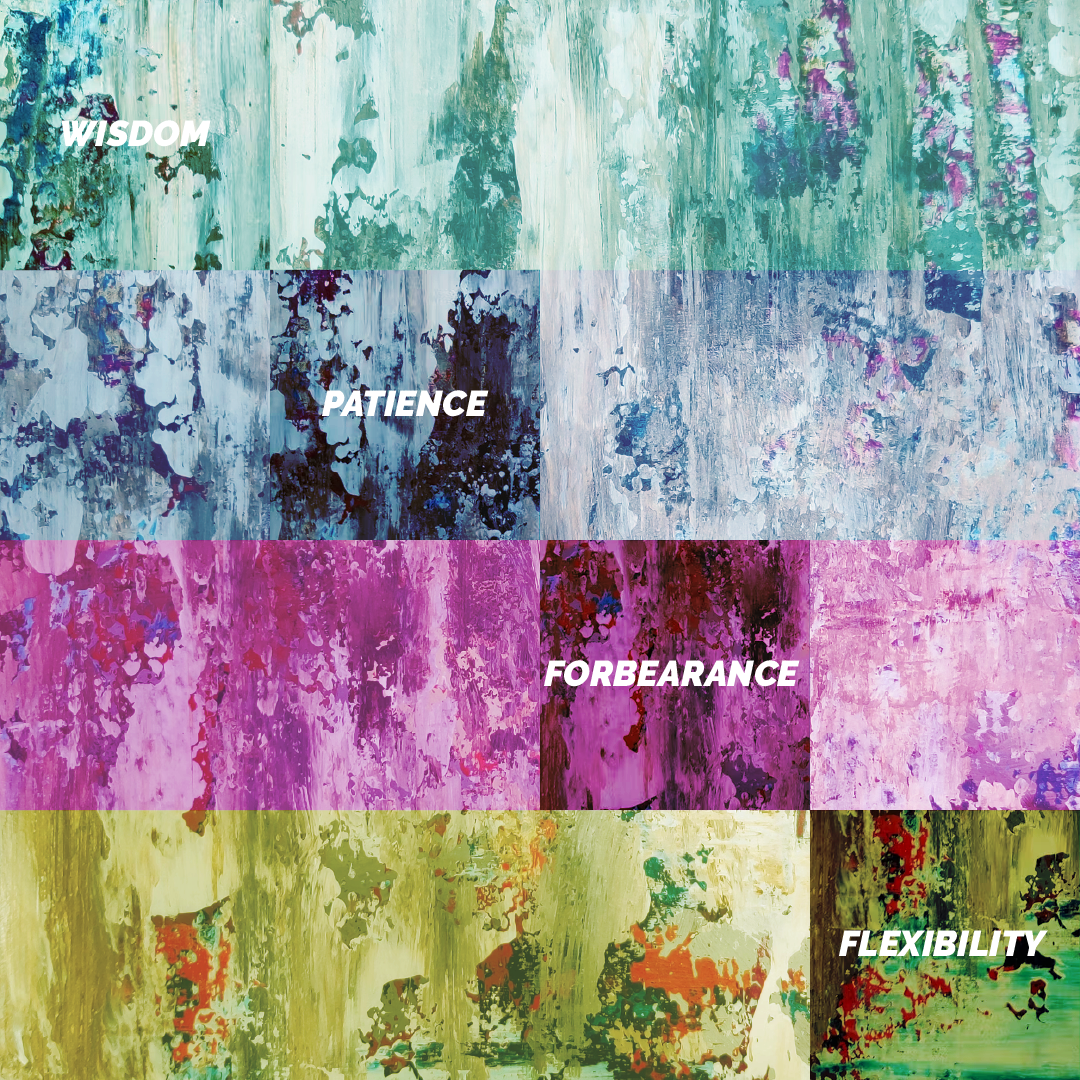
“wisdom, patience, forbearance and flexibility” Background photograph of abstract painting by Aurelius Wendelken on Unsplash.
The Guardian explained in the remainder of the letter how Bahá'í institutions should exercise wisdom in not rigidly applying all Bahá'í laws at that time, and gave instructions and examples to help guide them in administering the affairs of the Faith in the wisest possible way:
As regards the questions of tribal practice, the Guardian wishes you to be extremely forbearing and patient in weaning the Bahá'ís away from their old customs. this can only be done by taking each case individually as it comes up, using the greatest wisdom and kindness, and not trying rigorously to impose all Bahá'í laws in every detail at this time.
Of course it is obvious that if a Bahá'í man already has one wife he cannot take another, no matter what the tribal law may be. Your Assembly should distinguish between this fundamental point and other phases of the tribal community life in which the new Bahá'í may still be deeply involved, and from which he cannot extract himself until the Bahá'í element in his community is strong enough to be a power in its own right.
He agrees with the feeling of your Assembly that to start imposing the heavy sanction of depriving the friends of their voting rights is most unwise at the present time. The best policy is one of loving education.
The Guardian was now close to the end of his ministry.
For 36 years he had reared up an Administrative Order which was working independently and successfully around the entire world, but until the very end of his earthly days, he never stopped educating the Bahá'ís on the spirit needed to run that Administrative Order according to the vision of Bahá'u'lláh.

Photograph of the Bernese Alps by Ansgar Scheffold on Unsplash.
In the last year of the Guardian’s life, sometime in 1957, two Swiss Bahá'ís came on pilgrimage, and their visit opened the floodgates of Shoghi Effendi’s love for their country in an unprecedented, and wholly uncharacteristic manner for the Guardian, who was usually deeply private about his personal life and feelings.
Rúḥíyyih Khánum herself was ill, and did not witness this extraordinary conversation, but she didn’t need to. Shoghi Effendi came to her and told his wife that he had, in a word, “said everything.”
Shoghi Effendi had told the two Swiss pilgrims about all his beloved Swiss adventures in the Bernese Highlands high above Interlaken, his beloved city. He spoke to them about the mountains he had climbed, his many hikes, the landscapes he loved so much.
This was deeply unusual for Shoghi Effendi—exceedingly rare in fact—but it affords us a delightful view into one of those few things he loved with all his heart—Switzerland and its mountains. It is a rare and stunningly clear indication of a lifelong love deep in the heart of Guardian, who always considered himself a mountaineer.
Shoghi Effendi was moved to inform the Swiss couple that he desired Switzerland to have its own Temple land, and he wished the land to be located near Bern, the capital, with a clear view of the Bernese Alps, which he had spent so many months of his life hiking and climbing.
On 12 August 1957, the Guardian’s secretary wrote a letter on his behalf to the National Spiritual Assembly of the Bahá'ís of Italy and Switzerland clarifying Shoghi Effendi’s wishes:
…[The Guardian] is very anxious for Switzerland to purchase a plot, however shall in size, and modest a beginning it may be, for the future Mashriqu’l-Adhkár of that country. He feels this should be in the outskirts of Bern, overlooking the Bernese Oberland; and he is very happy to be able to present this land himself to the Swiss Community. No publicity whatsoever should be given to this matter lest an opposition resembling that which has arisen in Germany should be provoked amongst the orthodox element in Bern. Whenever the committee responsible for finding this land has located a suitable plot, he would like your Assembly to inform him of the details.
The fact that the Guardian was offering to gift the National Spiritual Assembly the Temple Land should be emphasized: the Guardian never made the offer during his Guardianship to any other National Spiritual Assembly.
This was an unprecedented, absolutely unique gift, and spoke eloquently of the Guardian’s deep ties with Switzerland.
The Swiss Temple Land, almost 2,000 square meters in area, is located exactly where Shoghi Effendi wanted: on the outskirts of Bern, overlooking the Gürbe Valley, and with extraordinary views of the famous Finsteraarhorn, the culminating point of the Aarmassif, and the world-renowned trio of mountains: the Mönch, the Eiger and the Jungfrau mountains, the Guardian’s beloved Bernese Alps.

The last photograph ever taken of Shoghi Effendi in 1957. It was Amatu’l-Bahá Rúḥíyyih Khánum who took this picture. Source: Bahaimedia.
The Guardian’s life was drawing, inexorably, to a close.
Shoghi Effendi had done all he could to empower the Bahá'ís, to increase their awareness of their sacred responsibility, he had given them the Administrative Order, provided them with tools, advice, perspective, principles, integrity, energy.
But in the end, everything depended on the Bahá'ís and their effort in the field.
In one of his last letters to the Germany National Spiritual Assembly, the Guardian responded to 23 of their letters spanning from 1956 to 1957 and spoke about the attitude of the Bahá'ís:
He does not want the friends to be fearful, or to dwell upon the unpleasant possibilities of the future. They must have the attitude that, if they do their part, which is to accomplish the goals of the Ten Year Plan, they can be sure that God will do His part and watch over them.
This letter reads like the Guardian’s parting words.
The voice of Shoghi Effendi rings out to us across the decades, and we can clearly hear the encouraging words of a loving Guardian who had done his work and was asking the Bahá'ís now to do theirs.


Photo of Kampala by Keith Kasaija on Unsplash; Photo of Sydney by Dan Freeman on Unsplash; Photo of Wilmette by cory steinberg on Unsplash; Photo of Frankfurt by Raja Sen on Unsplash; Photo of Singapore by Mike Enerio on Unsplash.
The last great message of Shoghi Effendi's life was dated October 1957, but, according to Rúḥíyyih Khánum, he composed it two months earlier, in August. It was a happy and victorious message, full of hope, filled with new wonderful plans—no one would ever have guessed it would be the last one they would ever receive from their beloved Guardian, his last, priceless gift to his beloved Bahá'í community.
In this message, Shoghi Effendi announced to an expectant Bahá'í world that the Ten Year Crusade would reach its halfway point—1958—in a few short months. The Guardian had decided that this momentous halfway point should be marked with a series of five Intercontinental Teaching Conferences in January, March, May, July and September of 1958, in Africa, the Antipodes, America, Europe and Asia, respectively, and the Guardian assigned the bodies responsible for these conferences in the message.
The Guardian indicated the five-fold purpose of the five Intercontinental Teaching Conferences in 1958:
- To offer humble thanksgiving to Bahá'u'lláh for having allowed Bahá'ís to prosecute uninterruptedly the Ten Year Crusade in the midst of a time of great worldwide anxiety and confusion;
- To review the victories won in the first half of the Ten Year Crusade;
- To celebrate these victories together;
- To deliberate on ways and means to ensure the triumphant consummation of the Ten Year Crusade during the following 5 years;
- To lend a worldwide powerful impetus to both the vital process of individual conversion—the preeminent aim of the Ten Year Crusade—and the construction and completion of the European, African and Australian Mother Temples.
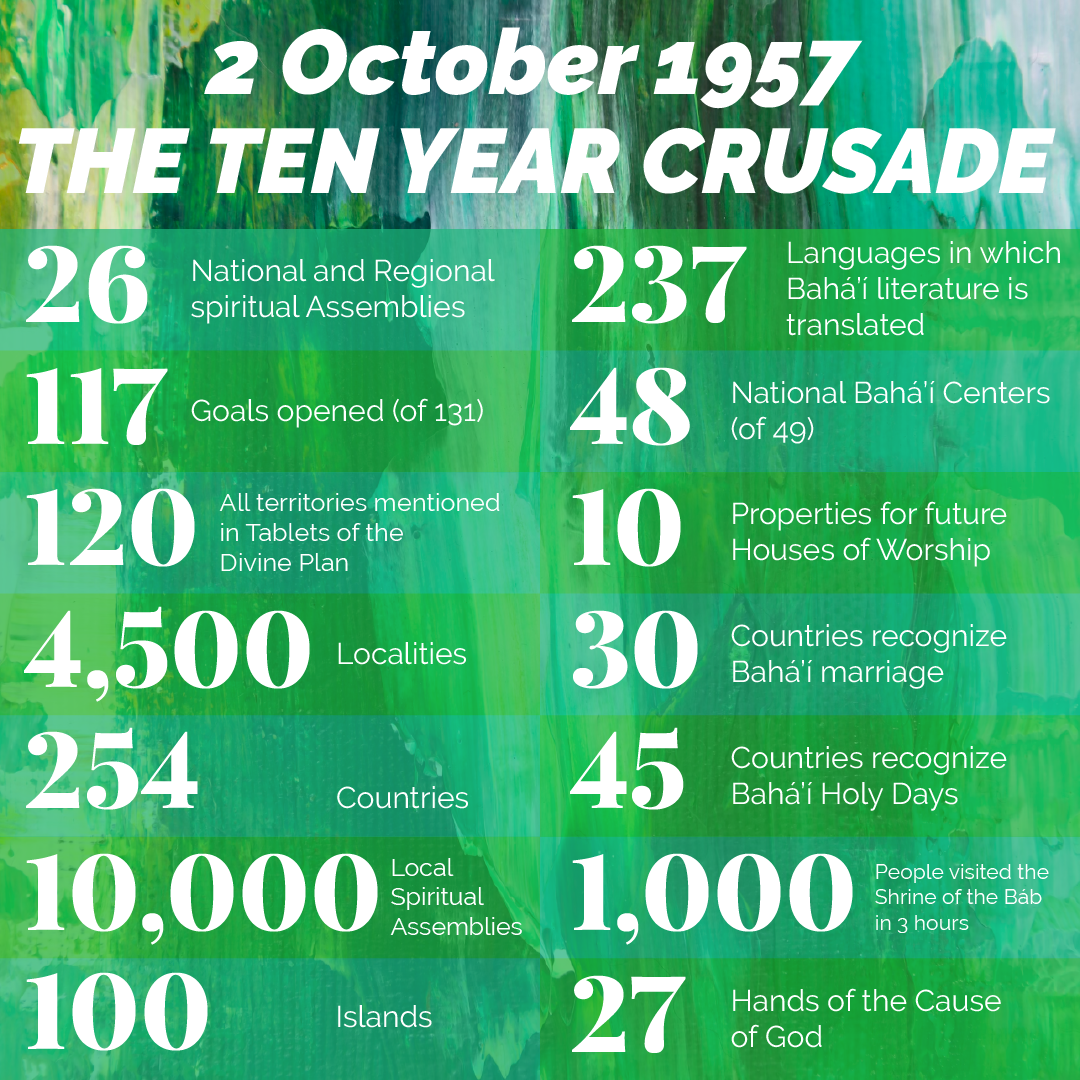
Background painting photograph by Paul Blenkhorn on Unsplash.
Six months before the end of the third phase, the Guardian updated the Bahá'í world one final time on the progress of the Ten Year Crusade. The achievements of the entire Ten Year Crusade at its conclusion in 1963, can be found in Epilogue 1.
In his messages written at Riḍván of 1956 and 1957, titled respectively “So Significant a Victory” and “Evidences of the Resistless March of the World Crusade”, as well as his last great message written in October 1957, a mere month before his shocking and unexpected passing, titled “Epoch-Making Victory Won Over Covenant-Breakers,” the Guardian cast his unerring, historic, and world-embracing vision on the victories won by the stalwart Bahá'ís over the last three years of the Ten Year Crusade.
Shoghi Effendi would not live to see the end of the Crusade.
But the Bahá'ís had risen to the challenge, they had lovingly raced out all across the planet to win extraordinary, groundbreaking, historic, victories in every single field laid out in the goals and the objectives of this world-embracing crusade.
What is extraordinary, is that almost all the goals of the Ten Year Crusade were realized in just three years, including some that had not even been planned for, so overwhelming was the enthusiasm of the Bahá'í world, encouraged, loved, guided, spurred on unceasingly by its loving Guardian.
Here, from Shoghi Effendi’s three messages of April 1956, April 1957, and October 1957, are the Bahá'í world’s and the Knights of Bahá'u'lláh’s victories in the Ten Year Crusade:
- The world now had 26 National and Regional spiritual Assemblies.
- 117 out of the 131 territories listed as goals for the Ten Year Crusade were opened to the Faith, except for 3 islands and the republics of the Soviet Union.
- Bahá'ís were now living in every single one of the 120 territories mentioned by 'Abdu'l-Bahá in the Tablets of the Divine Plan.
- The Faith of Bahá'u'lláh had spread far beyond the Arctic circle, at 76 degrees latitude, with the arrival of a pioneer in Thule, Greenland.
- There were more than 4,500 localities around the world where Bahá'ís were living.
- The Bahá'í Faith had been implanted in 254 countries and dependencies.
- Bahá'ís were living in the Soviet Union Republics of Kazakhstan and Uzbekistan.
- There were over 1,000 local Spiritual Assemblies worldwide.
- Every single country listed in the Plan were now opened to the Faith except for those located in the Soviet Union.
- Over 100 islands were opened to the Faith, 74 of which were opened during the Ten Year Crusade, including 5 islands which had not even been part of the original goals of the Plan.
- Bahá'í literature was published in 237 languages. 75 of these languages were a part of the original 91 languages included in the Plan, and 72 new languages were added to these in the course of the Crusade.
- Over 200 Assemblies, both local and spiritual had been incorporated.
- 48 out of the 49 National Bahá'í Centers which were included in the Plan had been established.
- Land was acquired for 10 sites of future Bahá'í Houses of Worship.
- Bahá'ís purchased 50 out of the 51 planned national endowments, including an outstanding purchase: the Maxwell Home in Montreal, blessed by the presence of 'Abdu'l-Bahá in 1912.
- The designs for the three Houses of Worship in Sydney, Kampala, and Frankfurt were all completed, and in 1957, the Guardian donated one-third of the cost of the construction of all three Houses of Worship, or $140.000.
- The excavations for the temple in Kampala and Frankfurt had begun by October 1957.
- 30 sovereign countries and territories now recognized Bahá'í marriage.
- More than 45 countries and territories recognized Bahá'í Holy Days.
- In the Holy Land, the development of the Bahá'í World Centre was no less spectacular, thanks entirely to Shoghi Effendi’s ceaseless, monumental, untiring efforts in this field.
- The International Bahá'í Archives, the first of the major edifices destined to constitute the seat of the World Bahá'í Administrative Center on Mount Carmel, had been constructed.
- An extensive plot of land was purchased on Mount Carmel, adjacent to the resting place of the Greatest Holy Leaf.
- Shoghi Effendi was able to purchase and restore the house south of the Mansion Bahjí in which 'Abdu'l-Bahá had received his friends and the first western pilgrims in 1898.
- By 1957, the Guardian had begun negotiations to purchase two more plots at Bahjí, located north and south of the Shrine of Bahá'u'lláh.
- Another property, abutting the International Bahá'í Archives on Mount Carmel, was also purchased.
- In April 1956, Shoghi Effendi succeeded, at long last, in destroying two rows of dilapidated sheds by the Mansion of Bahjí.
- By April 1957, the Treasury Department of Israel expropriated the Covenant-breakers’ remaining property, a broken-down budling north of the Mansion of Bahjí. After more than 65 years, the holiest spot on earth, the Harám-i-Aqdas, was free of the stain of the Covenant-breakers, a stupendous victory for the Guardian.
- In 1957, in a single day and over a three-hour period, over 1,000 people visited the Shrine of the Báb.
- A plot of land was purchased on Mount Carmel near the Shrine of the Báb.
- The formalities were completed regarding the purchase of the site for the future House of Worship in the Holy Land, on Mount Carmel.
- The superstructure of the Shrine of the Báb was completed in 1953, and entirely paid for by the worldwide Bahá'í community.
- By November 1957, there were 27 Hands of the Cause.
- They would carry forward the Guardian’s sumptuous plans for the spiritual conquest of the planet, and safely guide the Bahá'í world to the election of the Universal House of Justice, on the centenary of the Declaration of Bahá'u'lláh.
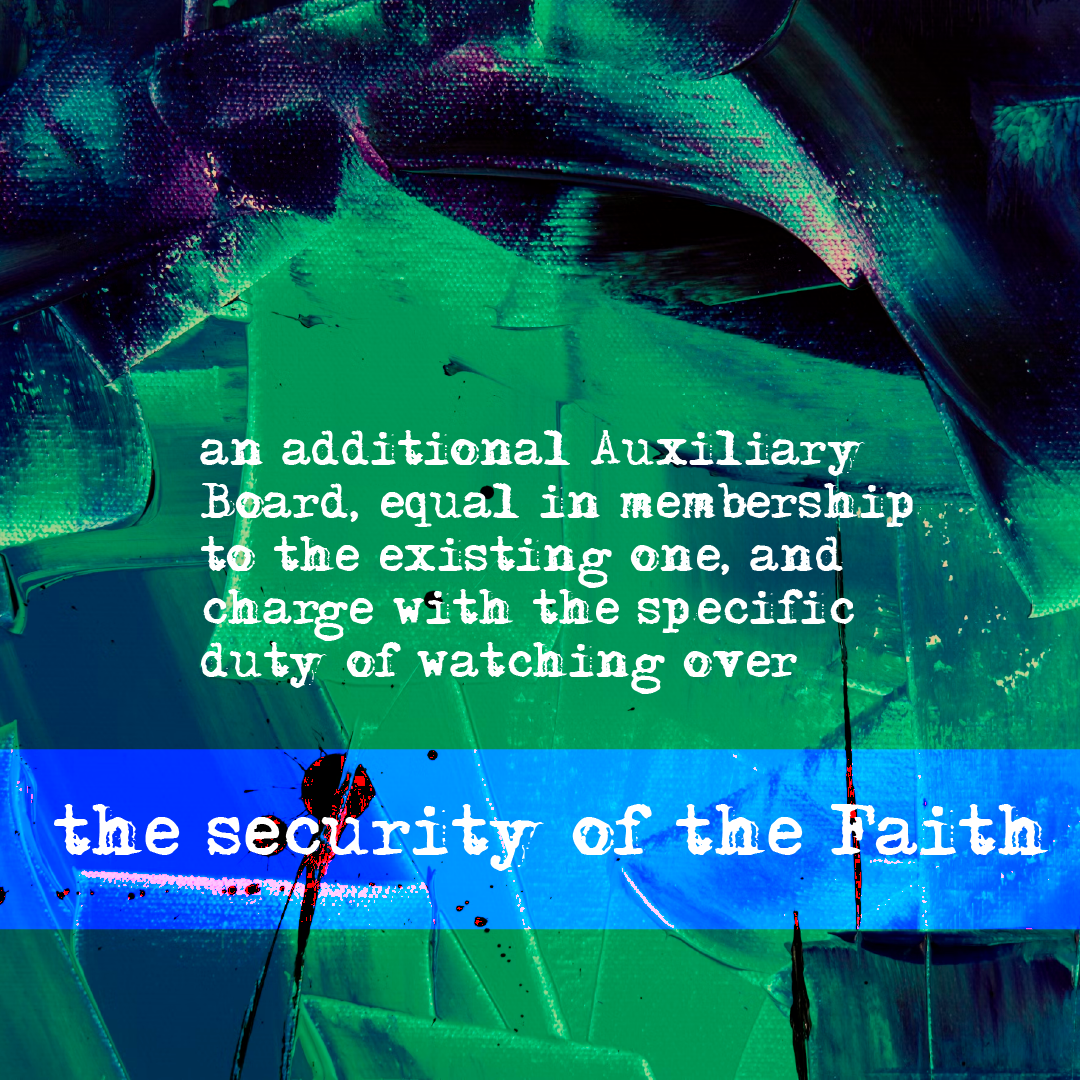
Photograph of abstract painting in the background by Steve Johnson on Unsplash.
In a deeply significant gesture—given that the Bahá'í world would need all the protection it could have just one month from then—the Guardian announced that he had inaugurated a second Auxiliary Board in each of the 5 continents.
The Auxiliary Board for Protection was born—an expansion of the institution of the Hands of the Cause and another step in the unfoldment of Bahá'u'lláh’s Administrative Order.
This latest addition to the band of the high-ranking officers of a fast evolving World Administrative Order, involving a further expansion of the august institution of the Hands of the Cause of god, calls for, in view of the recent assumption by them of their sacred responsibility as protectors of the faith, the appointment by these same Hands, in each continent separately, of an additional Auxiliary Board, equal in membership to the existing one, and charge with the specific duty of watching over the security of the Faith, thereby complementing the function of the original Board, whose duty will henceforth be exclusively concerned with assisting the prosecution of the Ten Year Plan.

One month before his passing, on 2 October 1957, the Guardian sent cables of appointments to eight new Hands of the Cause, and the appointments were shared in the last great message the Guardian ever sent the Bahá'í world in his October 1957 message, which he had composed two months before in August.
In the section of his message regarding the Hands of the Cause, the Guardian informed the Bahá'í world that he had now raised their number to three times nine, or 27 Hands of the Cause, calling them “the Chief Stewards of Bahá'u'lláh's embryonic World Commonwealth, who have been invested by the unerring Pen of the Center of His Covenant with the dual function of guarding over the security, and of insuring the propagation, of His Father's Faith.”
For his third and last contingent of Hands of the Cause, the Guardian elevated an extremely diverse group of believers to this most exalted rank:
The eight now elevated to this exalted rank are: Enoch Olinga, William Sears, and John Robarts, in West and South Africa; Hasan Balyúzí and John Ferraby in the British Isles; Collis Featherstone and Rahmatu'lláh Muhájir, in the Pacific area; and Abu'l-Qásim Faizí in the Arabian Peninsula—a group chosen from four continents of the globe, and representing the Afnán, as well as the black and white races and whose members are derived from Christian, Muslim, Jewish and Pagan backgrounds.
The Guardian left instructions for all Hands of the Cause to appoint an additional Auxiliary Board in each continent to assist them with their mission of protection and propagation of the Faith, particularly the objectives of the Ten Year Crusade, and asked for Hands of the Cause from specific continents to be present at each of the five Intercontinental Conferences to be held in 1958.

The list below, broken down first by continent, and then by Hand of the Cause follows exactly the order in which Shoghi Effendi lists the newly-appointed Hands in his message above:
WEST AFRICA
Enoch Olinga (1926–1979)
SOUTH AFRICA
William Sears (1911–1992)
John Aldham Robarts (1901–1991)
THE BRITISH ISLES
Hasan Muvaqqar Balyúzí (1908–1980)
John Graham Ferraby (1914–1973)
THE PACIFIC
Harold Collis Featherstone (1913–1990)
Raḥmatu'lláh Muhájir (1923–1979)
THE ARABIAN PENINSULA
Abu'l-Qásim Faizi (1906–1980)
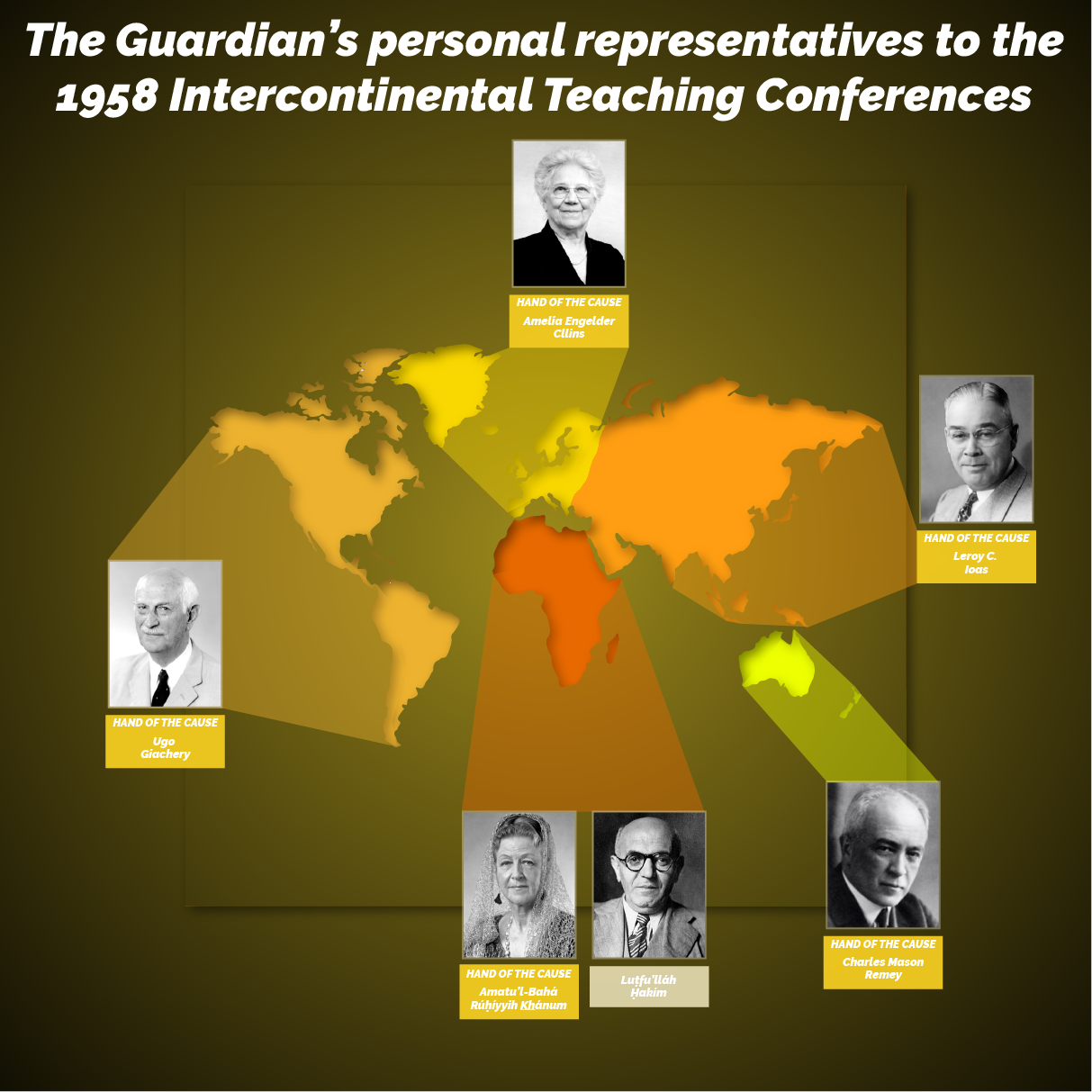
Map asset by Freepik.
In these messages shortly before his passing, the Guardian was safeguarding the Faith, by reiterating, repeating, and re-emphasizing the station of the Hands of the Cause, and continually encouraging National Spiritual Assemblies to collaborate with them.
It was the only thing that would keep the Faith safe after his passing.
As his final gesture of love showered on the worldwide Bahá'í community who had followed him so faithfully for 36 years, the Guardian had prepared special gifts for the attendees of the five Intercontinental Teaching Conferences.
He would send the six Hands of the Cause in the Holy Land as his special representatives.
Amatu'l-Bahá Rúḥíyyih Khánum and Luṭfu’lláh Ḥakím would attend the African International Teaching Conference and place a portion of earth from the inmost Shrine of Bahá'u'lláh in the foundations of the Mother Temple of Africa.
Mason Remey would attend the Australian International Teaching Conference and would bestow the same gift on behalf of the Guardian to the Mother Temple of Australia.
Amelia Collins – would attend the European International Teaching Conference and would also deliver a gift of sacred earth from the Shrine of Bahá'u'lláh to the National Spiritual Assembly of Germany and Austria until the time came when they could place it in the foundations of the Mother Temple of Europe.
Leroy Ioas would attend the Asian International Teaching Conference, and bring with him a portrait of Bahá'u'lláh for the conference attendees, then bring the portrait back for safekeeping to the Holy Land.
Ugo Giachery would attend the American International Teaching Conference and would exhibit for the conference attendees the portraits of the Báb and Bahá'u'lláh which the Guardian had previously entrusted to the National Spiritual Assembly of the United States.
This would be the Guardian’s last gift to the Bahá'ís of the world.
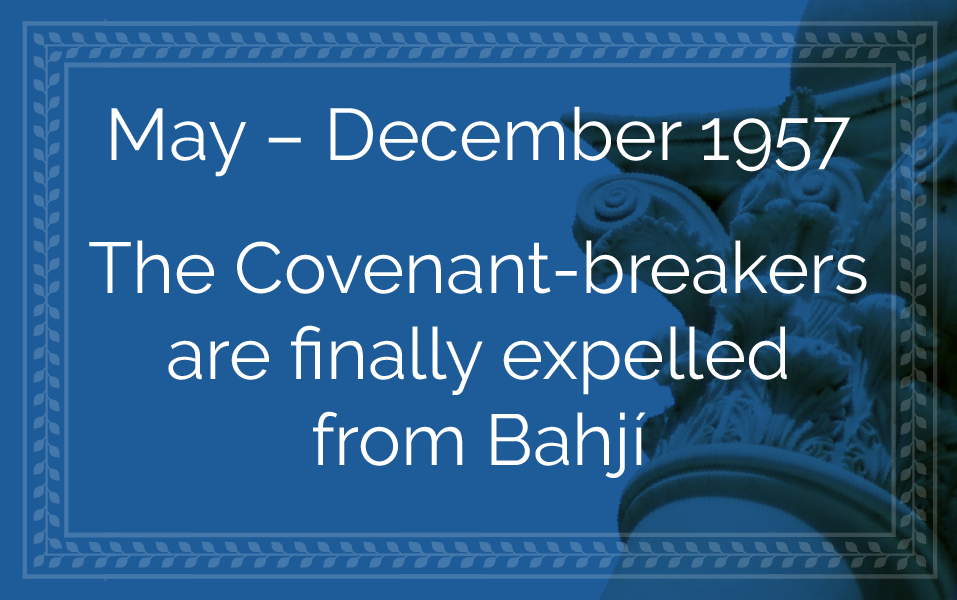

Western gallery of the Mansion of Bahjí just before the Guardian began its restoration in 1929. Source: Bahá'í Media Bank, © Bahá'í International Community 2023.
The Covenant-breakers had occupied the Mansion of Bahjí since the Ascension of Bahá'u'lláh. After 65 years of continuous occupation by the Covenant-breakers, and their attendant neglect for the Mansion of Bahjí and its surroundings, the land around Bahá'u'lláh’s majestic and last home was disastrously dilapidated. The Covenant-breakers had even had the gall, the audacity, the disrespect of allowing a blacksmith shop to operate his business near the entrance to the Shrine of Bahá'u'lláh, an abomination that broke the Guardian’s heart, and caused him not only contempt but deep sorrow, unbearable grief, and agonizing pain, which filled his heart and which he lived with for many years.
On 27 November 1929, the Mansion of Bahjí was returned into the hands of the Faith, but the Covenant-breakers still lived at Bahjí in a long row of houses that obscured the northern view of the Mansion. The Guardian had been fighting to rid Bahjí of Covenant-breakers since January 1923.
Thirty-nine years later in 1952, the Guardian had successfully obtained land around the Shrine of Bahá'u'lláh and the Mansion of Bahjí, but still, the Covenant-breakers were in the Ḥaram-i-Aqdas (The Most Holy Precincts—this is the northwestern quadrant of the gardens at Bahjí immediately around and enclosing the Shrine of Bahá'u'lláh, which the Guardian had completed by 29 May 1952.
The entire story of how Bahjí was finally cleansed of the stain of Covenant-breaking once and for all was, in the words of Hand of the Cause Leroy Ioas, “a very dramatic story."
And this is how it begins.
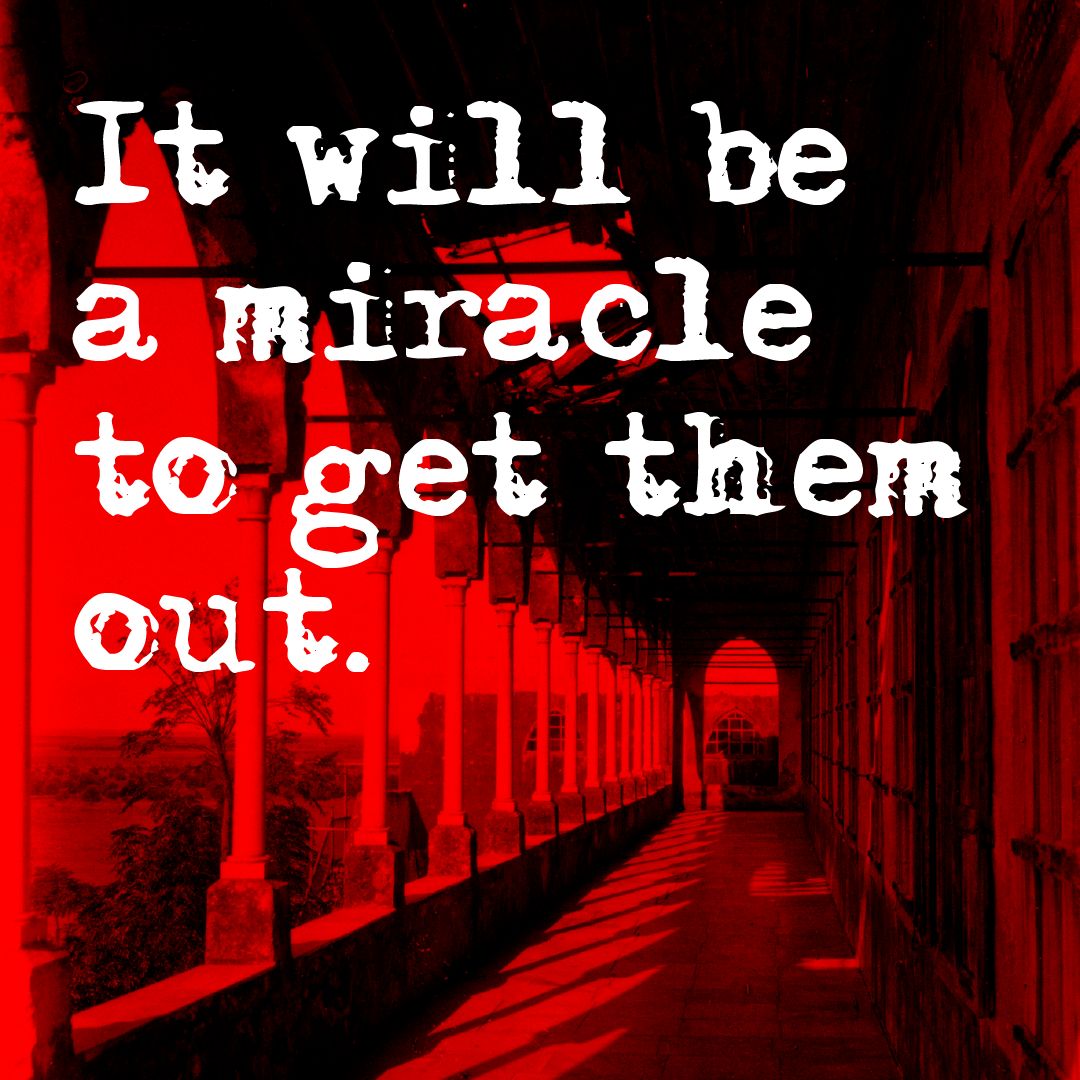
“It will be a miracle to get them out.”
When Leroy Ioas and the Guardian were beginning the process of ridding the Ḥaram-i-Aqdas of the Covenant-breakers, the Guardian turned to him and said:
Do you think it can be done?
Leroy Ioas replied:
Shoghi Effendi, if the Guardian wants it done, it can be done.
They had absolutely no idea the type of saga they were about to embark on. The Covenant-breakers were entrenched. They had been occupying, sullying, desecrating the holiest spot on earth for Bahá'ís for 65 years and Guardian said:
It will be a miracle to get them out.
When the Guardian gave Leroy Ioas the assignment, he said to him:
Everything you have done up to now, including your work on the Shrine of the Bab, is as silver, whereas removing the Covenant-breakers from Bahjí, and securing the buildings and lands for the Faith, will be as gold.
Leroy Ioas had been speaking to government officials responsible for questions of property ownership and he had learned some very interesting information.
There was a legal instrument that could be of precious use to the Guardian in this particular case. The Land Acquisition for Public Purposes Ordinance of 1943, allowed the Israeli Government to acquire land for public purposes and to subsequently transfer that land to responsible authorities.
In non-legal jargon what this meant was that the lawyers for the Bahá'í community could argue that the Ḥaram-i-Aqdas at Bahjí was of public interest, because it was a place of pilgrimage and because it would be open to the public. According to the 1943 Land Acquisition for Public Purposes Ordinance, this meant the Israeli government could simply unilaterally decide to expropriate the Covenant-breakers and give the land to the Bahá'í Faith.
On 11 May 1956, lawyers representing the International Bahá'í Council took the first step in this long protracted process by applying for expropriation of the property owned by the Covenant-breakers within the Ḥaram-i-Aqdas.
The lawyers had two main arguments:
Five years before, in 1952, the Israeli Government had already confirmed what the British Mandate had years ago: The Shrine of Bahá'u'lláh and the Mansion of Bahjí were Holy Places.
If the Israeli Government acquired the dilapidated, ruined property of the Covenant-breakers and turned it over to the Bahá'ís, they would develop, build, embellish, and maintain it.
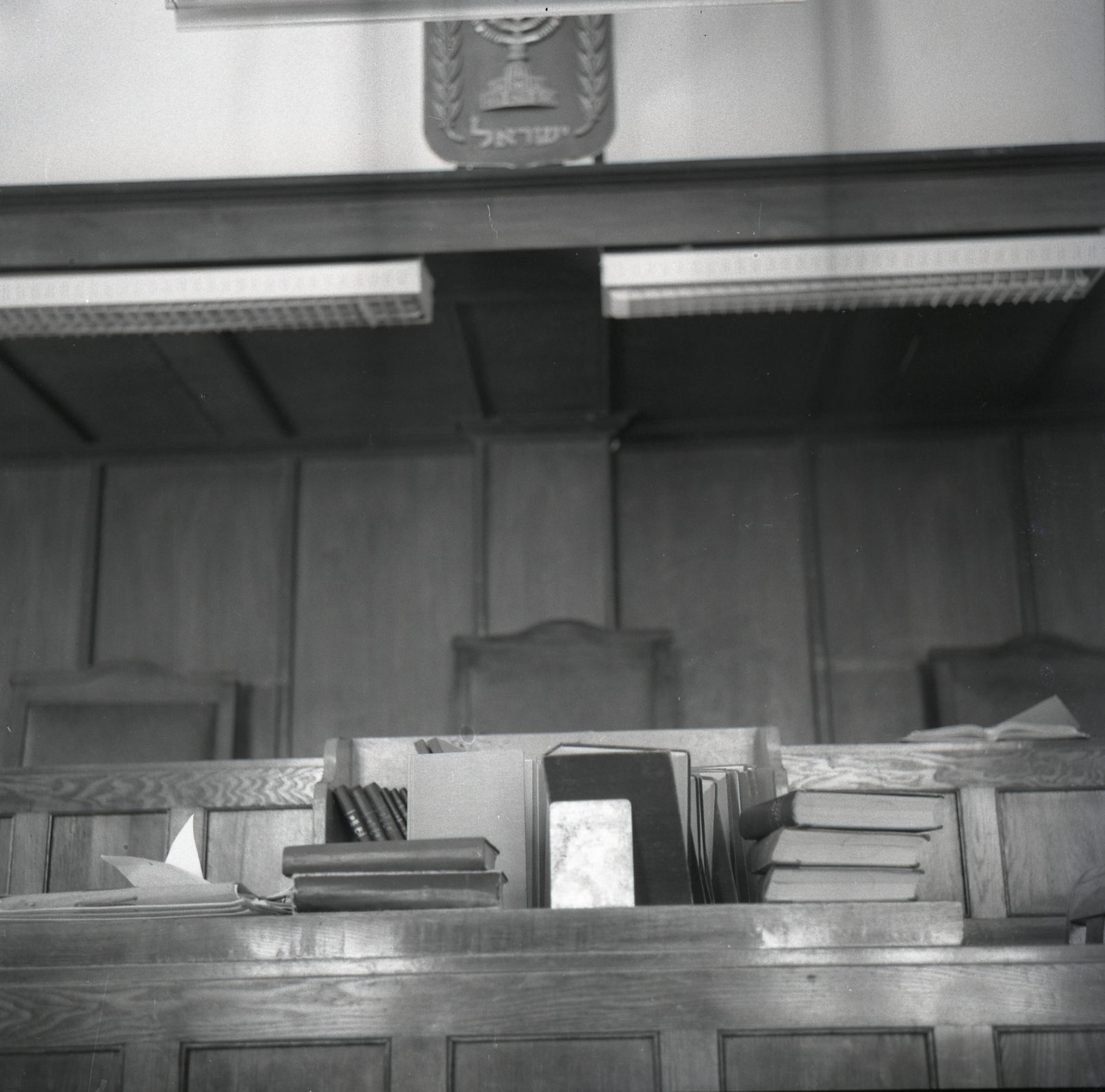
The Israeli Government issued an expropriation order which was published in Reshumot—the the gazette of record for the State of Israel—on December 20, 1956.
The expropriation order was immediately challenged by the Covenant-breakers, who took the case to the Supreme Court of Israel in April 1957.
They claimed that the expropriation of their one-sixth share of Bahjí constituted an interference in an internal dispute, an infringement of their spiritual and temporal rights, and discrimination against a minority group.
The Bahá'í community appeared before the Court to answer to their accusations.
On 3 May 1957, The Israeli Supreme Court found against the Covenant-breakers and that the Government’s purpose in acquiring the land was, indeed, a public purpose. The Court furthermore drew attention to the fact that the Covenant-breakers had not contended the public purpose of the action and that the contentions which they had brought forward had no substance.
The Supreme Court ruled that all the lands around the Shrine of Bahá’u’lláh and the Mansion were the property of the Bahá’í Faith and that the remaining Covenant-breakers had no right to live there.
Five days later, on 8 May 1957, following the judgment of the Supreme Court, Leroy Ioas returned from Jerusalem holding the papers that allowed the Guardian to remove the final three Covenant-breakers who were still living at Bahjí.
The Attorney General applied to the Haifa District Court to file an expropriation order against the Covenant-breakers. The Covenant-breakers tried, unsuccessfully to delay the court hearing and they were forced to vacate Bahjí, and relinquish their lands and leave Bahjí forever.
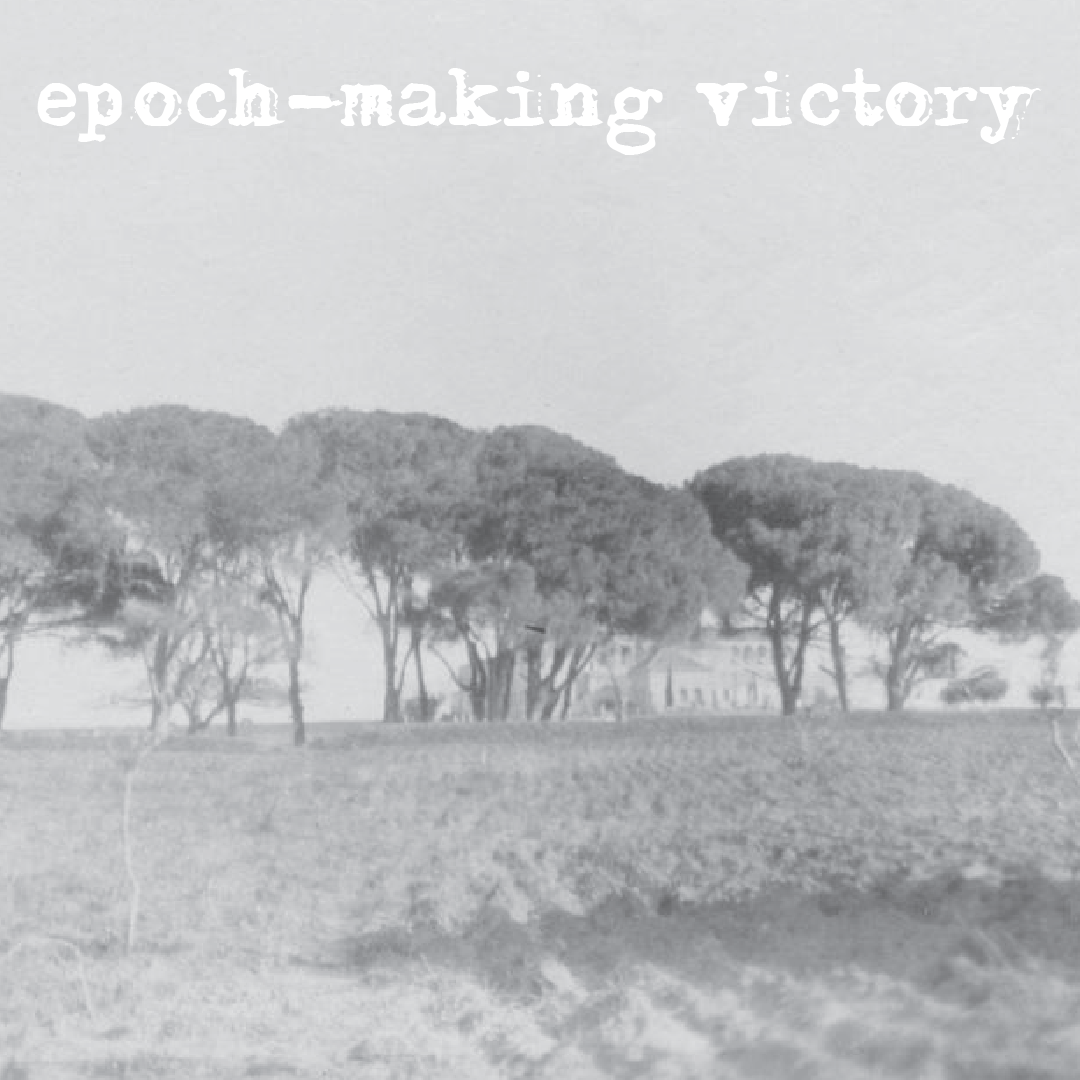
“epoch-making victory” A pristine view of Bahjí at the end of the 19th century. © United States National Bahá'í Archives, used with permission.
In a momentous cable sent on 3 June 1957, the Guardian sent a joyful and victorious message to the Bahá'í world that finally, after six and a half decades, the holiest place on earth was once and for all freed of the presence of Covenant-breakers who had occupied it since 29 May 1892:
With feelings of profound joy, exultation and thankfulness, announce on morrow of sixty-fifth Anniversary of Ascension of Bahá’u’lláh, signal, epoch-making victory won over the ignoble band of breakers of His Covenant which, in the course of over six decades, has entrenched itself in the precincts of the Most Holy Shrine of the Bahá’í world, provoking through acts of overt hostility and ingenious machinations, in alliance with external enemies under three successive regimes, the wrath of the Lord of the Covenant Himself, incurring the malediction of the Concourse on high, and filling with inexpressible anguish the heart of ‘Abdu’l-Bahá.
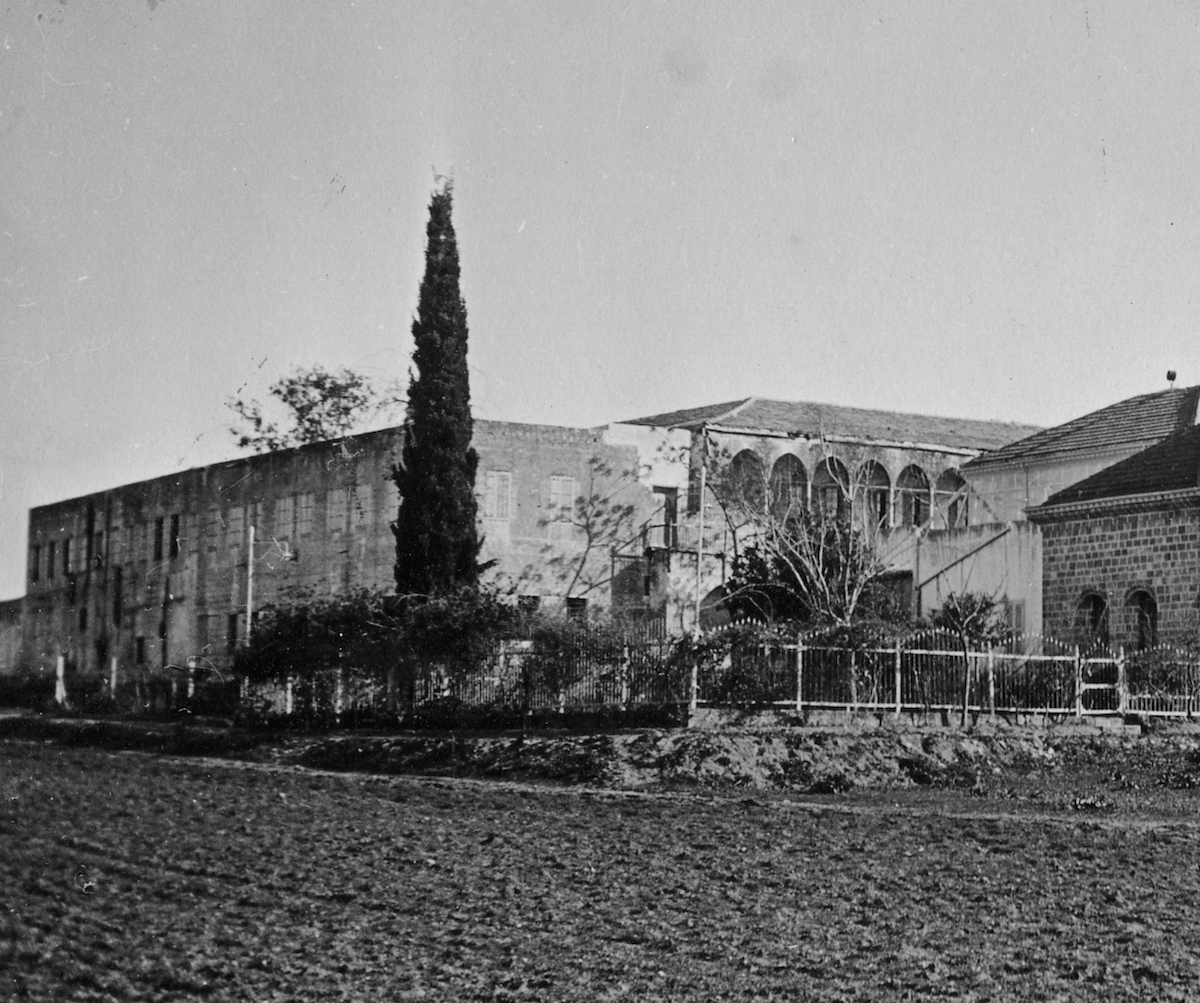
From left to right: On the extreme left edge of the photograph is the two-story Covenant-breaker building that Shoghi Effendi is planning to demolish, overseeing the work personally. Immediately next to this building is the Mansion of Bahjí, and on the right edge of the photograph is the Shrine of Bahá'u'lláh. © United States National Bahá'í Archives, used with permission.
The Guardian had won a historic victory of enemies of the Faith that had made Bahá'u'lláh, 'Abdu'l-Bahá, and himself suffer deep anguish. He had evicted the last wretched remnants of once-formidable enemies of the Faith that had tried and failed to disrupt the foundations of the Faith, he had cleansed and purified the Shrine of Bahá'u'lláh of the stench and stain of Covenant-breaking, and called this victory a “final, shattering and most humiliating blow.”
Within three months, the Covenant-breakers were gone and the Ḥaram-i-Aqdas had been cleansed. The six decades of suffering inflicted on first 'Abdu'l-Bahá then the Guardian had come to an end. Before leaving Haifa in the summer of 1957—his last summer—the Guardian had told Leroy Ioas:
Just as soon as we acquire this house of the Covenant-breakers we will tear it down.
In late August 1957, the Covenant-breakers left Bahjí and Leroy Ioas cabled the Guardian asking if he should commence destroying their house, but the Guardian replied:
Postpone demolition until my return.
The Guardian wanted to be there in person to watch the stain on the Ḥaram-i-Aqdas be obliterated from the earth.

Aerial view of the Shrine of Bahá’u’lláh, Mansion of Bahjí and surrounding gardens. Source: Bahá'í Media Bank, © Bahá'í International Community 2023.
Two months before his passing, on 6 September 1957, the Guardian again cabled the Bahá'í world, speaking about the “purification” of the Ḥaram-i-Aqdas:
Announce to Hands and all National Assemblies that following the loss of the appeal to the Supreme Court, the Government expropriation order has been implemented, resulting in the complete evacuation of the remnant of Covenant-breakers and the transfer of all their belongings from the precincts of the Most Holy Shrine, and the purification, after six long decades, of the Harám-i-Aqdas from every trace of their contamination. Measures under way to effect transfer of title deeds of the evacuated property to the triumphant Bahá'í community.
There were two last steps to legally complete the transfer of the deed for the Covenant-breakers’ one-sixth of Bahjí.
First, in October 1957 Leroy Ioas was able to cable the Guardian that the Bahá'ís had purchased the properties, saying:
They are ours.


Public Health officials of the State of Illinois, early in November 1972, visited and examined The Bahá’í Home in Wilmette, the first dependency of the House of Worship, for a period of five hours. They found the home beautifully kept, with superior nursing care and superior food served to guests. Source: Bahaimedia.
In God Passes By, Shoghi Effendi quoted the words of 'Abdu'l-Bahá regarding the House of Worship in North America, and its spiritual and regenerative power:
When the foundation of the Mashriqu’l-Adhkár [Dawning-place of the mention of God] is laid in America and that Divine Edifice is completed, a most wonderful and thrilling motion will appear in the world of existence…From that point of light the spirit of teaching, spreading the Cause of God and promoting the teachings of God, will permeate to all parts of the world. Out of this Mashriqu’l-Adhkár, without doubt, thousands of Mashriqu’l-Adhkárs will be born. This organization of the Mashriqu’l-Adhkár will be a model for the coming centuries, and will hold the station of the mother.
The original Arabic word revealed by Bahá'u'lláh for House of Worship is Mashriqu’l-Adhkár. This word literally means “Dawning Place of the Praise of God,” and Bahá'u'lláh’s vision of a House of Worship was a Temple surrounded by Dependencies, humanitarian and social service agencies, channels for the spiritual energies of worship in the Mashriqu’l-Adhkár to be turned into pure deeds that had the power to regenerate humanity and society.
A Mashriqu’l-Adhkár, in Bahá'u'lláh’s vision, is not just a Temple, it is a force for good in the world, real, tangible, visible good, through its Dependencies. Shoghi Effendi clarified the matter further in a letter dated 25 October 1929:
But however inspiring the conception of Bahá’í worship, as witnessed in the central Edifice of this exalted Temple, it cannot be regarded as the sole, nor even the essential, factor in the part which the Mashriqu’l-Adhkár, as designed by Bahá’u’lláh, is destined to play in the organic life of the Bahá’í community.
Divorced from the social, humanitarian, educational and scientific pursuits centering around the Dependencies of the Mashriqu’l-Adhkár, Bahá’í worship, however exalted in its conception, however passionate in fervor, can never hope to achieve beyond the meagre and often transitory results produced by the contemplations of the ascetic or the communion of the passive worshiper.
…Nothing short of direct and constant interaction between the spiritual forces emanating from this House of Worship centering in the heart of the Mashriqu’l-Adhkár, and the energies consciously displayed by those who administer its affairs in their service to humanity can possibly provide the necessary agency capable of removing the ills that have so long and so grievously afflicted humanity.
Immediately after the dedication of the Bahá’í House of Worship in Wilmette, the Guardian called for inauguration of the Temple’s first Dependency as the eleventh goal of the American community in a letter he wrote to the forty-fifth National Convention on 29 April 1953.
During the second phase of the Ten Year Crusade, the National Spiritual Assembly purchased land for its first Dependency, and they planned to build a library.
The Guardian advised the National Spiritual Assembly that he did not consider a library to be a proper demonstration of the purpose and significance of the institution of the Mashriqu’l-Adhkár and its spiritual power in society.
Following this, the National Spiritual Assembly of the United States decided to build a retirement home, a symbol of the Bahá'í Faith’s commitment to serve humanity. This was where things stood when the beloved Guardian passed away.
 1956: The Guardian’s unflinching standards of beauty and dignity for the Mother Temples of the world
1956: The Guardian’s unflinching standards of beauty and dignity for the Mother Temples of the world

The unflinching standards of beauty of the Guardian for Houses of Worship are visible down to the smallest details, such as the beauty of the interiors of their domes. Top, left to right: View of the interior dome of the Continental Bahá’í House of Worship of Central Asia (Ashkhabad, Turkmenistan), early 1900s. Source: Bahá'í Media Bank, © Bahá'í International Community 2023. View of the inside of the dome of the Continental Bahá’í House of Worship of Europe (Hofheim-Langenhain, Germany). Source: Bahá'í Media Bank, © Bahá'í International Community 2023. Bottom, left to right: View of the inside of the dome of the Continental Bahá’í House of Worship of South America (Santiago, Chile). Source: Bahá'í Media Bank, © Bahá'í International Community 2023. View of the inside of the dome of the Local Bahá'í House of Worship in Battambang, Cambodia. Source: Bahá'í Media Bank, © Bahá'í International Community 2023.
The Guardian kept a very close watch on the designs for the Houses of Worship that were being prepared. Only he had the ability to decide the suitability of designs, and he corresponded about the indisputable necessary elements that should be present in any design for a Bahá'í House of Worship, educating communities, and training architects to align to his vision.
It was the Guardian’s divinely-appointed task to safeguard the Faith and maintain a standard of dignity and beauty that would protect its Holy Name, the sacred nature of its institutions, its international character, its newness and promise, from the fleeting whims of modern designs that might, in a few generations, age out and look dated.
Here are three stories of Shoghi Effendi’s unerring hand in selecting designs for the new Mother Temples of the Bahá'í world:
Shoghi Effendi received several designs for the House of Worship in Kampala, but one design profoundly shocked the Guardian’s impeccable taste for beauty and design, and Rúḥíyyih Khánum wrote down his stupefied reaction:
Poor Africans! They became Bahá'ís to gather under such monstrosities?
Shoghi Effendi came to the rescue of all Bahá'ís in Africa by selecting for them a design for their Mother temple that had not only been created at the Bahá'í World Centre, but which he liked and approved.
In a letter written on behalf of the Guardian dated 21 June 1956 to the National Spiritual Assembly of Germany and Austria, Shoghi Effendi expressed his views about the deep importance of the architectural style of a House of Worship:
He feels that, as this is the Mother Temple...it has a very great importance; and must under all circumstances be dignified, and not represent an extremist point of view in architecture. No one knows how the styles of the present day may be judged two or three generations from now; but the Bahá'ís cannot afford to build a second Temple if the one they build at the present time should seem too extreme and unsuitable at a future date.
In a letter dated 11 July 1956, written on behalf of the Guardian to the National Spiritual Assembly of the British Isles, Shoghi Effendi explains the importance of a dignified and graceful architectural style befitting a House of Worship, qualities diametrically opposed to extreme modernist designs, addressing the disappointment of an architect whose design was not retained:
He was sorry to have to disappoint Mr. …who was so enthusiastic about his own design for the Temple. However, there was no possible question of accepting something as extreme as this. The Guardian feels very strongly that, regardless of what the opinion of the latest school of architecture may be on the subject, the styles represented at present all over the world in architecture are not only very ugly, but completely lack the dignity and grace which must be at least partially present in a Bahá’í House of Worship. One must always bear in mind that the vast majority of human beings are neither very modern nor very extreme in their tastes, and that what the advanced school may think is marvellous is often very distasteful indeed to just plain, simple people.
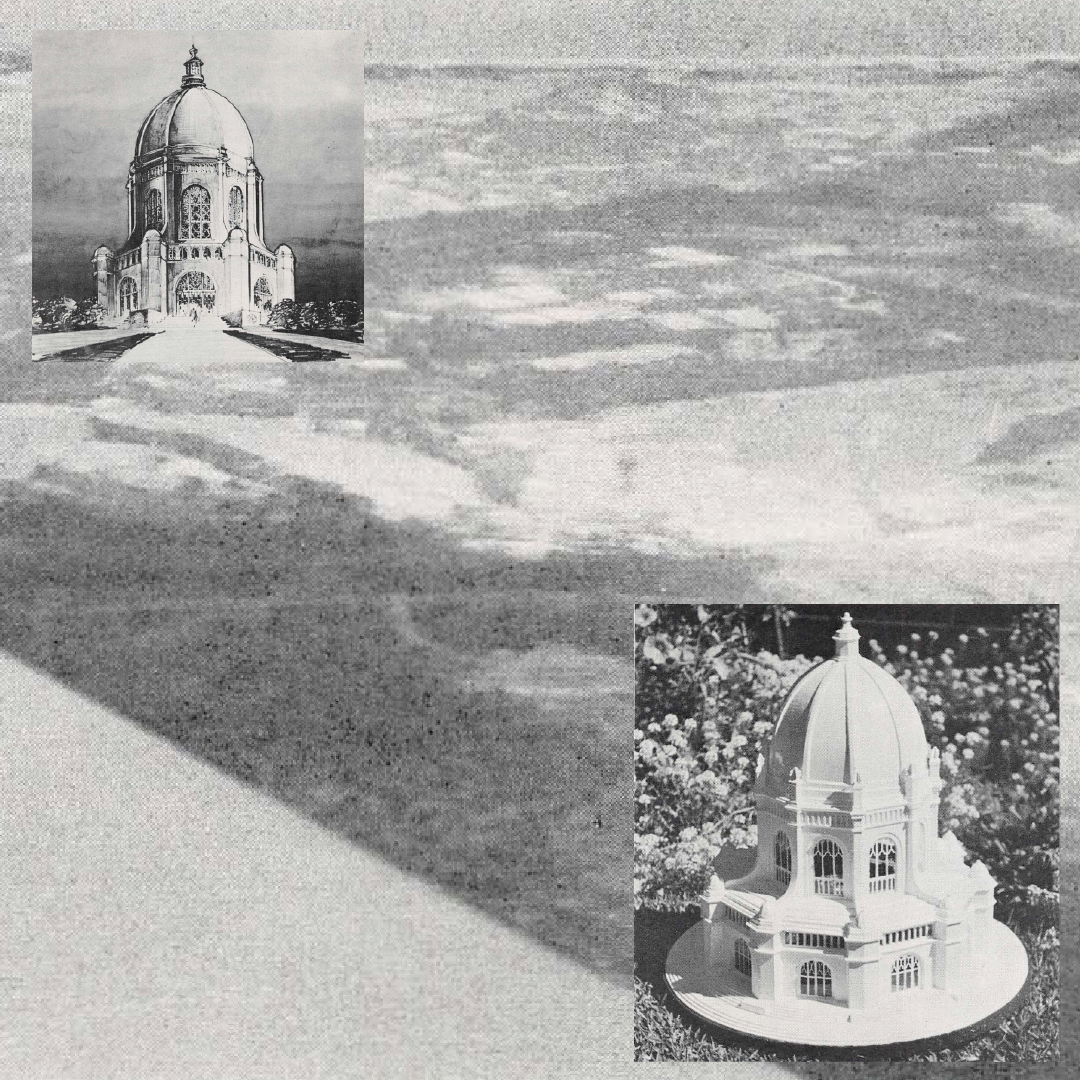
Top image: Design for the Mother Temple of the Pacific. Source: Bahaimedia. Bottom image: Model for the House of Worship in Sydney. Source: Bahaimedia. Background: Aerial view of the Temple Land in Sydney. Source: Bahaimedia.
The Australian community was surprised and exhilarated when they learned from that one of their tasks during the Ten Year Crusade was to erect the Mother Temple of the Pacific in Sydney. The Guardian conveyed the historic news in a cable dated 30 April 1953 to their National Convention in seven words:
…purchase land Sydney anticipation first Mashriqu’l-Adhkár Australasia…
Immediately after their Convention in April 1953, the Sydney Bahá’í community began searching for the perfect location. A Temple Site Committee was formed on 1 October 1953, and their search was long and arduous.
In early 1954, the Guardian advised the National Spiritual Assembly that he wished the Temple land, 2 to 3 acres in size, to be purchased by Naw-Rúz 1954.
A first site was purchased by 21 March 1954, but the Education Department and the town council required its use, so it was sold and the Committee resumed its search.
In November 1955, a property of 7 acres in Ingleside was purchased. The property was vast, 7 acres, elevated, at over 200 meters, and it overlooked the Pacific Ocean. It was five kilometers from the shore and 30 kilometers from Sydney. It was perfect.
Once they had purchased the Temple Land, the Australian Bahá'ís doubled down on their teaching plans, but the Guardian was several steps ahead of them and had already privately instructed the National Spiritual Assembly to submit a design for the House of Worship.
In order to avoid the publicity of an architectural competition, the National Spiritual Assembly hired a reliable Sydney architect, J. Brogan to submit designs. Although Shoghi Effendi had initially wanted the Temple to have a brick structure, the National Spiritual Assembly asked for permission to build out of concrete, something that not only could be done locally, but did not require skilled tradesmen to fabricate the bricks of the original design. The Guardian granted their request, and the Bahá'ís began clearing the area.
In April 1957, the National Spiritual Assembly appointed a Temple Construction Committee. When the Bahá'ís gathered for their National Convention at Riḍván 1957, they were overjoyed to hear that construction on their Mashriqu’l-Adhkár was about to begin and they were amazed to discover the design.
By October 1957, the building contract was approved. The Guardian passed away a few weeks later, but he had left behind a priceless gift. The rest of the story of this Temple takes places during the Ministry of the Custodians.

Temple site for the Mother Temple of Europe near Frankfurt, Germany. Source: Bahaimedia.
No one but the Guardian of the Bahá'í Faith would ever have thought of building the House of Worship for the European Continent, the Mother Temple of Europe, in Germany, the originating point of the two World Wars of the twentieth century.
No one would have believed it would be possible to pull of such a project, initiated only 8 years after the end of the devastation of World War II.
But Shoghi Effendi was profoundly unafraid, utterly confident, and possessed the capacity to see beyond normal human limitations, into the future of civilization, unhampered by anything but his dedication to the Cause of Bahá'u'lláh.
Shoghi Effendi had, in fact, chosen a design for the Mother Temple of Europe and sent it to the National Spiritual Assembly of Germany and Austria, but they informed him that based on the anti-church feeling, his classic design would not be a complication in obtaining building permits.
The design had to be modern, and Shoghi Effendi allowed the believers in Germany and Austria to hold a competition.
Ever mindful of 'Abdu'l-Bahá's visit to that country and the love He had for that community, Shoghi Effendi had fostered its unfoldment from the very first years of his own ministry; it was one of the communities he included in the first, heart-broken, hesitant letters he sent out to the miniature Bahá'í world of those days in 1922.
Shoghi Effendi was keenly aware that 'Abdu'l-Bahá had loved Germany deeply. He had thoroughly loved his time in Germany, with the families and children, driving through the most beautiful springtime hills he had ever seen since leaving Persia, and his last ever Tablet had been written to the Bahá'ís of Germany.
On 19 April 1953, the German Bahá'ís learnt that one of their tasks in the Ten Year Crusade was to build a House of Worship near Frankfurt.
There were enormous obstacles for the Germans to overcome from the very beginning. In October 1953, they could not apply for a city-owned piece of land because the Bahá'í community was too small.
They bought three properties in July 1954, but because of protests against a Bahá'í place of worship, the authorities canceled the sale.
On 22 July 1955, the National Spiritual Assembly of Germany and Austrian chose their favorite among the 19 designs submitted by 16 architects in the competition, a design by Teuto Rocholl of Frankfurt. The design they chose also happened to be the Guardian’s favorite.
In the spring of 1957, the National Spiritual Assembly tried purchasing land again, and the bill of sale was not approved by the district, again.
On 29 October 1957, the National Spiritual Assembly purchased land in the village of Langenhain, near Frankfurt.
The Guardian passed away six days later.
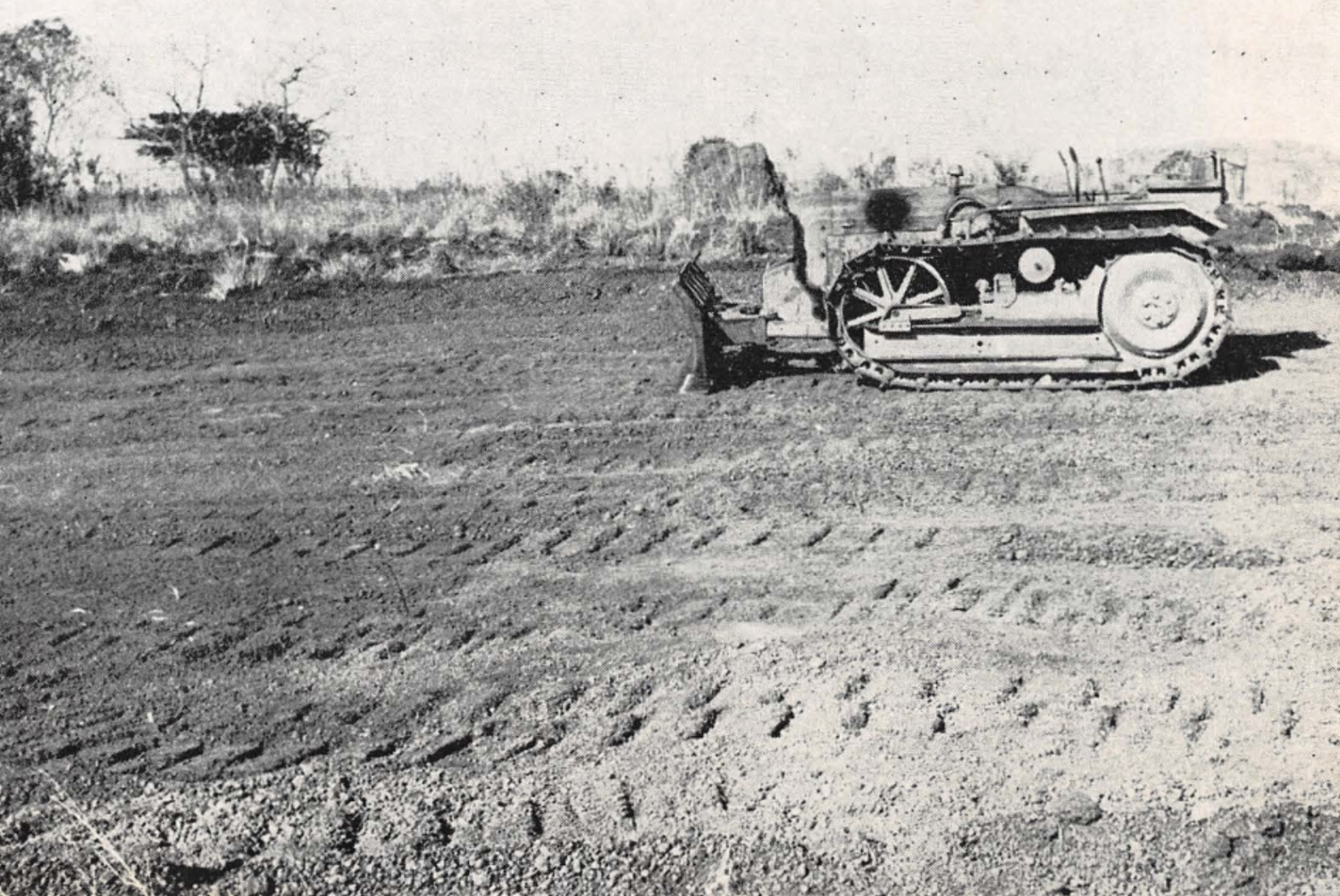
The ground being leveled at the construction site for the Mother Temple of Africa in Kampala, one of the last pieces of good news from the project that the Guardian received before his untimely passing. Source: Bahaimedia.
On 9 February 1953, probably more than a few Bahá'ís were shocked to read in the Guardian’s message to the African Intercontinental Teaching Conference that he designated a House of Worship would be built in the heart of Africa, in a city called Kampala.
The Guardian already knew the power and the huge, untapped potential of the African continent, and heh would later characterize this House of Worship as "the stupendous, the momentous and unique project of the construction of Africa's Mother Temple."
Once the Guardian had set his sights on Kampala, he proceeded as he always did: with extreme speed and unwavering confidence. In December 1953, the Guardian urged for a special fund for the purchase of the Temple Land in Kampala, and five months later, at Riḍván 1954, the fund was inaugurated, and the Bahá'ís of the world were contributing to it.
The Guardian always wanted things done as fast as possible, and on 20 April 1954, a first, 6-acre property on Kibuliriza Hill, 4 kilometers south of Kampala was purchased, but this would not be the final Temple Land. A few months later, once the Ugandan authorities raised no objection to a “building of worship” being erected on the land, the Guardian threw himself into realizing the project.
After examining several options with architectural firms in the United Kingdom and East Africa, Shoghi Effendi decided to hire the services of Hand of the Cause and architect, Mason Remey on 18 November 1955. Nine months later, in August 1856, with Mason Remey sketching and the Guardian correcting, advising, suggesting, and basically directing the entire design, the architectural plan for the Mother Temple of Africa was finished.
As endowment land was a goal of the Ten Year Crusade to be reached by Riḍván 1956, the Central and East Africa Regional Assembly purchased 13 acres of gorgeous land on Kikaya Hill, 5 kilometers north of Kampala.
When it came time to start building the House of Worship, the Bahá'ís in Kampala encountered several serious problems with the initial Temple land, which they battled for 9 months from July 1955 to Riḍván 1956. The land was too low on the hill and the House of Worship wouldn’t be visible from the city, an important requirement for any Temple. There was no access road, not enough water for the needs of the construction, too many tenants on the land, and a new housing development which would eventually encircle the House of Worship.
In August 1956, the Central and East Africa Regional Assembly decided to build the House of Worship on Kikaya Hill, north of Kampala. They had turned the endowment land into the Temple land. The original Temple land on Kibuliriza Hill was exchanged for 5 extra acres on the new Temple land.
From August 1956 until the passing of the beloved Guardian in early November 1957, he was involved in countless preparations for the construction of the temple.
In February 1957, the Guardian cabled:
Ensure no delay commencement excavations.
In August 1957, the Guardian instructed the Bahá'ís to expedite the work. By September 1957, the top of Kikaya Hill had been cleared and levelled, and the position of the Temple decided upon. On 22 October 1957, work had begun on the foundations of the Mother Temple of Africa.
The last message the Central and East Africa Regional Assembly ever sent their beloved Guardian on 31 October 1957, four days before his tragic passing was a bearing of glad tidings:
Joyful greetings birthday Bab. Temple site levelled. Building contractor chosen commencing within week. Contract water borehole signed.
The very last words their beloved Guardian sent to the Bahá'ís of Central and East Africa was a joyful and loving one, on the very same day they had sent theirs:
Delighted contract Temple. Loving appreciation. Shoghi.
Four days later he passed to the Abhá Kingdom.
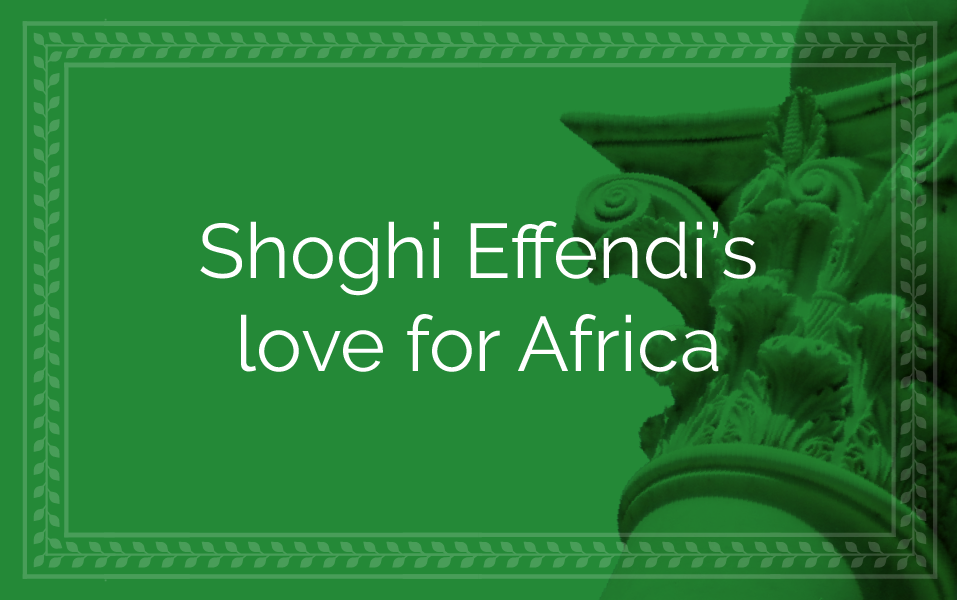
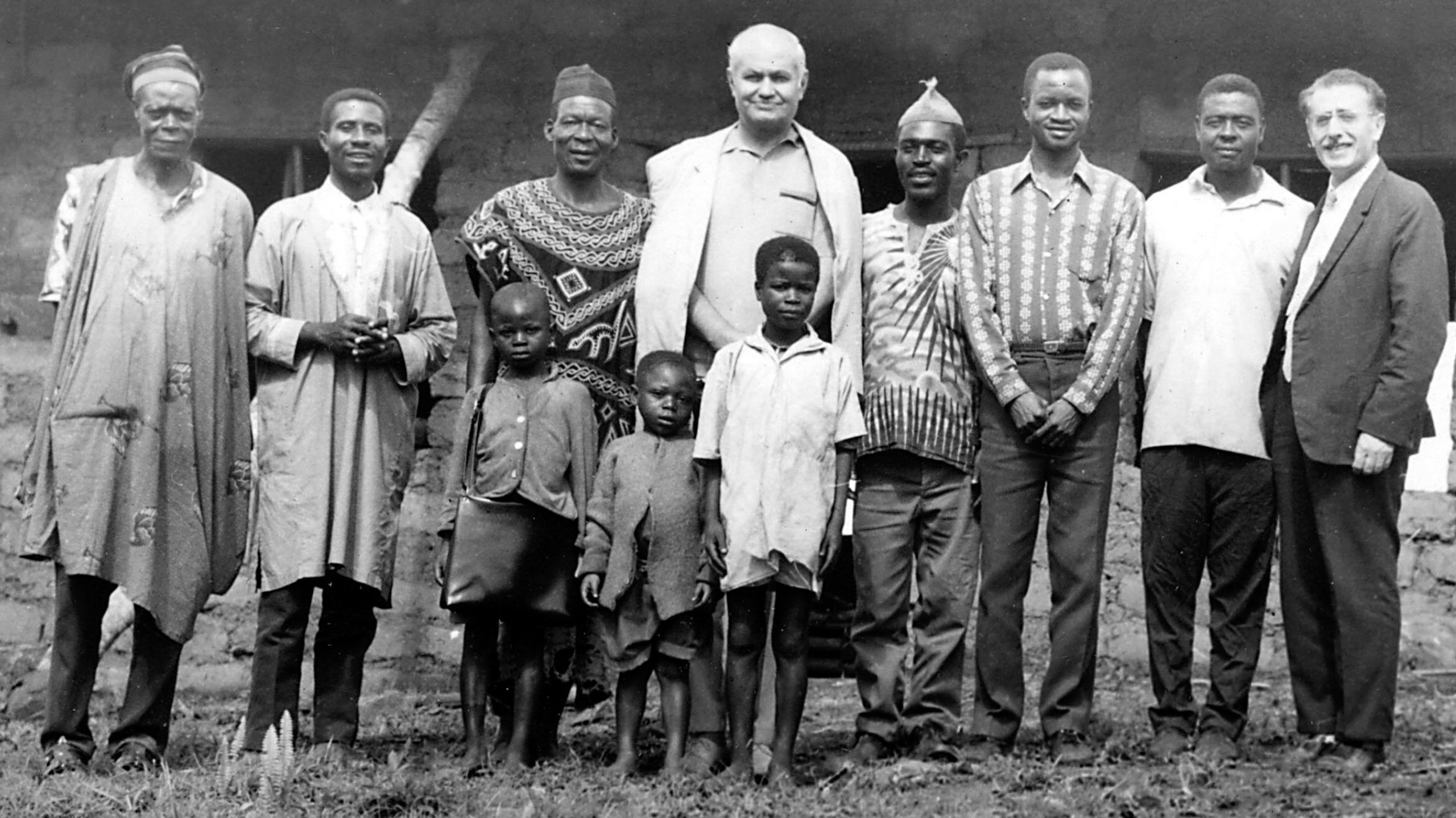
Hand of the Cause `Alí-Muhammad Varqá (center) and Mihdi Samandari (far right) with Bahá’ís of Nkwen, Cameroon in 1972. Source: Bahá'í Media Bank, © Bahá'í International Community 2023.
Before we enter the last section of the life of the Guardian prior to his passing, it is fitting to pay tribute to Shoghi Effendi’s lifelong love for Africa, the continent that brought him so much joy in the last years of his life. This short section is a retrospective of Shoghi Effendi’s love for the African continent from the beginning to the end of his ministry.
Twice, in 1929 and 1940, Shoghi Effendi had crossed Africa from south to north, crossing through what are now Zimbabwe, Zambia, the Democratic Republic of Congo, Sudan, and Egypt.
The eagle above the Guardian’s resting place is not poised mid-flight on Africa, the continent squarely facing forward, by coincidence. While western continents remained dormant during most of Shoghi Effendi’s ministry, Africa soared, and offered our precious Guardian his first glimpses of entry by troops.
In 1952, Shoghi Effendi proudly named 12 African tribes whose members had enrolled under the banner of the Faith, and he diligently kept track and announced the increases in this statistic so dear to his heart. In 1955, the number grew to 90, in 1956 to 140, and the year he passed away, in 1957 197 African tribes had a member who was a Bahá'í. In five years, between 1952 and 1957, the number of tribes increased by 185.
In 1954, Shoghi Effendi informed the Bahá'í world there were over 500 African believers in Uganda alone, and by 1957, the number had increased sixfold to over 3,000 Bahá'ís.
In 1953, during the Holy Year, the very first of the four Intercontinental Teaching Conferences organized by the Guardian took place in Kampala, Uganda. Representatives of over 30 tribes attended, including 100 newly-declared African Bahá'ís, personal guests of the Guardian himself.
After his passing in 1957, it was on the continent of Africa that Amatu’l-Bahá Ruḥíyyíh Khánum chose to place the eagle, on the monument marking the Guardian’s resting place, sealing his love to that continent forever.

Participants of the first National Convention of Central Africa with Hand of the Cause Abu’l-Qásim Faizi, April 1970. Source: Bahá'í Media Bank, © Bahá'í International Community 2023.
Shoghi Effendi did not just praise Africans, he praised the African Continent, a continent that had "remained uncontaminated by the evils of a gross, a rampant and cancerous materialism undermining the fabric of human society alike in the East and the West, eating into the vitals of the conflicting peoples and races inhabiting the American, the European, and the Asiatic continents, and, alas, threatening to engulf in one common catastrophic convulsion the generality of mankind."
In November 1955, the Guardian arrived at the historic decision to raise the Mother Temple of Africa in Kampala, Uganda, and later, he personally approved the design for the House of Worship.
In the last contingent of Hands of the Cause the Guardian appointed on 2 October 1957, just three months before his passing, was the first indigenous African: Enoch Olinga, from Uganda. Below are four letters filled with the Guardian’s praise for the Bahá'í activities in Africa, and the heroic efforts of the African believers:
The Guardian is very happy over the activities of the friends throughout Africa. That great continent is now becoming alive, and will certainly take its place in the forefront of Baha'i communities . (From letter of 15 May 1953 on behalf of the Guardian an individual believer) The Guardian has been most happy with the teaching efforts of the dear friends in Africa. They have won new goals for the Faith, and shown new depths of devotion in their sacrificial service. God has richly blessed them, and their efforts; and through them has given new life to the people of Africa.
From letter of 25 May 1953 on behalf of the Guardian
to the Baha'is of Dar es Salaam.
The news from everywhere in Africa, where there are believers, has been most heartening, and shows that the hour for Africa has indeed struck, spiritually. (From letter of 31 May 1953 on behalf of the Guardian to an individual believer) He was immensely pleased over the example shown by . ., in withdrawing from political affiliation, and feels that some of the African friends are showing a most exemplary spirit of devotion and loyalty. He feels that a great potential strength lies in these new African believers.
From Letter of 4 June 1953 on behalf of the Guardian
to the British Africa Committee published in Unfolding Destiny, page 301.
The continent of Africa is pre-eminent in its record of achievement. The spread of the Faith has been miraculous there ... . Uganda is the area producing the most remarkable results ... . Completely dedicated to their sacred mission, consecrated to the great service they had undertaken, their lives and conduct in accordance with the teachings of Bahá'u'lláh, the original pioneers to Uganda arose with prayerful zeal to carry the Glad Tidings of the Kingdom to the native inhabitants. They demonstrated that the Baha'i has no prejudice of any type. Through their loving association on the basis of equality, they soon won the hearts and souls of the people . So effective has been their teaching, that the new African Baha'is have arisen in numbers to carry the Message throughout the land, not only Uganda, but other consolidation territories, and more important , in virgin areas of the Crusade. Over six of the virgin areas of the Crusade have been filled by the new African Baha'is.
From a letter of 14 April 1954 on behalf of the Guardian
to the National Spiritual Assembly of the United States of America.
A great victory has been won for the Faith through the sacrifice and devotion of the African Baha'is in arising to fill the s areas designated by the Guardian. First, of course, is the devotion and sacrifice of Enoch Olinga, and the example he has set for the African believers; and then the zeal and ardor of the new Baha'is. The Guardian is well pleased with these friends , who have set such a remarkable example, and have woven such a beautiful star in the banner of Africa.
From letter of 24 April 1954 on behalf of the Guardian to an individual believer.
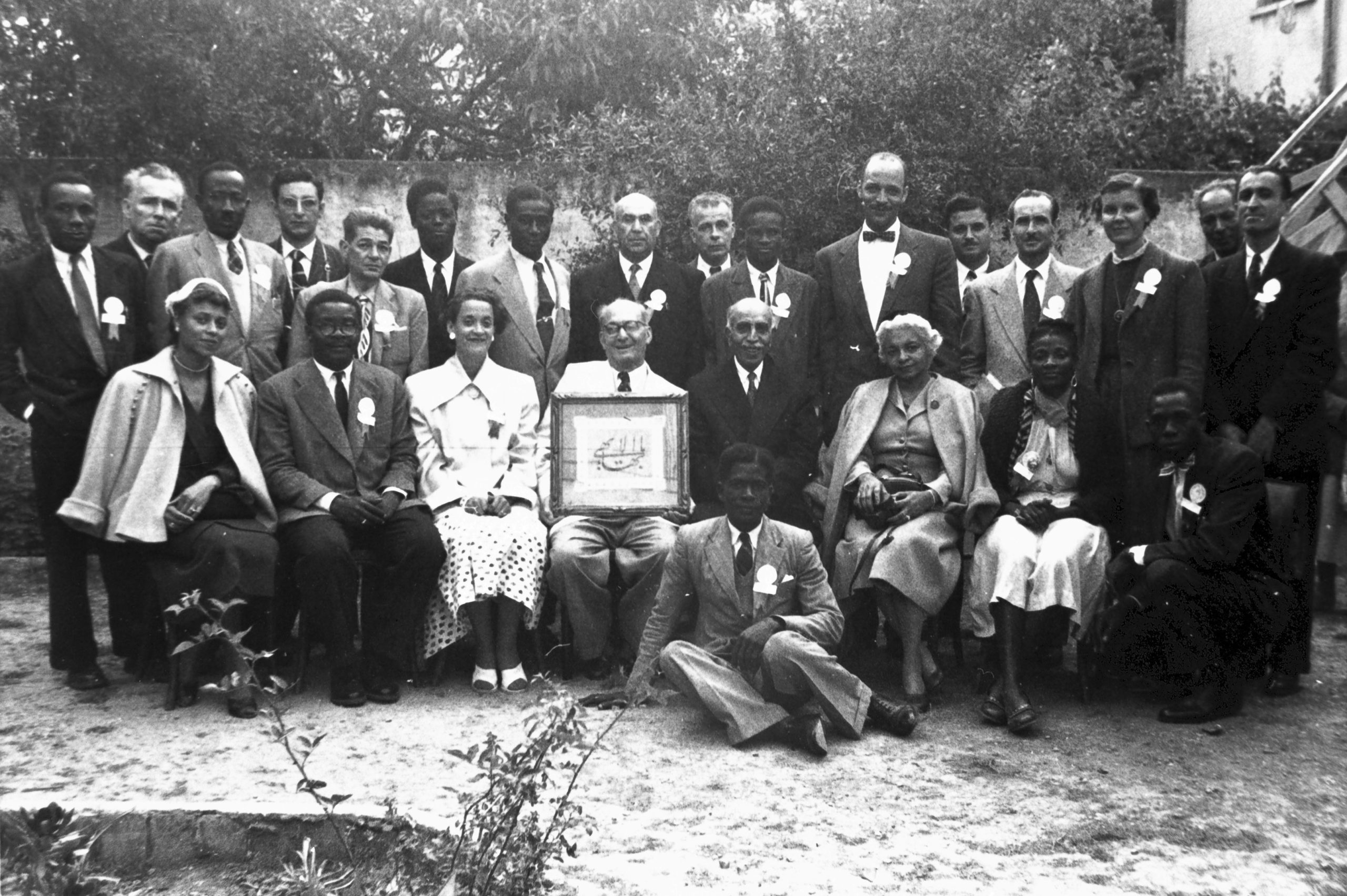
Participants of the first National Convention of North West Africa, with Hands of the Cause Músá Banání and Enoch Olinga, April 1956. Source: Bahá'í Media Bank, © Bahá'í International Community 2023.
In 1998, The National Spiritual Assembly of the Bahá'ís of South Africa, Johannesburg published a compilation titled The Promising Continent: Selections from the Writings of 'Abdu'l-Bahá, the Writings and Letters of Shoghi Effendi, and the Letters Written on His Behalf to Africa. In this compilation are dozens of letters and cables, written by Shoghi Effendi or on his behalf by his secretary about Africa. What follows is a pen-portrait compilation of the feelings of the Guardian for the continent of Africa and its people, using the exact words from the correspondence of Shoghi Effendi.
The Cause in Africa, and particularly in Uganda, is going forward in a truly remarkable manner; and we have every reason to thank Bahá'u'lláh from all our hearts for His infinite mercies poured out upon this continent. According to the degree of the devotion of the believers, their sacrifice, their tact and their perseverance, will we witness the results obtained in the immediate future.
The remarkable progress the Faith is making throughout the African continent greatly rejoices his heart. He often looks at the map and points out to the friends these treasured Spiritual Assemblies now girdling that vast continent.
Africa is truly awakening and finding herself, and she undoubtedly has a great message to give, and a great contribution to make to the advancement of world civilization.
…the work in Africa, and more particularly in Uganda, is very dear to his heart. The progress made there during the last year has borne him up and encouraged him greatly when he was often weighed down with work. He feels that this country and its peoples, in the very heart of Africa, are a most precious trust. Their receptivity to the Teachings, their great desire to serve their new Faith, the number of them who have arisen to go out as pioneers, mark them as a people apart in the Baha'i world, at least for the time being.
The Guardian becomes very happy when he contemplates the fact that so many of the new African Baha'is have arisen to pioneer for the Faith. He feels those of you who are doing this are laying the foundation for great spiritual service in the Cause of God, that you are rendering historic service, and that you are becoming the honour and glory of the African people.
The country of Africa is surging with new life; and the friends should go there to assist in the awakening of that great continent.
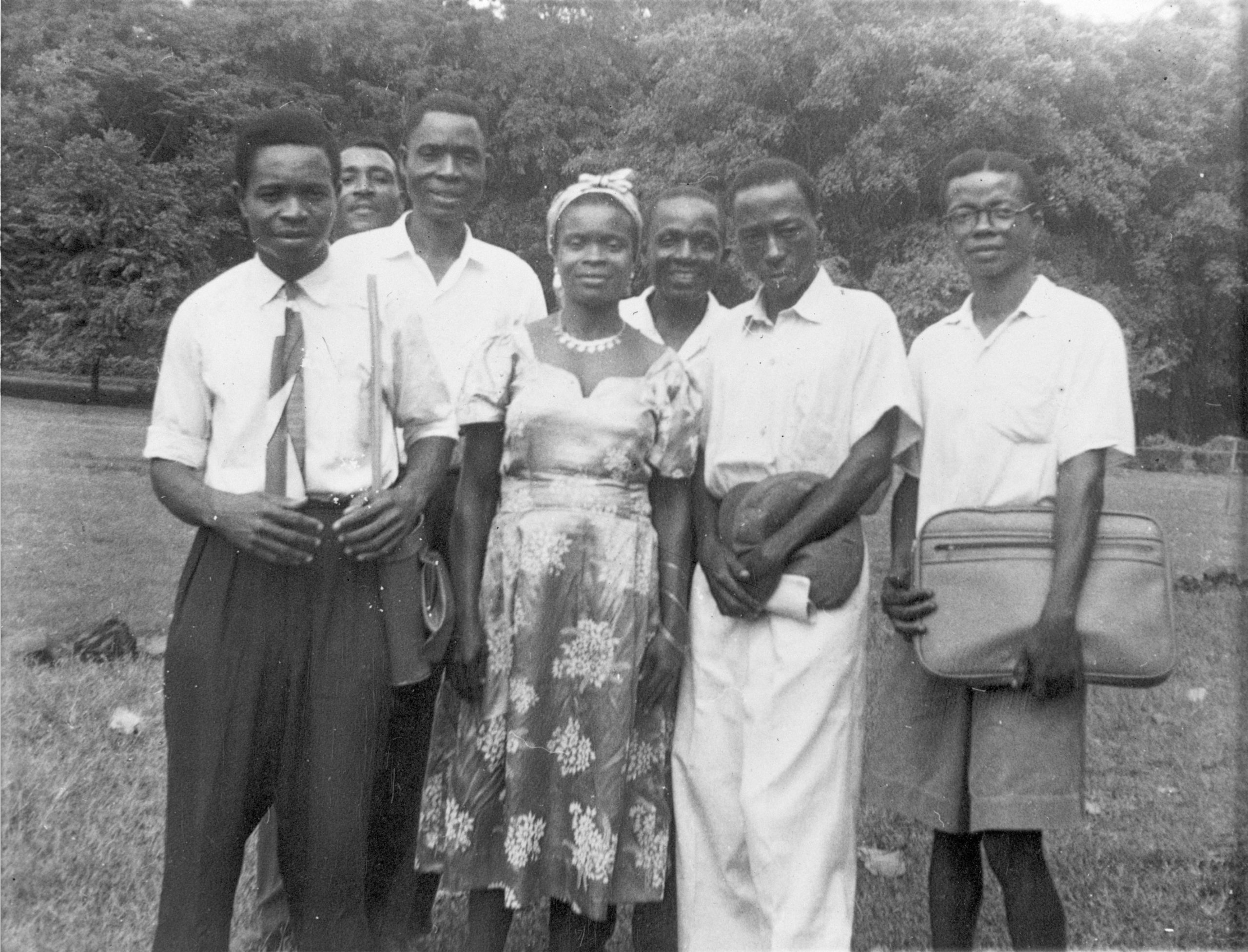
A group of participants of the National Convention of North West Africa, 1960. Source: Bahá'í Media Bank, © Bahá'í International Community 2023.
Shoghi Effendi’s joy always came from the growth and development of the Faith and its Administrative Order, the heart of his ministry as Guardian.
A piece of good news that would send the Guardian’s heart soaring would be a goal just recently won, a new language in which Bahá'í literature had just been translated, the election of the first Local Spiritual Assembly of Wisconsin, the election of the first National Spiritual Assembly of India, the mass conversions in Uganda.
Such glad tidings would send Shoghi Effendi to his desk to compose a thrilling message and fold into his own joy the entire worldwide community of Bahá'ís, elevated by his happiness, exhilarated by the news, excited to run into the field of service in Bahá'u'lláh’s name.
When ‘Alí Nakhjávání inaugurated mass conversions in Teso, Uganda, about 320 kilometers north of Kampala, the Guardian’s joy was contagious on a planetary scale. He would update the messages if new numbers came in, sending a first message stating 200 people had declared, then shortly after, 500, then a third message when the number grew to 800, and before the Guardian passed away, there were 2,000 Bahá'ís in Teso. Very shortly before he passed away, Shoghi Effendi experienced one last throb of joy when Bolivia shared that mass conversions among the Indigenous population were forthcoming.
Whenever he was elated over a tremendous victory of the Faith, whenever he was truly Happy, Shoghi Effendi would turn to Rúḥíyyih Khánum and break her heart, saying:
If I were happy you would see what I would do for this Cause. Let them make me happy.
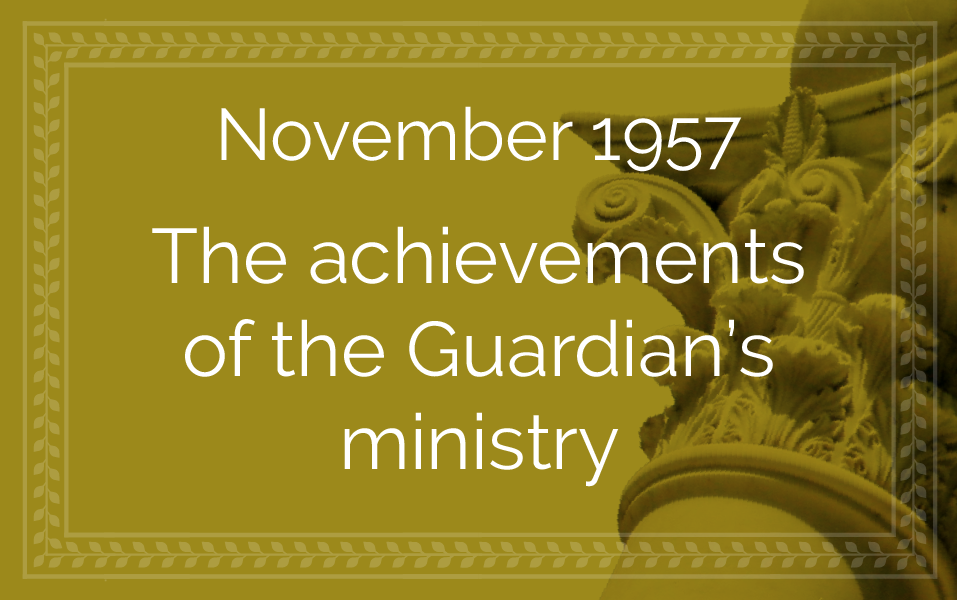
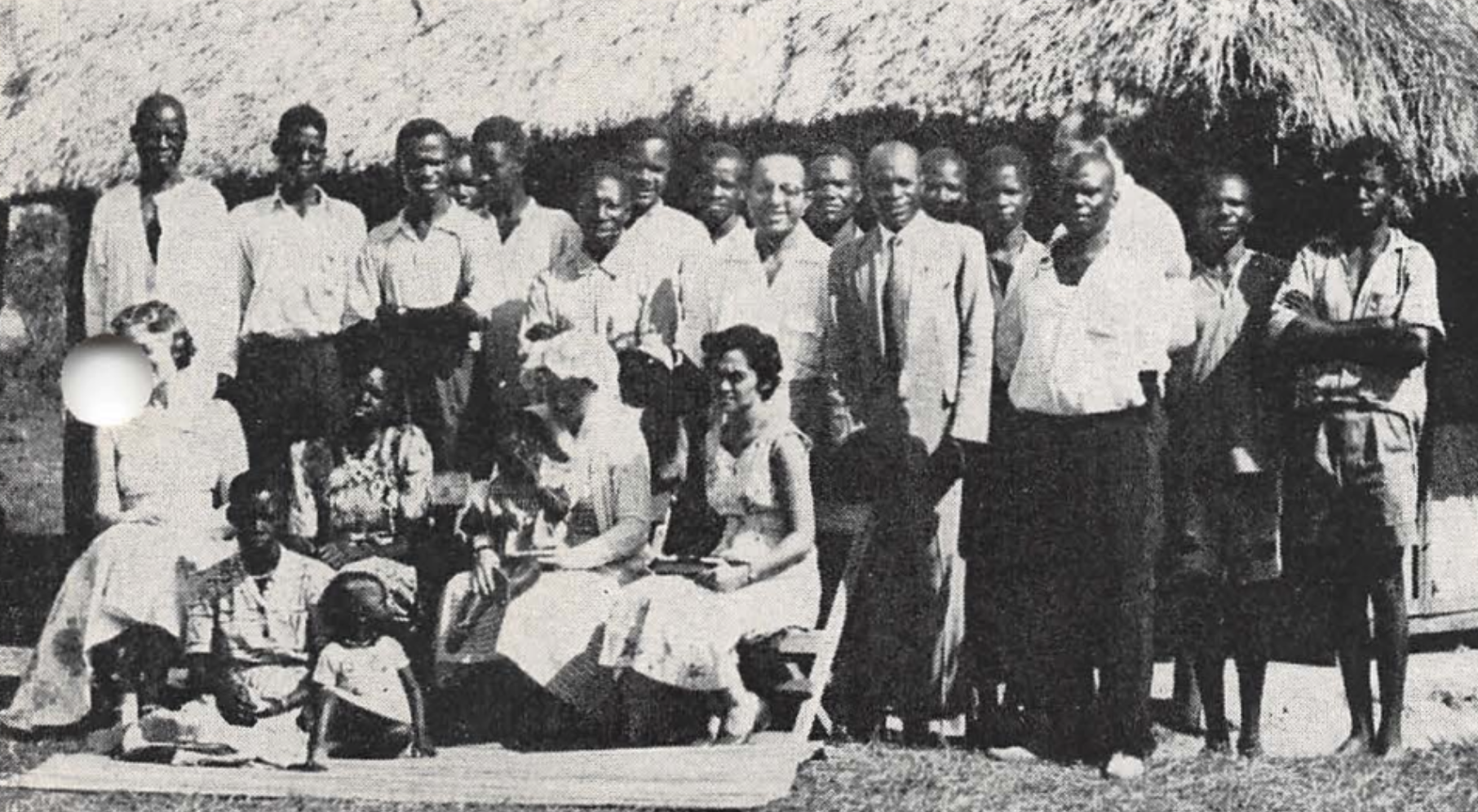
Rúḥíyyih Khánum visiting the Bahá'ís in Teso, Uganda in 1958, the area where mass conversions took place the year the Guardian passed away. Source: Bahaimedia.
By Riḍván 1957, the Guardian had overseen, guided, and encouraged the expansion of the Faith from 1,034 localities in 1935 at the start of the Ten Year Crusade to 4,200 localities in 1953—an increase of 306%—and with his passion for encouraging teaching, the number of Bahá'ís worldwide grew from 100,000 to 400,000—a 400% increase.
The literature and Holy Writings of the Bahá'í Faith were translated in 71 languages in 1953, and by Riḍván 1957, in the last year of the Guardian’s life, they were available in 230 languages, a 273% increase—and 40 of those had been added just since 1956.
In 4 years, the number of territories in which the Faith was present had almost doubled to 251 in 1957, which included as many as 74 islands in all the oceans and seas of the world.
There were 12 National Spiritual Assemblies in 1953, and by the end of 1957, the number had more than doubled to 28, with over 1,000 Local Spiritual Assemblies worldwide, with 10% of that number, 100 Local Spiritual Assemblies formed in a single year between 1956 and 1957.
117 of the 131 goals of the Ten Year Crusade—89% of the goals—had been achieved by the end of 1957. And every single territory 'Abdu'l-Bahá had mentioned in His Tablets of the Divine Plan was now opened to the Faith, before the Crusade’s halfway mark.
These numbers—in just 4 years—would have been impossible in any other context but the Faith of Bahá'u'lláh, and would have been unattainable for anyone other than the Guardian of the Cause.
The Guardian had faced every trial with immovable strength, and he had devised the pattern, laid the foundation, erected the machinery, and set into operation the Administrative Order of the Faith of Bahá'u'lláh. The Guardian had effectively spread the Bahá'í Faith to every corner of the earth in his implementation of 'Abdu'l-Bahá’s’ Tablets of the Divine Plan.
The Guardian had—through his rare spirit of audacity and clear-headedness—guided the Faith of Bahá'u'lláh to heights the Bahá'ís themselves could never have dreamed of. He had accomplished all the tasks entrusted to him by his Beloved Grandfather, 'Abdu'l-Bahá, in His Will and Testament. For all this, the Guardian had weathered scars from the countless personal attacks he had endured during his ministry, and had passed away, utterly spent. Here are Rúḥíyyih Khánum’s last words in her adoring biography of Shoghi Effendi, The Priceless Pearl:
The man had been “called by sorrow and a strange desolation of hopes into quietness”. The Guardian, he who was named in the Master's Will the “primal branch of the Divine and Sacred Lote-Tree,” and who, through the provisions of that Will, had been so firmly planted in the soil of the believers' hearts after 'Abdu'l-Bahá's passing, remained forever, and well indeed will it be with “him that seeketh the shelter of his shade that shadoweth all mankind.”

Six unique concepts
‘Alí Nakhjávání, after a lifetime of carefully and meticulously studying the writings of Shoghi Effendi isolated six unique concepts in the Guardian’s letters and books.
According to ‘Alí Nakhjávání, although these six concepts cannot be found in that form in any of the Writings of the Báb, Bahá'u'lláh, or 'Abdu'l-Bahá, their spiritual roots, their genesis can be directly traced to the Utterances of Bahá'u'lláh and 'Abdu'l-Bahá.
Here, then are the six startling subjects uncovered by ‘Alí Nakhjávání and disclosed by the pen of the Guardian:
ONE: Seven Stages:
These are the seven stages that national communities experience as the Faith moves from obscurity to formal recognition and their establishment and supremacy in their country and they are:
- OBSCURITY: In 1953, a good example would be most of Europe. The Faith was completely unknown.
- PERSECUTION: The perfect example of this is, of course, Iran.
- EMANCIPATION: This is the stage Egypt reached with the verdict annulling the marriages and therefore proclaiming publicly that the Bahá'í Faith was an independent religion.
- RECOGNITION: This stage, in 1953, was only attained by the United States and Israel.
- ESTABLISHMENT: This stage is the establishment of the Bahá'í Faith as the state religion.
- THE BAHÁ’Í STATE: This stage is characterized by a Bahá'í state, where all political matters will be referred to the Universal House of Justice.
- THE BAHÁ’Í CIVILIZATION: This stage will be attained when a number of governments will join together and form a universal Bahá'í Government—a Bahá'í World Commonwealth. At this stage, National Spiritual Assemblies will become National Federal Governments.
TWO: Cycles, Dispensations, Ages, Epochs, and Phases:
It was Shoghi Effendi who divided Bahá'í time into Cycles, Dispensations, Ages, Epochs, and Phases.
THREE: Teaching and Consolidation:
The Guardian inaugurated the twin processes of teaching and consolidation, or expansion and consolidation, and trained Bahá'ís to adopt national goals or Plans inspired by the international Teaching Plans formulated by the Head of the Faith.
FOUR: Nine Concentric Circles:
The concept of the nine concentric circles—which we looked at after the completion of the superstructure of the Shrine of the Báb—is a novel concept ushered in by Shoghi Effendi. It is the idea that the remains of the Báb are at the center of nine concentric circles, which include various parts of the Shrine, Mount Carmel, and finally the entire planet. The 18 terraces, 9 above and 9 below the Shrine are meant to represent these circles.
FIVE: The Station of the Báb:
Despite the exalted station of the Shrine of the Báb, it is still under the shadow of the Shrine of Bahá’u’lláh, the Most Holy Shrine.
SIX: The Báb as the Fruit of the Adamic Cycle:
The Guardian characterized the Báb as the fruit of the Adamic Cycle—a fruit which yielded its oil, and was subsequently ignited by Bahá’u’lláh in the lamp of His Revelation. Shoghi Effendi interpreted that light as being diffused first to the major countries and islands of the world, then gradually to every spot on earth, enabling the warmth of Bahá’u’lláh’s teachings to penetrate, through the establishment of the administrative machinery of the Faith, into every land, and finally to suffuse the hearts of the population throughout the entire planet.
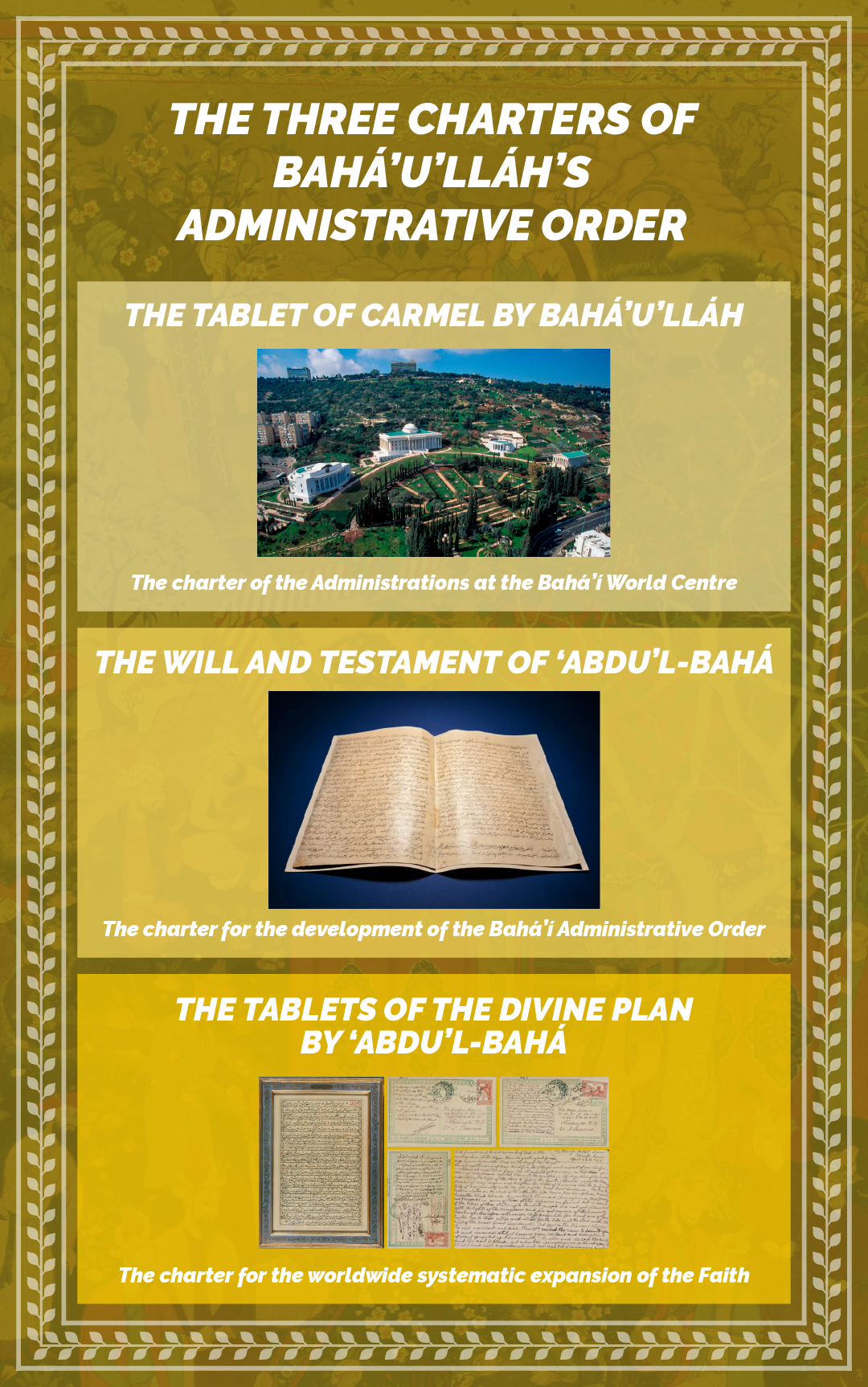
The three charters of the Bahá'í Administrative Order: Top photograph: The administrative buildings on the Arc and the Monument Gardens, as set forth by Him in the Table of Carmel, revealed on the very same holy mountain in 1891, and considered by Shoghi Effendi to be the charter of the Bahá'í World Centre in the Holy Land. Source: Bahá'í Media Bank, © Bahá'í International Community 2023. Middle photograph: The opening pages of ‘Abdu’l-Bahá’s Will and Testament, the charter for the evolution of the Bahá'í Administrative Order. Source: Bahá'í World News Service, 24 December 2021. Bottom photograph: .Images of the original Tablets of the Divine Plan revealed by 'Abdu'l-Bahá in the springs of 1916 and 1917, the charter for the worldwide expansion of the Faith in every corner of the planet, and the basis of all future Teaching Plans in the Formative Age of the Faith. Source: Tablets of the Divine Plan blog by Brent Poirier.
With the passing of ‘Abdu’l-Bahá, the Bahá’í Faith entered a new stage in its growth. The ministry of 'Abdu'l-Bahá ended the Heroic Age of the Faith, the Age of the Three Central Figures of the Faith, comprising the ministry of the Báb from 1844 to 1853, the ministry of Bahá'u'lláh, from 1853 to 1892, and the ministry of 'Abdu'l-Bahá, from 1892 to 1921.
When Shoghi Effendi became the Guardian, the Faith entered the Formative Age, a radically different stage in the evolution of the Faith of Bahá'u'lláh. Shoghi Effendi’s style of leadership would be very different from that of 'Abdu'l-Bahá.
For 36 years—from 1921 until his passing in 1957—Shoghi Effendi immersed himself completely in his work guiding and directing the growth of the Bahá’í community throughout the world at a very critical stage in its development.
From the moment Shoghi Effendi took on the mantle of the Guardianship, he vigorously set out to execute what he saw as the “three charters” of the Bahá'í Faith:
- Bahá’u’lláh’s Tablet of Carmel, establishing the mandate for the development of the Bahá’í World Centre in the Holy Land;
- The Will and Testament of ‘Abdu’l-Bahá, outlining the framework for the evolution of the Bahá’í administration;
- and ‘Abdu’l-Bahá’s Tablets of the Divine Plan—the very first systematic Teaching Plan in Bahá'í History—providing the guidelines for the global expansion of the Bahá’í community.
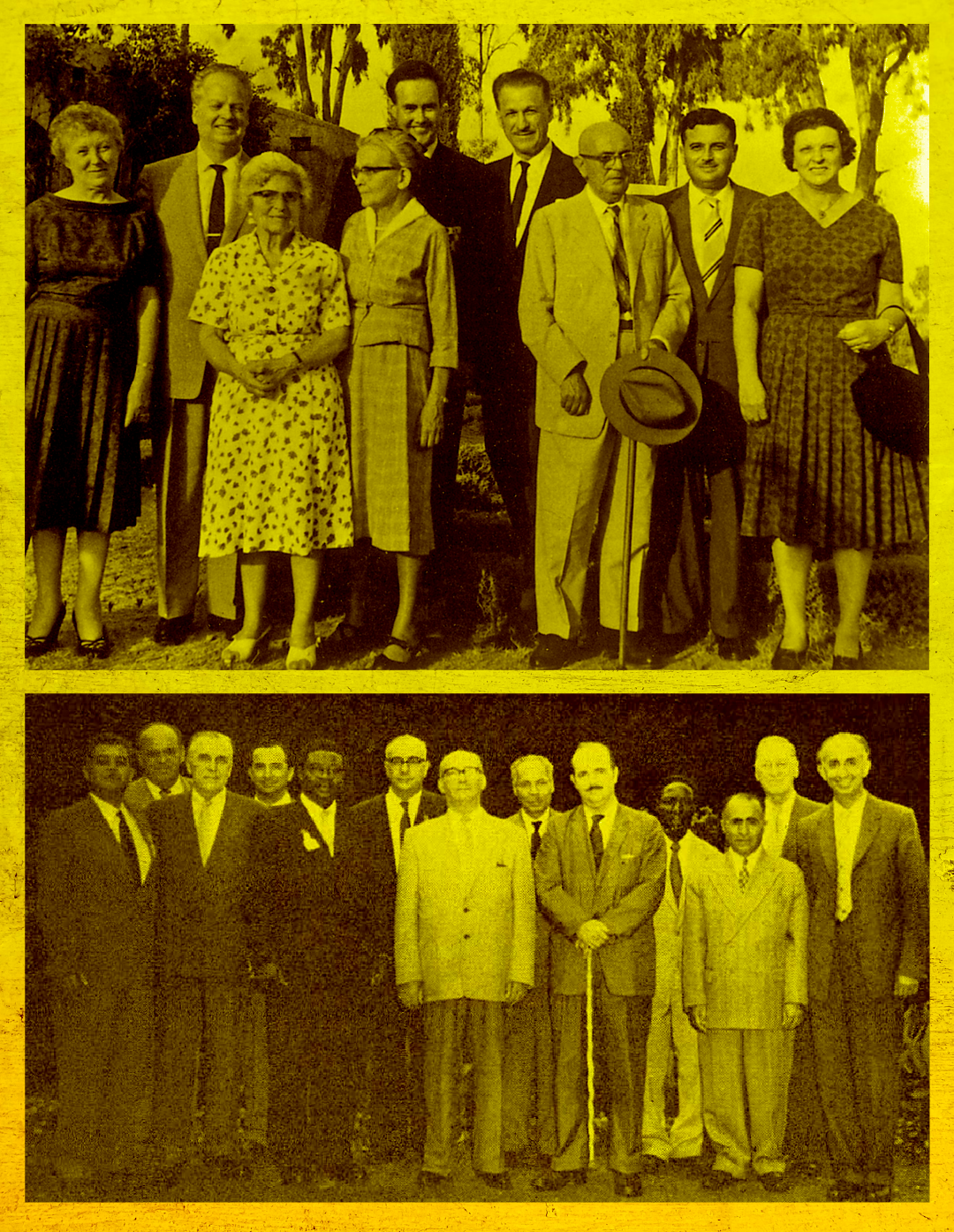
Three of the institutions inaugurated by the Guardian during his ministry: Top photograph: The International Bahá'í Council at Bahjí in 1961. Source: Bahaimedia. Top photograph: Hands of the Cause with Auxiliary Board Members at the Kampala Conference, 1958. Some of those present were: Jalál Nakhjávání, John Allen, John Robarts, Sue Beanatar, Enoch Olinga, Músá Banání, William Sears, Max Kenyerezi, Harlan Ober, Aziz Yazdi. Source: Bahaimedia. Background photograph: Abstract painting photo by bharath g s on Unsplash.
One of Shoghi Effendi’s priorities was the development of the Administrative Order of Bahá’u’lláh, and he patiently, lovingly, but also firmly reared up the institutions that would allow the Bahá'ís to mobilize the community’s resources—both human and material—and would provide the necessary instruments for the implementation of 'Abdu'l-Bahá’s Tablets of the Divine Plan, in 16 year’s time.
First, though, before the Guardian led the Bahá'í world into an outward expansion that would last two decades, from 1937 to his pasting in 1957, he had to shore up, and strengthen the institutions, and deepen the Bahá'ís, guiding them towards a new way of relating to the Faith—no longer just believers, but members of local and national, and later regional, institutions. The Bahá'ís were now learning to consult in the administration of their communities, the promotion of the teachings of the Faith, the publication of literature, and the organization of Bahá'í community life.
Sixteen years later, in 1947, the Bahá'í Administrative Order had grown and developed to a stage of maturity that the Guardian estimated was sufficient to finally usher in the second phase of the development of the Administrative Order: the unfoldment of successive Teaching Plans, all based on 'Abdu'l-Bahá’s Tablets of the Divine Plan, and geared to fulfill all the objectives which the Master had laid out, as well as spread over the surface of the entire planet, following geographical goals outlined by 'Abdu'l-Bahá Himself.
In 1951, the Guardian further developed Bahá'u'lláh’s Administrative Order by appointing the Institution of the Hands of the Cause, a body of high-ranking believers who would lead initiatives in executing the objectives of the Guardian’s Teaching Plans, encouraging and assisting Local and National Spiritual Assemblies in the prosecution of their duties, and providing moral leadership and encouragement.
That same year, in 1951, the Guardian added a new Institution at the Bahá'í World Centre: the International Bahá'í Council, a forerunner to the Universal House of Justice.
Three years later, in 1954, the Guardian further developed the Institution of the Hands of the Cause by adding a global network of Auxiliary Board members to assist the Hands of the Cause in their twin duties of protection and propagation of the Faith.
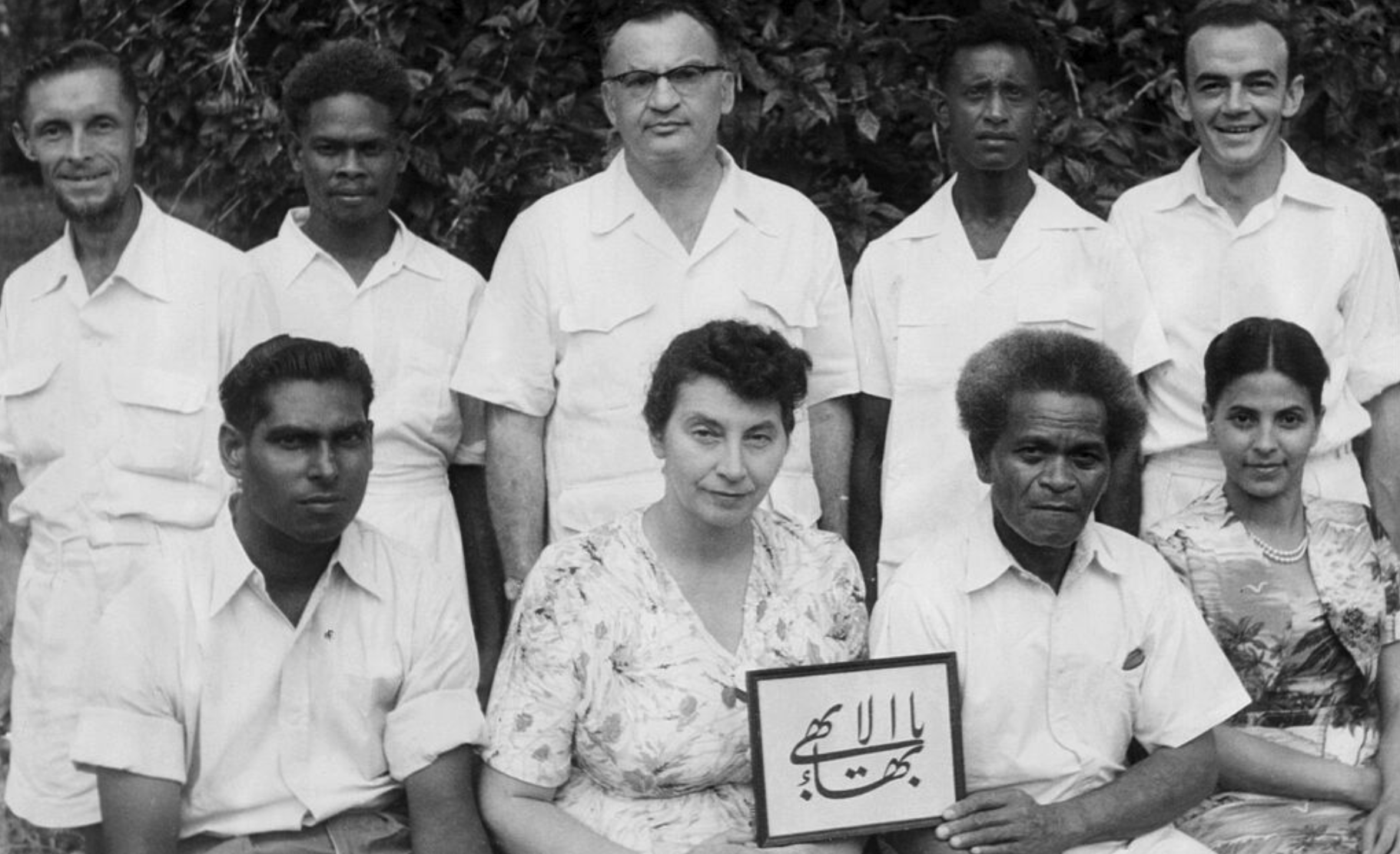
Under the leadership of Shoghi Effendi, by 1957, the Bahá'í Faith had spread to every corner of the globe, as witnessed by this photograph of the first Local Spiritual Assembly of First Honiara in the remote Solomon Islands, formed at Riḍván 1957, a few months before the Guardian’s passing. Source: Bahaimedia.
In 1921, the Bahá'í community was nothing more than a small band of scattered believers, spread out across the planet. In three decades, the Guardian turned them into a cohesive, united, worldwide community, focused on the same goals, and winning victories on a global scale.
A few heroic individuals arose immediately, at the very start of the Guardian’s ministry. Foremost among them was Martha Root, who circled the globe four times for her Guardian, and shared the Bahá'í message with Queen Marie of Romanian, the first royal to embrace the Bahá'í Faith.
As Shoghi Effendi began inaugurating his Teaching Plans—the First Seven Year Plan, the Second Seven Year Plan, the 12 National Teaching Plans—the Bahá'ís began to pioneer internationally, and the Faith began to grow exponentially.
By 1953, 32 years into Shoghi Effendi’s ministry, he inaugurated the Ten Year Crusade which he described as a “fate-laden, soul-stirring, decade-long, world-embracing Spiritual Crusade”. Through this campaign, the Bahá’ís throughout the world achieved astonishing results.
At the time of Bahá'u'lláh’s Ascension, only 15 countries had been opened to the Fait. Twenty-nine years later, at the time of the passing of 'Abdu'l-Bahá, another twenty countries had been opened to the Faith, bringing the total to 35.
By the time of Shoghi Effendi’s passing in 1957—36 years later—Bahá’ís were living in 219 new sovereign states, dependencies and major islands. By 1963, there were 56 National Spiritual Assemblies, more than 4,500 Local Spiritual Assemblies, and Bahá’ís living in more than 15,000 localities.
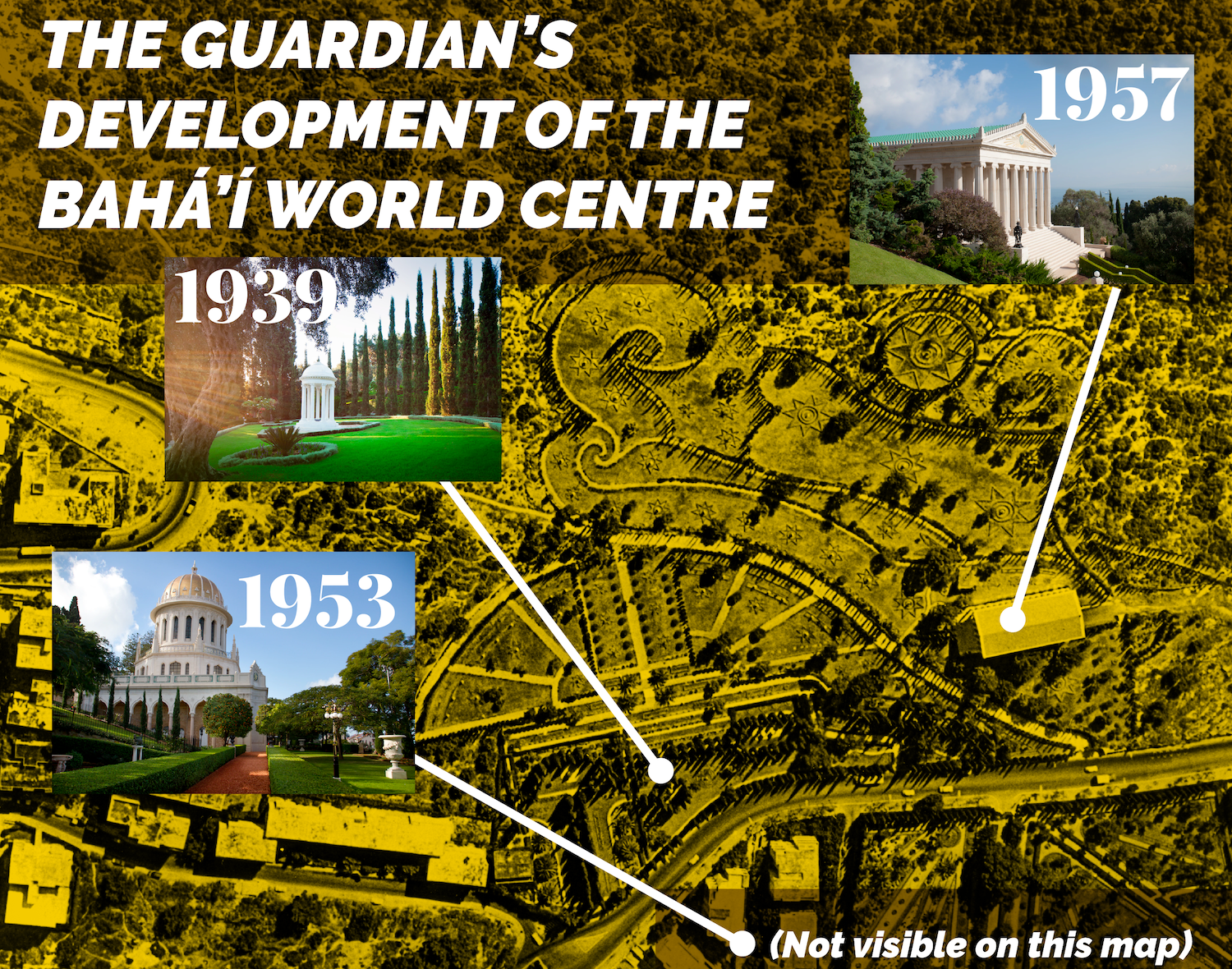
The three major developments at the Bahá'í World Centre during the Guardian’s ministry: The Monument Gardens in 1939, the superstructure of the Shrine of the Báb in 1953, and the first edifice on the arc, the International Bahá'í Archives in 1957. Photo of the Monument gardens from Bahá'í Media Bank, © Bahá'í International Community 2023, photo of the superstructure of the Shrine of the Báb from Bahá'í Media Bank, © Bahá'í International Community 2023, and photo of the International Bahá'í Archives from Bahá'í Media Bank, © Bahá'í International Community 2023. Background photo: aerial view of the Arc in the 1960s from Bahá'í Media Bank, © Bahá'í International Community 2023.
The Guardian paid attention to all aspects of the development of the Faith, and most particularly the development of the endowments of the Faith at the Bahá'í World Centre in the Holy Land. At the beginning of his ministry, he safeguarded the Shrine of Bahá'u'lláh which had fallen into the hands of the Covenant-breakers, which he also did for the Mansion of Bahjí. For the rest of his ministry, he would continue to beautify the Ḥaram-i-Aqdas, the Most Holy Precincts at Bahjí, around the Shrine of Bahá'u'lláh.
In 1939, the Guardian re-interred the remains of the mother and brother of 'Abdu'l-Bahá—Ásíyih Khánum and Mírzá Mihdí—in the Monument Gardens, in close proximity to the resting place of the Greatest Holy Leaf, 'Abdu'l-Bahá’s sister. The Monument Gardens were to be, according to Shoghi Effendi, the heart of the worldwide Bahá'í Administrative Order, whose seat, designated by Bahá'u'lláh in the Tablet of Carmel, was to be on that holy mountain.
Towards the end of his ministry, Shoghi Effendi began mapping out an “Arc” on Mount Carmel, around the Monument Gardens, and he built the first International Institution of the Bahá'í Faith on the arc, his last masterpiece, the International Bahá'í Archives.

This absolutely extraordinary night photograph of a most unusual angle on one of the corners of the Shrine of the Báb, the ringstone symbol towering over us, and the moonlight struggling to shed its light from behind the clouds, is perhaps the most powerful image of victory over crisis, resilience under persecution, and glory over oppressors. Photograph by Farzam Sabetian. Source: Luminous Spot: The Shrine of the Báb.
Winning splendid victories after overcoming devastating crises was the hallmark of Shoghi Effendi’s ministry—as it had been the hallmark of Bahá'u'lláh’s and 'Abdu'l-Bahá’s before him. The Head of the Faith, protected by the power of the Covenant was ultimately unassailable.
Bahá'ís suffered greatly during the ministry of the Guardian: the German Bahá’ís were persecuted under Nazi rule, Bahá’ís were arrested and interrogated in Turkey, the highly-developed community in ‘Ishqábád was persecuted by the Soviet authorities, Bahá'ís in Iran were martyred, the Most Great House of Bahá'u'lláh was taken from Bahá'ís, and they were never able to regain it.
With characteristic calm and perception, Shoghi Effendi saw the potential for triumph in every apparent crisis facing the Bahá’í: when the religious courts in Egypt delivered a series of judgments which seemed to go against the Bahá'ís best interest, Shoghi Effendi saw that judgment as a recognition of the independent nature of the Bahá’í Faith.
By the time of his passing, Shoghi Effendi had written 34,000 letters to the Bahá'ís of the world, and the community he had nurtured so loving for 36 years was so strong, so mature, so deepened that it would be able to sustain any crisis, and remain firm in the Covenant.
Any crisis, including the untimely passing of its beloved Guardian.
SOURCES FOR PART XX
16 February 1956: The Guardian’s teaching advice
Bahá’í Library Online: Haifa Notes, Gayle Woolson (16 February 1956), page 1.
Bahaipedia: Gayle Woolson.
Bahá’í Library Online: Pilgrim’s notes about Shoghi Effendi, Ramona Brown, published in Memories of ‘Abdu’l-Bahá: Recollections of the Early Days of the Bahá’ís of California, Wilmette, IL: Bahá’í Publishing Trust, (1980) page 115
Riḍván 1956: The achievements of Phase 2 of the Ten Year Crusade: So Significant a Victory
Messages to the Bahá’í World: 1950–1957, Shoghi Effendi, Bahá’í Publishing Trust, Wilmette, Illinois, 1971, pages 91-102.
Riḍván 1956: The Guardian’s words about the International Bahá’í Archives
Leroy Ioas: Hand of the Cause of God, Anita Ioas Chapman, George Ronald, 1998, page 244.
Messages to the Bahá’í World: 1950–1957, Shoghi Effendi, Bahá’í Publishing Trust, Wilmette, Illinois, 1971, pages 94-95.
The end of the Guardian’s Riḍván 1956 message
Messages to the Bahá’í World: 1950–1957, Shoghi Effendi, Bahá’í Publishing Trust, Wilmette, Illinois, 1971, pages 91-102.
Shoghi Effendi’s joys and sorrows at pioneering goals lost and won
“I’ll cross the other one off later”
REFERENCES FOR THE THREE PREVIOUS SECTIONS:
Leroy Ioas: Hand of the Cause of God. Anita Ioas Chapman, George Ronald, 1998, page 260-261.
The vision of Shoghi Effendi : Proceedings of the Association for Bahá’í Studies, Ninth Annual Conference, November 2-4, 1984, Ottawa, Canada, page 172.
In the Days of the Guardian: Transcript of a talk by Hand of the Cause of God Leroy Ioas, Johannesburg, South Africa, 1958.
1956: A pilgrim’s portrait of Shoghi Effendi
The Priceless Pearl, Rúḥíyyih Rabbání, Bahá’í Publishing Trust, London, 1969, pages 80-81.
After 28 November 1956: “I am tired, tired!”
The Priceless Pearl, Rúḥíyyih Rabbání, Bahá’í Publishing Trust, London, 1969, pages 80-81.
1955 – 1957: Leroy Ioas: “The invisible hand of God”
12 August 1955: The first shipment of Chiampo marble
REFERENCES FOR THE PREVIOUS TWO SECTIONS:
Leroy Ioas: Hand of the Cause of God, Anita Ioas Chapman, George Ronald, 1998, pages 240-241 and 244.
The Priceless Pearl, Rúḥíyyih Rabbání, Bahá’í Publishing Trust, London, 1969, pages 263-266.
Coronation on Carmel: The Story of the Shrine of the Báb Volume II: 1922-1963, Michael V. Day, George Ronald, 2018, pages 264-265.
Shoghi Effendi: Recollections, Ugo Giachery, George Ronald, 1973, page 162.
1955: Shoghi Effendi creates the garden for the Archives
Leroy Ioas: Hand of the Cause of God, Anita Ioas Chapman, George Ronald, 1998, page 242.
1955: The strain on Hand of the Cause Leroy Ioas
Leroy Ioas: Hand of the Cause of God, Anita Ioas Chapman, George Ronald, 1998, pages 242-243.
21 April 1955: The Guardian’s progress report on the Archives
Messages to the Bahá’í World: 1950–1957, Shoghi Effendi, Bahá’í Publishing Trust, Wilmette, Illinois, 1971, page 79.
Sua Eminenza’s Chiampo Paglierino marble
Leroy Ioas: Hand of the Cause of God, Anita Ioas Chapman, George Ronald, 1998, page 240.
The Bahá’í World Volume 12: The Completion of the International Bahá’í Archives, Amatul’Bahá Ruḥíyyíh Khánum, pages 418-419.
Cœnobium: Libraria Antiqua (Website in Italian): INDUSTRIA DEI MARMI VICENTINI. CHIAMPO, VICENZA (CATALOGO ANNI CINQUANTA).
The Bahá’í World Volume 12: The Completion of the International Bahá’í Archives, Amatul’Bahá Ruḥíyyíh Khánum.
Shoghi Effendi: Recollections, Ugo Giachery, George Ronald, 1973, pages 158-159.
The 16th-century-inspired wooden balustrades
Leroy Ioas: Hand of the Cause of God, Anita Ioas Chapman, George Ronald, 1998, pages 245-247.
The Bahá’í World Volume 12: The Completion of the International Bahá’í Archives, Amatul’Bahá Ruḥíyyíh Khánum.
Shoghi Effendi: Recollections, Ugo Giachery, George Ronald, 1973, page 158-159 and 164-165.
The vestibule door, floor, and ceiling
REFERENCES FOR THE PREVIOUS TWO STORIES:
Leroy Ioas: Hand of the Cause of God, Anita Ioas Chapman, George Ronald, 1998, pages 240-241 and 244.
The Priceless Pearl, Rúḥíyyih Rabbání, Bahá’í Publishing Trust, London, 1969, pages 263-266.
Coronation on Carmel: The Story of the Shrine of the Báb Volume II: 1922-1963, Michael V. Day, George Ronald, 2018, pages 264-265.
Shoghi Effendi: Recollections, Ugo Giachery, George Ronald, 1973, page 162-163, and 166-168.
The distinctive sea-green roof and tiles
Shoghi Effendi: Recollections, Ugo Giachery, George Ronald, 1973, pages 165-166.
Leroy Ioas: Hand of the Cause of God, Anita Ioas Chapman, George Ronald, 1998, pages 240-241 and 244.
The Priceless Pearl, Rúḥíyyih Rabbání, Bahá’í Publishing Trust, London, 1969, pages 263-266.
Coronation on Carmel: The Story of the Shrine of the Báb Vol. II: 1922-1963. Michael V. Day, George Ronald, 2018, pages 264-265.
Shoghi Effendi: Recollections, Ugo Giachery, George Ronald, 1973, page 162.
Leroy Ioas: Hand of the Cause of God, Anita Ioas Chapman, George Ronald, 1998, pages 240-241, 244, and 245-247.
The Bahá’í World Volume 12: The Completion of the International Bahá’í Archives, Amatul’Bahá Ruḥíyyíh Khánum. Leroy Ioas: Hand of the Cause of God, Anita Ioas Chapman, George Ronald, 1998, pages
Shoghi Effendi: Recollections, Ugo Giachery, George Ronald, 1973, page 163.
The door of the International Bahá’í Archives
Shoghi Effendi: Recollections, Ugo Giachery, George Ronald, 1973, page 162.
21 April 1957: The Guardian’s Riḍván announcement
Leroy Ioas: Hand of the Cause of God, Anita Ioas Chapman, George Ronald, 1998, page 245.
Messages to the Bahá’í World: 1950–1957, Shoghi Effendi, Bahá’í Publishing Trust, Wilmette, Illinois, 1971, page 108.
June 1957: Summary of the epic story of the construction of the International Bahá’í Archives
Shoghi Effendi: Recollections, Ugo Giachery, George Ronald, 1973, pages 167-168.
The Guardian’s builders and gardeners
Leroy Ioas: Hand of the Cause of God, Anita Ioas Chapman, George Ronald, 1998, pages 243-244.
The Bahá’í World Volume 12: The Completion of the International Bahá’í Archives, Amatul’Bahá Ruḥíyyíh Khánum, page 434.
Charles Dunning’s journey to the Holy Land
The Life and Times of Charles Dunning Knight of Bahá’u’lláh to the Orkney Islands, Dr. Keith Munro, Learmont Publishing, pages 199-200.
7 January 1957: Charles Dunning’s deeply perplexing arrival
The Life and Times of Charles Dunning Knight of Bahá’u’lláh to the Orkney Islands, Dr. Keith Munro, Learmont Publishing, page 203.
Transcript of: Amatul’Bahá Rúḥíyyih Khánum’s Address to the Sixth Annual Association for Bahá’í Studies Conference, Canada, 1981, Timestamp: 00:33:41.
Bahaipedia: Charles Dunning.
Recollections of Pilgrimage: Nine Days with the Guardian in 1957, Bill Washington, Chapter 4: First meeting with the Guardian.
Leroy Ioas: Hand of the Cause of God, Anita Ioas Chapman, George Ronald, 1998, pages 262-263.
7 January 1957: Culture etiquette vs. the Guardian’s spiritual etiquette
The Life and Times of Charles Dunning Knight of Bahá’u’lláh to the Orkney Islands, Dr. Keith Munro, Learmont Publishing, page 203.
Transcript of: Amatul’Bahá Rúḥíyyih Khánum’s Address to the Sixth Annual Association for Bahá’í Studies Conference, Canada, 1981, Timestamp: 00:33:41.
Bahaipedia: Charles Dunning.
Recollections of Pilgrimage: Nine Days with the Guardian in 1957, Bill Washington, Chapter 4: First meeting with the Guardian.
Leroy Ioas: Hand of the Cause of God, Anita Ioas Chapman, George Ronald, 1998, pages 262-263.
7 January 1957: Charles Dunning first dinner with the Guardian
The Life and Times of Charles Dunning Knight of Bahá’u’lláh to the Orkney Islands, Dr. Keith Munro, Learmont Publishing, pages 203-204.
Transcript of: Amatul’Bahá Rúḥíyyih Khánum’s Address to the Sixth Annual Association for Bahá’í Studies Conference, Canada, 1981, Timestamp: 00:33:41.
Bahaipedia: Charles Dunning.
Recollections of Pilgrimage: Nine Days with the Guardian in 1957, Bill Washington, Chapter 4: First meeting with the Guardian.
Leroy Ioas: Hand of the Cause of God, Anita Ioas Chapman, George Ronald, 1998, pages 262-263.
Shoghi Effendi and Charles Dunning’s cigarettes
The Life and Times of Charles Dunning Knight of Bahá’u’lláh to the Orkney Islands, Dr. Keith Munro, Learmont Publishing, pages 207-209.
Zoom video conversation with Dr. Keith Munro dated 4 December 2023.
The Life and Times of Charles Dunning Knight of Bahá’u’lláh to the Orkney Islands, Dr. Keith Munro, Learmont Publishing, page 209.
Charles Dunning’s pilgrimage experiences
The Life and Times of Charles Dunning Knight of Bahá’u’lláh to the Orkney Islands, Dr. Keith Munro, Learmont Publishing, page 205, 209-210 and 216-217.
Charles Dunning discovers the Roll of Honor and the Maps of the Ten Year Crusade
The Life and Times of Charles Dunning Knight of Bahá’u’lláh to the Orkney Islands, Dr. Keith Munro, Learmont Publishing, page 204.
Shoghi Effendi’s love for Charles Dunning
Transcript of: Amatul’Bahá Rúḥíyyih Khánum’s Address to the Sixth Annual Association for Bahá’í Studies Conference, Canada, 1981, Timestamp: 00:33:41.
Bahaipedia: Charles Dunning.
Recollections of Pilgrimage: Nine Days with the Guardian in 1957, Bill Washington, Chapter 4: First meeting with the Guardian.
Leroy Ioas: Hand of the Cause of God, Anita Ioas Chapman, George Ronald, 1998, pages 262-263.
Charles Dunning’s love for Shoghi Effendi
What Charles Dunning learned from the Guardian about teaching
REFERENCES FOR THE PREVIOUS TWO STORIES:
The Life and Times of Charles Dunning Knight of Bahá’u’lláh to the Orkney Islands, Dr. Keith Munro, Learmont Publishing, pages 222-224.
January 1957: The pilgrimage of ‘Alí Nakhjávání
YouTube: Stories about the Guardian by ‘Alí Nakhjávání, Timestamp 00:01:01.
3 – 13 February 1957: The pilgrimage of Enoch Olinga
Enoch Olinga: Hand of the Cause Of God: The memorial article by Rúḥíyyih Rabbání with the reminiscences of Rowshan Mustapha, Bahá’í Publishing Agency, Kenya, Nairobi, 2001, pages 20-23.
Bahá’í Library Online: Memorandum from the Research Department of the Universal House of Justice, 11 December 1994.
25 March 1957: “Fearless Defender”: The passing of Hand of the Cause George Townshend
The Bahá’í World Volume 13: In Memoriam: George Townshend.
Bahaipedia: George Townshend.
Wikipedia: George Townshend (Bahá’í).
Citadel of Faith, Shoghi Effendi, 27 March 1957.
A list of the victories of the Ten Year Crusade by Riḍván 1957
The end of the Guardian’s 1957 Riḍván Message
REFERENCES FOR THE PREVIOUS THREE STORIES:
Messages to the Bahá’í World: 1950–1957, Shoghi Effendi, Bahá’í Publishing Trust, Wilmette, Illinois, 1971, page 102-120.
21 April 1957: One thousand telegrams
Bahá’í Library Online: Notes on Pilgrimage to Haifa, 15 – 23 April 1957, Alice Dudley.
19 – 28 April 1957: Isobel and Ḥasan Sabri’s pilgrimage
Pilgrim notes recorded after the nightly dinner-table talks of the beloved Guardian, Shoghi Effendi 19–28 April 1957, Isobel Sabri.
Bahaipedia: Isobel Sabri.
28 April 1957: The plaster from the Báb’s prison cell in Máh-Kú
Pilgrim notes recorded after the nightly dinner-table talks of the beloved Guardian, Shoghi Effendi 19–28 April 1957, Isobel Sabri.
Bahaipedia: Isobel Sabri.
4 June 1957: The function of Protection of the institution of the Hands of the Cause
The Priceless Pearl, Rúḥíyyih Rabbání, Bahá’í Publishing Trust, London, 1969, pages 257-258.
Messages to the Bahá’í World: 1950–1957, Shoghi Effendi, Bahá’í Publishing Trust, Wilmette, Illinois, 1971, Cablegram dated 4 June 1957, pages 122-123.
8 August 1957: The Guardian’s letter to an African Regional Assembly on stages of maturity
REFERENCES FOR THE PREVIOUS TWO STORIES:
The Priceless Pearl, Rúḥíyyih Rabbání, Bahá’í Publishing Trust, London, 1969, pages 324-324.
12 August 1957: The National Bahá’í center for Switzerland
The Priceless Pearl, Rúḥíyyih Rabbání, Bahá’í Publishing Trust, London, 1969, pages 134-135.
14 August 1957: “God will…watch over them”: One of the Guardian’s last letters
The Priceless Pearl, Rúḥíyyih Rabbání, Bahá’í Publishing Trust, London, 1969, pages 193-194.
The Light of Divine Guidance: The Messages from the Guardian of the Bahá’í Faith to the Baha’i’s of Germany and Austria.
Shoghi Effendi, Hotheim-Langenhaim Bahá’í-Verlag, 1982, Number 206, Letter dated 14 August 1957.
Compilation: Teaching Aboriginal and Indigenous People, Letter from Shoghi Effendi dated 9 July 1957 written on behalf of Shoghi Effendi to the National Spiritual Assembly of South and West Africa, Excerpt 359 in the compilation.
The 1958 Intercontinental Teaching Conferences
The Priceless Pearl, Rúḥíyyih Rabbání, Bahá’í Publishing Trust, London, 1969, pages 258 and 441-443.
The Bahá’í World Volume 13, pages 314-315.
The last achievements of the Ten Year Crusade before the passing of Shoghi Effendi
Messages to the Bahá’í World: 1950–1957, Shoghi Effendi, Bahá’í Publishing Trust, Wilmette, Illinois, 1971, pages 91-102 (Riḍván Message 1956: “So Significant a Victory”), pages 102-120 (Riḍván Message 1957: “Evidences of the Resistless March of the World Crusade”), and pages 120-123 (October 1957 : “Epoch-Making Victory Won Over Covenant-Breakers”).
Bahá’í Library Online. chronology: Siyah-Chal (The Black Pit).
Bahá’í Library Online chronology: International Bahá’í Archives.
Bahá’í Library Online chronology: Bahji.
The inauguration of the Auxiliary Board for Protection
2 October 1957: The Guardian appoints a third contingent of Hands of the Cause
The last eight Hands of the Cause appointed by the Guardian
The Priceless Pearl, Rúḥíyyih Rabbání, Bahá’í Publishing Trust, London, 1969, pages 253-255.
Messages to the Bahá’í World: 1950–1957, Shoghi Effendi, Bahá’í Publishing Trust, Wilmette, Illinois, 1971, Message of 2 October 1957: Announcement of Series of Five Intercontinental Conferences and Appointment of Eight Additional Hands of the Cause, pages 124-131.
Ministry of the Custodians, The, 1957–1963: An Account of the Stewardship of the Hands of the Cause. The Universal House of Justice, Bahá’í World Centre, Haifa, 1992, page xxiii.
The Guardian’s last gesture of love to the Bahá’ís
The Priceless Pearl, Rúḥíyyih Rabbání, Bahá’í Publishing Trust, London, 1969, pages 258 and 441-443.
The Bahá’í World Volume 13, pages 314-315.
29 May 1892 – 11 May 1957: The stain of the Covenant-breakers
11 May 1956: The expropriation application
8 May 1957: The Supreme Court of Israel rules in favor of the Bahá’ís
3 June 1957: The Guardian’s triumphant message
The Guardian’s plans for demolition
6 September 1957: The expropriation order is enacted
REFERENCES FOR THE PREVIOUS SIX STORIES:
The Priceless Pearl, Rúḥíyyih Rabbání, Bahá’í Publishing Trust, London, 1969, pages 233-234.
Shoghi Effendi: Recollections, Ugo Giachery, George Ronald, 1973, page 125
Shoghi Effendi Through the Pilgrim’s Eye, Volume 2 The Ten Year Crusade, 1953-1963. Earl Redman, George Ronald, Oxford, 2016, Kindle Edition, Location 4107.
Messages to the Bahá’í World: 1950–1957, Shoghi Effendi, Bahá’í Publishing Trust, Wilmette, Illinois, 1971, Cable from Shoghi Effendi dated 3 June 19567: Epoch-Making Victory Won Over Covenant-Breakers, page 120-122.
Leroy Ioas: Hand of the Cause of God, Anita Ioas Chapman, George Ronald, 1998, pages 194-197.
A Bahá’í Glossary: Ḥaram-i-Aqdas.
Wikipedia: Reshumot.
29 April 1953: The first dependency of the Mother Temple of North America
The Priceless Pearl, Rúhíyyih Rabbání, Bahá’í Publishing Trust, London, 1969, pages 435-436.
The Bahá’í World, Volume 13, pages 743-748.
Bahá’í Administration, Shoghi Effendi, Letter of 25 October 1929.
Citadel of Faith, Shoghi Effendi, Letter of April 29, 1953, Forty-Fifth Annual Convention: U.S. Tasks in World Crusade.
1956: The Guardian’s unflinching standards of beauty and dignity for the Mother Temples of the world
The Priceless Pearl, Rúḥíyyih Rabbání, Bahá’í Publishing Trust, London, 1969, pages 359-360.
Lights of Divine Guidance Volume 1, page 261: Letter of 21 June 1956 to the National Spiritual Assembly of Germany and Austria.
Unfolding Destiny, Shoghi Effendi, page 367: Letter of 11 July 1956 to the National Spiritual Assembly of the British Isles
October 1957: Shoghi Effendi and the Mother Temple of the Pacific
The Priceless Pearl, Rúḥíyyih Rabbání, Bahá’í Publishing Trust, London, 1969, page 434.
Messages to the Bahá’í World: 1950–1957, Shoghi Effendi, Bahá’í Publishing Trust, Wilmette, Illinois, 1971, July 1953 Message to the Asian Intercontinental Conference, New Delhi, India, October 7-15, 1953, pages 163-169.
The Bahá’í World, Volume 13, pages 721-732.
Messages to the Antipodes (Australasia), Shoghi Effendi, Mona Vale: Bahá’í Publications Australia, 1997, Message of 30 April 1953 to the National Convention.
29 October 1957: Shoghi Effendi and the House of Worship for the European Continent
The Priceless Pearl, Rúḥíyyih Rabbání, Bahá’í Publishing Trust, London, 1969, page 434.
Messages to the Bahá’í World: 1950–1957, Shoghi Effendi, Bahá’í Publishing Trust, Wilmette, Illinois, 1971, July 1953 Message to the Asian Intercontinental Conference, New Delhi, India, October 7-15, 1953, pages 163-169.
The Bahá’í World, Volume 13, pages 721-732.
Messages to the Antipodes (Australasia), Shoghi Effendi, Mona Vale: Bahá’í Publications Australia, 1997, Message of 30 April 1953 to the National Convention.
31 October 1957: Shoghi Effendi and the Mother Temple of Africa
The Priceless Pearl, Rúḥíyyih Rabbání, Bahá’í Publishing Trust, London, 1969, pages 433-434.
Messages to the Bahá’í World: 1950–1957, Shoghi Effendi, Bahá’í Publishing Trust, Wilmette, Illinois, 1971, 25 June 25, 1953, Message to the European Intercontinental Conference, Stockholm, Sweden, July 21-26, 1953, pages 157-163.
The Bahá’í World, Volume 13, pages 733-743.
The Bahá’í World, Volume 14, pages 483-484.
1952 – 1957: An overview of the growth of the Faith in Africa during the Guardian’s ministry
1953 – 1957: The Guardian praises the African continent
“The Guardian becomes very happy”
REFERENCES FOR THE PREVIOUS THREE STORIES:
The Priceless Pearl, Rúḥíyyih Rabbání, Bahá’í Publishing Trust, London, 1969, pages 395 and 414-415, 432.
Bahá’í Library Online: The Promising Continent: Selections from the Writings of ‘Abdu’l-Bahá, the Writings and Letters of Shoghi Effendi, and the Letters Written on His Behalf to Africa. The National Spiritual Assembly of the Bahá’ís of South Africa, Johannesburg, 1998.
Shoghi Effendi’s victories in Africa
Transcript: The Guardian of the Bahá’í Faith, 21 June 1970, Amatul’Bahá Rúḥíyyih Khánum, transcript from a cassette tape published by the Bahá’í Publishing Trust, Timestamp: 40:37.
Transcript of: Amatul’Bahá Rúḥíyyih Khánum’s talk with pioneers in Petionville, Haiti, 20 November 1981, Timestamp: 00: 27:18.
Two email communications with Bahíyyih Nakhjávání dated 3 December 2023 confirming the efforts of ‘Alí Nakhjávání in the mass conversions in Teso, Uganda.
Shoghi Effendi’s accomplishments by November 1957
The Priceless Pearl, Rúhíyyih Rabbání, Bahá’í Publishing Trust, London, 1969, pages 444 and 451.
Hartz, Paula (2009). World Religions: Baha’i Faith (3rd ed.). New York, NY: Chelsea House Publishers, pages 78-85.
Wikipedia: Shoghi Effendi.
Bahá’í Library Online: Achievements and Victories of the Guardianship: Statistics, chronology, and bibliography, Owen Battrick (1982).
Messages to the Bahá’í World: 1950–1957, Shoghi Effendi, Bahá’í Publishing Trust, Wilmette, Illinois, 1971, pages 105-106.
Shoghi Effendi’s six unique concepts
Shoghi Effendi: The Range and Power of His Pen, ‘Alí Nakhjávání, Acuto 2006, Casa Editrice Bahá’í, pages 295-296.
Pilgrim notes recorded after the nightly dinner-table talks of the beloved Guardian, Shoghi Effendi 19–28 April 1957, Isobel Sabri.
Bahá’í Library Online: Pilgrims Notes, Marguerite R. Sears (1953).
The vision of Shoghi Effendi : proceedings of the Association for Bahá’í Studies, Ninth Annual Conference, November 2-4, 1984, Ottawa, Canada, Pages 173-174.
The Guardian and the Formative Age of the Bahá’í Faith
Building the Bahá’í Administrative Order
The expansion of the worldwide Bahá’í Community
The Bahá’í Faith: The official website of the worldwide Bahá’í community: The Life and Work of Shoghi Effendi.
![]()




























